
- New Hamphshire
- Add Your School
- Start a Private School
- Free Resources
- Articles & Resources

Business Plan & Budget
Documenting your vision.
A business plan is an essential part of the planning process, helping identify goals and metrics and your plan to achieve them.
- Starting with your objectives
- Business plan vs. a budget
- Business plan types
- Creating your business plan
- Creating your budget
Planning for Your New School
Your business plan and budget are important tools for two reasons:
First, before you invest your time, energy and money in opening a school, it is important that you have a plan for yourself that you can believe in. Opening any business is hard work and carries risk - schools are no exception! Having a plan can allow you to move forward with confidence.
Second, your plan can be helpful to help others understand how you expect to turn you vision from dream to reality. From recruiting staff to recruiting financial backing, a solid plan allows you to build confidence in others, too.
In this section we look at the fundamentals for school business plans and budgets, and how these are derived from your vision and objectives.
Software That Simplifies & Empowers Your School
Attract students, satisfy parents, and grow your school! With Twine, we keep the administration easy so you can focus on other things.
Parent Communications
Informed parents become engaged parents and engaged parents can supercharge your school.
Websites & Admissions
A high-impact website attracts students while Twine makes admissions easy.
School Management
Twine makes it easy for teachers and administrators to do everything they need to do.
Online Classrooms
Educate, collaborate, and discuss with integrated online classrooms powered by Twine.
Every School Needs Great Software
Twine helps schools simplify their administration, automate scheduling/staffing, and lesson the load placed on teachers and administrative staff. Twine also helps with enrollment, marketing, and more. See what Twine can do:
Websites & Admissions
Starting with your objectives.

As Lewis Carroll so playfully points out: you need to first know where you want to go, and then you can build a plan to get there.
If you’ve not already started with the work outlined in the school identity section of this guide, now is a great time to review the topics on core values and mission. Once your core values and mission are clear, you can begin to set objectives by examining questions such as:
Who are the students and families you want to serve? There are any number of ways you might think about this: are you intending to provide services for an underserved population or a group with particular needs that aren’t being met in your community? Are you wanting to bring together families with a common interest or ideology, whether that is an academic focus, religious conviction, academic philosophy, or opportunity for particular experiences?
What is the ideal size for your program? Even knowing you won’t get there right away, do you ultimately want to remain a small community of 18 or 24, or does your objective require a population of 300 or 500 or 1000 students to support the diversity of programming, staff expertise and varies programs you’d like to offer?
What role do you want to create for yourself? This can be a particularly tricky question, but it is crucial to step back and consider as part of your plan. If your first love is working in the classroom, you should have a plan that allows you classroom time. That may mean splitting time between administrative tasks and a small class workload, or it could mean having a large enough enrollment to bring in a full-time administrator. If you are excited by strategy and operations, and enjoy building a team, recruiting parents, and overseeing the day-to-day running of the school, keep yourself in an administrative role. There are dozens of roles you might choose to play: why not use this opportunity to ensure you put yourself in your dream job?
Once you’ve worked through your objectives (and written them down!) you’re ready to move on and begin planning.
Business Plan vs. Budget
A common misconception is that a well-defined and detailed budget is essentially the same as a business plan. While a solid budget is an important component of a business plan, a true business plan looks beyond just the projected income and expenses to answer questions about both strategy and tactics.
The Role of a Business Plan
Business plans can seem daunting if you’ve never had to write one before. It is a must-have document, though, as it serves as a road map for your new school. Although there are many things that are going to be a part of the business plan, it is there to explain what you hope to accomplish with your school and how you are going to accomplish it. Additionally, business plans serve as important documentation for financial institutions or investors to see whether your school is worth investing in.
The Role of a Budget
Budgets, on the other hand, are primarily internal documents you’ll use to track your income and expenses and determine where your spending should take place. If you need new textbooks or want to give someone a raise, your budget will guide you through your decisions and help you determine if you have the money to do so, or what you need to accomplish to make it happen.
Business Plan Types
Creating a business plan can take time, but the good thing is that they tend to follow a consistent format – so you can basically work from a template to create yours. There are two common approaches used today:
Traditional "Full" Business Plan
A traditional, full business plan tends to be comprehensive and detailed. Creation of a full business plan can be time consuming but going through the process will help identify areas of planning that you may not have considered, and the resulting plan should provide sufficient details to be used when talking with banks or investors. For full business plans, the US Small Business Administration has a great step-by-step guide that walks you through each section of your business plan, along with some examples to look at.
Start-Up "Lean" Business Plan
An alternate approach is the lean start-up plan, which is faster to write and focuses more on high-level plans and a few key elements. Lean plans can be a good place to start, with the assumption you will update and revise the plan frequently. Particularly if soliciting funding, you may require additional time and detail later. Tim Berry, one of the leading experts on lean business plans, provides a good overview in his What's a Lean Business Plan article.
Creating Your Business Plan
There are lots of options for online business plan templates and most share a lot of common characteristics. There’s nothing wrong with picking one based on personal taste. Any of the following are excellent options as a starting point:
growthink (non-profit business plans)
Rocket Lawyer
My Own Business Institute
InvoiceBerry
US Small Business Administration
That there are many internet-based companies that offer business plan writing or editing, specifically. Here are just a few that you might want to check out:
Cayenne Consulting
Go Business Plans
Wise Business Plans
Many of the same companies that provide the business plan templates we highlighted are business consultants, not just business plan writers. Consultants can help you in your overall plans, particularly in areas where you may need guidance.
Professional organizations and associations for private schools, as well as your local chamber of commerce are also great resources for finding business consultants to assist you in creating your business plan and beyond.
Creating Your Budget
Understanding your costs.
The costs you’ll incur as a new school are really dependent on the choices you make in facilities and staffing. You’ll find a lot of useful information in those sections of this guide and they will help you get a clearer picture of the various expenses you’re going to face as you open up your school.
One of the great things about a budget is that, as long as you can easily read and understand it, the format isn’t going to make or break you. That said, staying organized and keeping track of everything takes a good system. One of the most popular methods is using a spreadsheet or system of spreadsheets to plan your income and expenses. Smartsheet has an excellent business budget template that you can modify to meet the needs of your school.
Once you are up and running, insight into actual income and expenses can be generated by your accounting software. Some accounting packages include budgeting tools as well, easing the work of comparing your plan to your actual numbers.
Tools to Assist With Budget Creation
Several excellent resources exist that can help you develop a budget, including:
The American Association of School Administrators has put together a School Budgets 101 document that outlines common expenses and budgetary considerations for schools
The Guardian published A beginner's guide to planning and managing school budgets in 2016, which explains several important budgeting principals.
Helping Educators Do the Work That Matters

Guide Quick-Nav

Introduction
We’ve developed these 10 topics to help you along the way. Take them all in at once, or start with the areas most relevant right now.

School Identity
There’s plenty you can do to develop your own brand, starting right from your personal ideals and goals for your school.

Our curriculum pages include ideas on where to go to find materials, and different associations and educational models you may want to consider.

Legal & Operating Requirements
You need to know the requirements at both the federal level and for your state. Here are the basic details for every state.

Funding & Finance
Here we share ideas for possible funding sources, and ways you might be able to start with less than you thought necessary.

Having a plan for how you’ll operate and a budget to predict and allocate funds is critical for all businesses, schools included. We’ve pulled together resources here to help with both.

What facilities are right for your school? We encourage new schools to get creative, and have compiled some considerations to take into account.

How can you find and recruit the right talent for your school? What qualifications or certifications are required?

Policies & Procedures
Thinking about more than just a student handbook and conduct code, we've included recommendations & templates to help you develop your school policies & procedures

Marketing & Online Presence

Associations

Opening a New School Checklist: A Comprehensive Guide

Opening a new school is an exciting and ambitious endeavor that requires careful planning and preparation.
Whether you are an educator, an entrepreneur, or a community leader, establishing a new educational institution involves a myriad of tasks that must be executed efficiently. To ensure a successful launch and a smooth start, it is crucial to have a comprehensive checklist in place.
In this blog post, we will guide you through the essential steps and considerations to include in your opening a new school checklist .
Opening New School: The Checklist
Establish a vision and mission.
Before diving into the logistical aspects, it is vital to define the vision and mission of your new school. Clearly articulate your educational philosophy, goals, and values.
This foundation will guide your decision-making process throughout the establishment and operation of the school.
Conduct Feasibility Studies
Conducting feasibility studies is an integral part of the planning phase. Evaluate the need for a new school in your target area, analyze the demographics and potential student enrollment, and assess the local competition.
This data will help you make informed decisions about location, curriculum, and other aspects of your school.
Develop a Business Plan
Create a comprehensive business plan that outlines your financial projections, marketing strategies, operational procedures, and staffing requirements.
A well-developed business plan is crucial for securing funding, attracting investors, and demonstrating the viability of your school.
Secure Funding
Identify potential sources of funding, such as grants, loans, or partnerships with investors. Explore government funding options, private foundations, and community sponsorships.
Establish a detailed budget that accounts for all expenses, including infrastructure, staffing, curriculum development, and marketing.
Obtain Legal and Regulatory Approvals
Comply with all legal and regulatory requirements for establishing a school in your jurisdiction. Research the necessary permits, licenses, and certifications.
Familiarize yourself with local education laws and regulations, zoning requirements, health and safety codes, and any other relevant legal obligations.
Recruit Qualified Staff
Hiring a competent and dedicated team of educators and administrative staff is essential for a successful school. Develop job descriptions, conduct thorough interviews, and check references.
Ensure that your staff members align with your school’s vision and possess the necessary qualifications and experience.
Design the Curriculum
Create a comprehensive curriculum that aligns with your school’s educational philosophy and goals. Develop curriculum frameworks, establish learning objectives, and plan assessments and evaluations.
Consider hiring curriculum experts or consultants to assist in this process.
Design and Furnish Facilities
Select an appropriate location for your school, considering factors such as accessibility, safety, and proximity to target students.
Work with architects and contractors to design and construct the necessary facilities. Furnish classrooms, administrative areas, libraries, and other essential spaces with appropriate equipment and resources.
Develop Policies and Procedures
Draft and implement a set of policies and procedures that cover various aspects of school operations, including admissions, student conduct, discipline, health and safety, and financial management.
Ensure that these policies comply with local regulations and reflect your school’s values and mission.
Market and Advertise
Develop a comprehensive marketing and advertising strategy to promote your school and attract prospective students and parents.
Utilize various channels, such as social media, local newspapers, community events, and open houses, to showcase your school’s unique offerings.
Prepare for Opening Day
Plan a well-organized opening day that creates a positive first impression. Arrange orientation programs for students and parents, establish communication channels, and ensure that all necessary resources and materials are readily available.
Final Words
Opening a new school is a challenging and rewarding endeavor that requires meticulous planning and execution. By following this comprehensive checklist, you can streamline the process and ensure a successful launch.
Remember, a clear vision, thorough research, and attention to detail are crucial for establishing a school that provides quality education and positively impacts the community it serves.
Good luck on your journey of opening a new school!

Parent-Teacher Partnerships: Nurturing Collaboration for Student Success

How to Start a Private School? – A Complete Guide

What is School Visitor Management System?

Does offline school management software work? – Complete Guide
Leave a reply cancel reply.
Save my name, email, and website in this browser for the next time I comment.
SkoolSheet is a cloud-based School Management Software platform that helps you manage your school, students, and other resources in an easy and effective manner.
- Video Tutorial
- Affiliate Program
- Privacy Policy
- Refund Policy

All Formats
- How to Write a Business Plan for Starting a School – 6 Steps
Every kind of business, regardless of its size, needs thorough planning to ensure success in the long run. According to research stated in BPlans.com, some 11,046 companies had excellent business performance due to extensive planning. Another study also found on the same site shows that businesses that do thorough planning grow 30% faster than others that don’t. As you can see, planning is indeed an essential element in running a business.
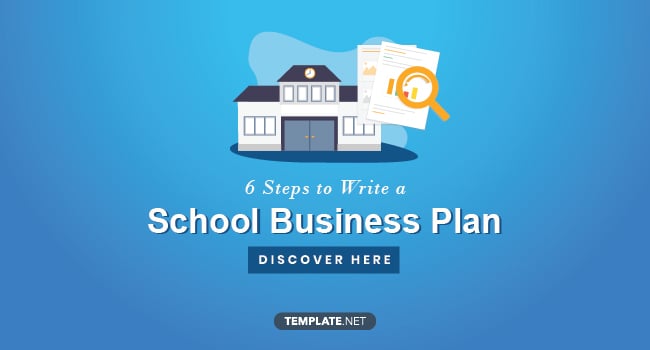
Download this Free How to Write a Business Plan for Starting a School - 6 Steps Article in PDF
Start with the executive summary, state your vision and goals, integrate your market analysis, talk about your school’s possible locations, elaborate on your financial strategies, explain your action plan in detail, more in school, business plan layout template, business plan startup template, printable business plan template, simple business plan template, blank business plan template, business plan financial template, restaurant business plan template, marketing business plan template, executive summary template, business plan guidelines template.
- 6 Reasons Why Risk Management Is Important in Schools
- How to Choose the Right Name for Your School [Templates + Examples] 2023
- 6 Brilliant Ways to Increase Your School’s Revenue
- 6 Good Reasons Why Your School Needs a Website
- 7 Useful Steps to Build Your School Brand
- 7 Best Practices for a Better School Improvement Planning
- Improving Your School Admission Strategy – 7 Useful and Simple Ways
- How to Improve Parent-Teacher Communication – 7 Tips
- How to Find and Hire the Best Educators for Your School – 8 Strategies
- 6 School Development Ideas
- 6 Challenges Faced by School Management – How to Overcome Them
- 6 Tips to Get Your School Funded
- Convincing Parents for School Admission – 5 Ways
- How to Manage Staff at School – 8 Tips and Strategies
File Formats
Word templates, google docs templates, excel templates, powerpoint templates, google sheets templates, google slides templates, pdf templates, publisher templates, psd templates, indesign templates, illustrator templates, pages templates, keynote templates, numbers templates, outlook templates.
How To Start A School in 2024 Step-by-Step Guide
by Cindy Lumpkin | How to Start a School , Learning

How to Start a Private School

Are you a teacher who is interested in how to start a private school ? Maybe you are a parent or religious group who feels your community needs more options.
If so, you are not alone.
As you are aware, teachers are leaving the field of education like wildfire. But many of them don’t want to quit teaching .
Instead of abandoning their passion for teaching, some educators are discovering that they can still do what they love—teach—by starting their own schools and educational businesses.
How do I know? Because I did just that, I started a small private school . I didn’t have a lot of money and no big names were backing me.
I discovered that I could still do what I love and, at the same time, avoid what I hated about the school system: bureaucracy, red tape, testing, and stress .
It came as a total shock when thousands of people- teachers, and a few parents, found a Youtube video I did explaining how I started my own school .
They couldn’t believe that a teacher, like them, with little funds and resources, started a school that was fully accredited.
Many of them also asked me if I could share with them how I started my own school.
In this article, I will do just that- step by step.
I will share the exact things you will need to do in order to start your own school and put you in the BEST position to be successful.
Most information on starting a school will say that it’s a lengthy, expensive, and complicated process. My experience was different.
I wouldn’t say it’s easy. It is work! This will be an investment of your time, money, and faith. But it’s totally doable and I want to help you on your journey.
If you have this limiting belief, put it to rest now. This doesn’t have to be a super expensive proposition, depending on your strategy and how you decide to scale.
I am going to take you step-by-step through what you have to do to start the process of starting a school.
Please keep in mind, however, that some things will differ by state and you will have to do research on your own in those instances.
Before you start, take the time to watch the video below. I want you to know why I am giving all this information away…for FREE and why I charge for some products.
Make no mistake about it—this isn’t some bait and switch. Following these steps will help you create the school business of your dreams and you DON’T have to buy anything.
Nevertheless, teachers and others who are ready to take action will eagerly invest because it will save them so much time.
When you purchase any of my products, you are paying for convenience.
I couldn’t dare charge for the process because I believe in this movement for every teacher who has been burned out by an unrealistic, outdated school system and for every child who has not benefited from the promise of “No Child Left Behind.”
In addition, this 12-step process that I’ve designed can be used by anyone who wants to open micro-schools, nonaccredited schools, learning pods, and even homeschools.
It will also help with online school programs.
Just know that depending on what your vision is, some things may or may not need to be done.
This will be a very long article. So I’ve included the steps up front and each step is clickable so that you can find your place more easily.
12 Steps on How to Start a School of Your Dreams
There are twelve steps to take to start a school; however, there are only eleven if you’re not going to get accredited. Here is a complete list:
- Find Community
- Determine Type of School
- Create An Advisory Board
- Design Your School’s Curriculum
- Requirements To Open A School (Legal/Operational)
- Develop A Fundraising Strategy
- Create Your Budget And Business Plan
- Address Your Staffing Needs
- Select The Right Facility To Start Your School
- Develop Your School’s Policies and Procedures
- Select an Accrediting Body (Optional)
- Develop a Marketing Plan
As you go through these steps, some will be accompanied by a video. Other times I may point you to another source or even share documents with you.
As I mentioned above, I may even offer some resources at a small price to take the load off you. However, they are optional and only designed to help you along.
You can totally do this without buying anything from me.
It would benefit you to watch these videos, however, as they will give more details where writing will not be able to communicate everything.
Before we get started, let me address this search term that I’ve seen way too much.
How To Start A School Without Money
Although there are some strategies you can take to start a school that will not require a lot of funds, one can’t expect to start a school without any money.
Your school is a business. Any serious entrepreneur knows that there will be some type of startup investment cost, even if it’s just for basic business management tools .
However, many of the steps above can be completed without spending anything.
So, if you are serious, you can start the process to ensure it’s truly something you want to do before making a considerable investment of money.
There will come a time, however, when you will have to make investments.
If you are someone who is low on funds, I suggest going through all the steps and completing as much as you can.
Next, I highly suggest that you watch this video to understand and determine where you are in the process of being ready to start a school business.
Now you are ready. Let’s jump in!
How To Start A School Business
Step 1. find community .
If you truly are determined that you are all in on this process, the first thing I suggest you do is find other people who are taking this journey.
This is my number-one piece of advice. Still, many will ignore it. Please don’t let it be you. This journey can be so lonely.
It doesn’t matter if they are across town or out of state. But it is vitally important for several reasons:
- It provides support. Trust me you will encounter moments of discouragement. Having a community will help you fight feelings of hopelessness that may come on this journey. It can also help celebrate those small victories. It’s one thing to have support from family and friends, but it’s another thing to have it from people who know and understand.
- It provides connection and belonging. Togetherness is so critical to our experience as humans. Connecting with others who share some of our values, interests, and worldviews helps us understand we are not alone.
- It provides an opportunity for us to share, give back, and learn from one another. Let’s face it, teachers are some of the most giving people there are. It’s in us to want to give back. I believe it’s an innate desire. There is so much I am still learning from the many teachers in our Teacher School Builders Community . For example, people are often finding new, easier, and less expensive ways to do so many things as it relates to creating and running private schools. I can’t possibly keep on top of all the changes. But I come close because of connections who share their ideals.
Don’t underestimate the importance of finding a crew who understands and who can speak to you wherever you are.
The networking opportunities among you will prove to be invaluable. Besides, if you have questions about these steps, you can find me in Teacher School Builders (wink).
I wish I could give you an open invitation to our community. We want to be a safe place for serious, committed, and passionate people interested in taking this journey together.
Only those who invest in any of my products will be invited to join our community. However, you are totally welcome to sign up for my newsletter .
I’ve been known to give out freebies to those who read and keep up-to-date with my emails. Also, I still give LOTS of helpful resources and value to my list.
Step 2 . Determine what type of school you want.
This step is twofold. I don’t want to assume that we are on the same page, knowing what type of school I am trying to position you to start. Therefore, let me make it clear.
Ideally, one can start a charter school. This is NOT the type of school I help teachers create.
A charter school is a HUGE undertaking. In addition, it’s expensive and, in some situations, will need to be approved by your local school board. The application is ridiculous too.
We are not even building your typical, well-established, rooted-in-money private school. (It could for sure turn into one.)
Although what I am helping you to create is technically a private school , you most likely are a one- or two-man team.
Right now, you may not have a lot of resources, but your business structure will be that of a private school. We will talk more about your business structure later.
Thus, for many of you, it will be a micro-school. In other words, a small school that serves generally 5 and upwards of 150 students.
It can be religious or non-religious. Some of you will want a for-profit, while others will choose to start a non-profit. Some of you will take the extra step to become accredited.
If you want to call it a learning pod or homeschool, so be it.
I encourage you to watch this video if you haven’t already. It talks about this more in context. (This video has been on my channel for a while, so you may have seen it.)
Now that we are on the same page, what type of school do you envision? Will it be K–12? How about a middle school or high school only? Who will you serve?
Plan With The End In Mind
This is the fun part! I am a dreamer and I hope you are too.
This is where you get to dream up the best school you can imagine to serve your ideal student(s) well.
Maybe you want a day school or virtual program. Is your vision a Montessori or a specialized school for students with learning differences?
It’s ok, create your ideal school on paper. Dream big!
Your vision may be to one day operate a K-12 program, but you may start off with either elementary, middle, or high.
You may even start with K-12 in a more modern one-room schoolhouse concept.
The possibilities are endless.
I would start with the end from the beginning here. However, actual implementation may be in stages. Again, dream big on paper.
Just know that it’s better to actually start a small school business and grow into your long-range vision of your school.
The cool part about this is that you are the architect.
I totally went against the grain and started with high school first. However, I knew from the beginning that I would work with 3rd-12th by the time my dream was fully realized.
Within about two years, I worked my way down to middle school. Eventually, I will start to teach elementary.
Before I walk you through creating your school’s identity, let me take the time to answer a question I get asked A LOT .
But how did you know what type of school to start ?
People often ask me, “How do I arrive at knowing what type of school is needed or wanted?”
Well, I have two different answers for you to consider. Knowing what school to create can come from what I call a calling and/or a business strategy.
The business person in me says, “Search for parents who are interested in having an alternative education for their children.”
Survey these parents and maybe even some teachers in the area too. What is it that they want or need for the area?
How are the schools in the area? Are they meeting the needs of all students? If not, where they are not may be an opportunity for you.
My friend and fellow school founder, Tiffany of The Village Schools , realized in her area there was a need for quality Christian schools that were also culturally relevant. She fills the gap.
I have another friend and fellow school founder, ToNya of Kipe Academy , who realized in her area that the local school system wasn’t meeting the needs of students who had learning gaps and learning disabilities very well.
By focusing her school on strengthening skills, she fills that gap.
A good business move or sound business decision is to start a school that there is demand for in your area.
Trust me! Just because you build it doesn’t mean that they will come. So you may want to make sure your school is wanted.
On the other hand, I allowed my Call from God to determine the type of school I created .
I LOVE working with students who learn differently.
More specifically, I LOVE working with those from middle- and lower-income households who can’t afford the “traditional” private schools but desperately need their flexibility and smaller community where everyone is seen and heard.
I want you to follow your passion, and I want you to succeed too. However, assess the actual need for a school in your area.
Are the public schools performing well or poorly? Can families in your community afford to pay tuition?
Depending on where you live, a private school may or may not generate enough interest. Seriously, consider this.
Knowing what type of school you want will help you decide what type of curriculum you will use later. So it’s important to establish this now.
Don’t worry! Nothing is set in stone; if you need to change it later, you can.
Let’s Create Your School’s Identity
When you are creating your school’s identity, you need to do the following:
- Identify your niche.
- Choose a school name.
- Create your school’s brand
Remember: “Brand is just a perception, and perception will match reality over time.”
When creating your brand, start with the end from the beginning. You don’t want to leave any stone unturned.
In order to do this, you have to develop a strong brand. Your name matters. Who you are building your school for matters and even colors matter.
It would be too much to help you build the perfect brand here so I am sharing the video I created for teachers who paid to be in my Beta Course to fill this gap.
By the way, against the advice of many, I decided not to create the course and sell it. It just didn’t feel right.
Anyway, don’t skip the video!!! Seriously!
It will walk you through questions and things you need to think about to create a solid school identity, including your brand.
In the video, I referenced “homework” and you can find that information here .
I do advise using this resource after watching the video.
I actually use my school as an example for you to help make the process easier. Allow it to help your creative juices flow.
Step 2 Wrap-up Checklist
This step has really laid the foundation for your school.
So please, please ensure that you have completed it. It will only make it harder later on if you don’t.
The information will eventually build on each other. Much of the information in this step will be needed for other areas later on.
If you do it now and do it right, I PROMISE it will make it easier when you are developing your business plan, applying for grants, and getting your marketing materials together.
Ensure that you have done the following:
- Did you read this entire section?
- Did you watch the entire video?
- Did you access the “homework” mentioned in the video? Click here!
- Did you leave no stone unturned?
Great! We are ready for the next step. It’s a process I know, but if you be one of the few who actually do the work, you will eventually have yourself a school.

Step 3. Create an advisory board
Please understand the difference between an advisory board and a community as I discussed above in step one.
Many of you, like me, are the visionaries of your school. You are the founder. We need to be in a community with each other but need other people to help carry our vision out.
When you form your board you will seek people who are in support of your vision.
They will hopefully use their gifts and talents to help you achieve your vision for the school.
This group will empower you. But they will have less stack in your business. Most likely they will not see the daily ends and outs.
Who are the ideal people you need on your advisory board?
I would ask a few parents and other influential people in the community.
It would be great if they had a heart for education or young people. However, they don’t have to. But they need to have skills that will help you develop your school business.
I would ask members of your community who have financial, legal, management, and building experience.
You can ask people who are on the boards of other foundations or people who work for these foundations.
Why? Because they know what you don’t know. Or, they know the people you don’t know but need to know.
Connections are key. One of these people could very well connect you to a resource that you will need. You are always one connection away from what you need.
This group can become the core of your first board of directors. We will talk about this later.
In the meantime, an advisory board can give you advice in their specific areas of expertise.
They can provide feedback as you make decisions about your school and help you navigate legal and technical things.
Reaching Out To Get Your Advisors On Board
Now you should know exactly who you potentially want on your advisory board.
It’s time to reach out to them and make the BIG ask.
Do you remember the work you did in step two? Now you will be using some of it.
Although I call this the BIG ask, it’s not what you think. Don’t ask them for their skill set or money just yet.
You want to invite them to a meeting to learn more about your school and how they can be on your board of advisors.
There are several ways to do this. Just select the way that is more comfortable for you or more appropriate for the way you may or may not know the person.
Send an email, make a phone call, or invite them to lunch.
Before doing so, you will want to create a one-pager.
Using the information from step two , describe your mission and the need for your school. Don’t forget a short introduction of yourself. Make it compelling .
You want to make it as short as possible. People don’t like to read anymore.
Do make it long enough, however, to explain this awesome endeavor you are embarking on that will benefit the community.
Please DO NOT overload them with all the information from step two.
Just give enough to get to a group in-person or Zoom meeting where you will go into more detail about your school and your vision for it.
It will be at this meeting where you will talk more about why they are needed and invite them to use their skill and wisdom to help you complete the process of building your school.
If they are interested, be sure that you get a commitment of time, financial support, or their skills donated to your organization.
If you are a non-profit or going to become one, their donation(s) of time and money may become a write-off for them.
Step 3 Wrap-up Checklist of How To Start A Private School
Completing this step will save you time and money. TRUST me! People always want to help a good cause. You just need to find the ones that do and make the Big Ask .
Before moving on, ensure you have done the following:
- Watched the video .
- Created a list of idea advisors
- Reached out to this group
- Set your meeting date to cast your vision and get them on board
Step 4 Design Your School’s Curriculum
“In America, we have 19th-century school conditions and a curriculum that prepares our kids for the 1990s.”
These words were spoken by Heidi Hayes Jacobs and there has never been anything stated that was truer.
I am convinced that the curriculum/standards (pacing) are a huge part of why children are not learning as they should and why well-meaning teachers are pulling their hair out.
I will actually link another video from our Beta Class that will go into this subject in detail below.
However, here is where you have the opportunity to be very innovative and create a program that will truly speak to the type of school you are building.
Understand that you don’t have to use the same curriculums that you used in public education. In fact, I warn against it- at least in some instances.
Instead, truly use things that will support your learners and would further your school’s mission.
Some people develop their own curriculum, if this isn’t your wheelhouse, don’t do it. It can be more headache than it’s worth.
I use a variety of things. I go into detail in the video below.
Step 4 Wrap-up Checklist of How To Start A Private School
- Study the curriculum requirements of starting a school for your state.
- Create a one-pager of your curriculum.
- Start the process of creating a course catalog, especially if you are doing high school.
- Research learning and management systems.
Step 5 Requirments To Open A School (Legal or Operational)
Another key step is to determine what your business structure will be. Will you be a sole proprietor?
I do not recommend this. It’s best to put separation between you and the school.
With that said, you will most likely be a limited liability company or a partnership if someone is working with you. There is also the option of being a non-profit.
File incorporation papers with your Secretary of State. You can have your business formation done for you accurately, quickly, and affordably for convenience.
The lawyer on your advisory board, if you have been able to get one, should be able to handle this for you or point you in the right direction to someone who can.
If you have to do it on your own, it’s not hard. I filed on my own, howbeit I had to make a few changes to the amendments, but I got it done.
There are costs associated with the filing, but nothing outrageous. But if you do have a lawyer on your team, he or she could donate their legal services to the cause.
For Profit or Non-Profit
Deciding for or against a nonprofit is critical. As a nonprofit, it’s much easier to fundraise. People will give money much more readily to a legal entity or institution as opposed to a person.
If you decide to establish your own proprietary school, you will be on your own when it comes to raising money.
If you do decide on the nonprofit, you will have to apply for tax-exempt 501(c)(3) status from the IRS.
This is a process. For your sake, I hope your lawyer can handle this application. I actually hired someone to do mine. Money well spent, as I didn’t have time to learn that process.
No matter who does it, submit it as early in the process as you can so that you can begin to solicit tax-deductible contributions.
People and businesses will definitely take your fundraising efforts much more favorably if you are a recognized tax-exempt organization.
Tax-exempt status might also help with local taxes. Check your individual state.
I go into more detail as well as discuss other legal requirements in the video below:
Video Coming
Advertising Disclosure: A few links in this article may contain affiliate links. I earn a small amount of commission if you decide to go with my recommendation at NO COST to you. I recommend services that I trust and that is why there are very few in my articles. Funds are used to continue to grow my micro-school.
Step 5 Wrap-up Checklist of How To Start A Private School
- Study the requirements of starting a school for your state.
- Watch the video I did for my beta class on this topic.
- Read this detailed post I wrote to help you understand your options for a business structure and get your business formation done at an affordable rate.
- Optional: Coming Soon…
Step 6 Funding Options Develop A Fundraising Strategy
Most of your school’s income will come from tuition at the beginning. Of course, this is outside of your start-up cost.
I have plans to develop a mini course that will guide you through thinking about different funding options. Let me know in the comments if you might be interested.
It will cover grants (some you don’t have to be a nonprofit to get) and cost-effective strategies you can use when starting with a lower budget.
In fact, read this article on the best business management tools I use. Omella allows me to collect 100% of my tuition without ANY platform or transaction fees.
Nevertheless, you will need a well-thought-out plan of how you will generate money from multiple streams.
Sorry, bake sales and car washes are not going to cut the mustard. Although they may still have their place, you will not have enough students to make something like that successful.
Developing A Fundraising Strategy
You need a strategic fundraising plan. Ideally, you and the team can work together to come up with a well-thought-out, creative plan that will work for your specific school.
At Triumph School , we love to include the kids. We like to show them off. So we hosted a Nightmare on Main Street , which was a haunted schoolhouse in the month of October.
Here is how we did it:
Although I wasn’t as strategic when we did Nightmare on Main Street, it was still a huge success in terms of the overall impact on our students’ learning. Also, did I mention we raised a little over $1K?
For fundraisers we completed after that, we tried to be more purposeful and strategic by actually creating a plan beforehand.
What to Include in Your Plan
Over at Donor Box , they identified the following steps as a starting point for creating a strategic plan:
- Include your mission
- Create objectives
- Build a team
- Find funding options for different donor types
- Use new marketing techniques
- Research campaigns by others
- Start online fundraising
Including well-planned appeals to foundations and local philanthropists in your plan can pay off. If you can afford it, I would hire a professional to help write proposals and identify donors.
These documents are the gifts that keep on giving because you can use them over and over again.
If you do have to change them, it would only be small things. Nevertheless, you will use them over and over again.
A well-thought-out and implemented plan can pay off big time.
However, I totally wrote my first few grants myself. Triumph has been awarded over $200K on my efforts alone.
I am just starting to seek “professional” help because it can be time-consuming.
I hope that passing it on to someone who is more knowledgeable will help in the long run with getting more money and causing me fewer gray hairs.
Nevertheless, not only can a well-thought-out plan help you meet your fundraising goals, but it can also help you build a deeper connection with your donors.
The Village Schools
Establishing a connection with your donors is powerful. To give you an example, I donated to The Village Schools because I just love the founder and her vision and mission.
About five days after making my online donation, I got a package in the mail. It was from The Village Schools.
Inside the package was a little stuffed animal with the following written on his shirt, “Thanks for being a friend of The Village Schools.
She hooked me! I felt so important and like a friend …I felt a connection. It most likely will not be my last time donating.
Nevertheless, she wants everyone to walk away feeling like I did.
It’s part of her strategic fundraising plan. She also included a handwritten letter. This is also part of her plan. Super creative!
I learned all this the hard way and one of the hardest lessons I learned was building long-term relationships with donors.
They gave a donation; I said thanks and that was it. In the beginning, I had no way to keep track of them and follow up with them.
Now I know better! I update my donors every so often on new and exciting things we are doing and/or the latest progress with our students.
I send birthday greetings, I was just thinking of you or anything to let them know I value them and not just the check they write.
In order to do this, I needed an easy way to store their information to make it easy to send these updates. That is where Donor Box comes in.
You can research it yourself; however, it has been the lowest cost management plan I’ve found to date to easily accept donations and keep up with my donors.
There are no contracts and no set-up fees. You can ask your donors to pay the fees and when they do, it costs you nothing. It is also really easy to use.
Step 6 Wrap-up Checklist of How To Start A Private School
- Book recommendation- The Little Book of Gold – This is an amazing book and although it’s geared to nonprofits the information can be used by any educational business.
- Create a fundraising plan. To see how this looks when actually applied to a fundraising event watch this video. **Video Coming Soon….
- Research Donor Box and set up an account (no contracts or fees to set up) and start asking for donations.
- Determine if the mini-course (Coming Soon) can help you by shortening your learning curve.
UPDATE: I just discovered Give Lively , and I am still researching it; however, I am now realizing that although Donor Box advertises a “free” version, it charges a platform and processing fee.
However, Give Lively only has the processing fee. Now, Give Lively isn’t a CRM whereas Donor Box does act as one.
Step 7: Create Your Budget And Private School Business Plan
Don’t stress! You got this and I am here to help.
Guess what else? You will pull some of the information you completed in step two to help you complete this document.
Can you see how this is all coming together now? I sure hope so. Moving on…
A business plan is important because it will serve as your blueprint for how your school is going to operate.
However, it doesn’t have to be perfect nor do I believe you have to outsource this, at least not right now.
The reason why I don’t feel it’s a life-or-death document at this point is that I wouldn’t recommend getting a loan. But I do recommend you put one together.
People will take you more seriously as you work to establish your first board.
Your plan will show how well-prepared you are. It can also keep you focused as you cast your vision to the community as well as others from whom you seek support.
In addition, this would be a great project to lead your advisory board through.
It would be awesome to have someone on your advisory board who is an expert who could actually complete this or take the lead on leading your advisory board through completing one.
If not, no worries!
I have an excellent resource for you that will help you put yours together with all the components you will need right now.
School Business Plan Sample PDF Template
If you are in need of a private school business plan (PDF) template that will guide you with instructions to create your own school business plan please consider supporting me by purchasing here .
My private school business plan sample template has it all outlined for you with instructions on what to put in each section.
If you are interested, you can purchase the business plan template or you can purchase both the template and budget template, which you will read more about below.
Create Your Budget
Great news here! If you do your business plan well enough this will be done.
However, you should still read this first.
The budget which is part of the business plan is extremely important. I don’t want to minimize this.
When I developed my budget, I focused on 3 years operating budget. You can do the same or focus on one year at a time.
I was very detailed with my expenses and income projections.
I feel like you are a little tired of me talking about this advisory board, but the financial person on your advisory board should be responsible for developing this critical document.
So hopefully you have someone in mind for this. If not, my template you time.
In fact, even if you had someone create it, it will still save them time on researching line items that will need to be included.
As you project your assumptions about income from tuition, fundraising, and grants, be conservative. Factor in some wriggle room in case things don’t go as planned.
I separated expenditures into three categories. I’ve seen some that only do two.
If you are in need of a budget that lists everything you will need starting out and in the future, please consider supporting me by purchasing my template ***Coming soon…
Step 7 Wrap-up Checklist of How To Start A Private School
Video Coming Soon….
- Business Plan PDF Template
Step 8: Addressing Your Staffing Needs
You are most likely starting small. I still suggest laying the groundwork for when you are ready to hire staff.
I also suggest avoiding being the one-man show. This may mean you have someone part-time or, better yet, a volunteer who can give you a few hours a week.
Will You Be Head of School?
I have assumed that you will be the Head of the School. If you are not going to be the one who will run day-to-day operations, I suggest you identify someone soon.
It is critical to attract skilled faculty and your Head of School should be involved in that process.
So, if this person isn’t you, identify them as soon as possible.
Start by writing job descriptions for the Head of School position. Do the same for faculty positions.
These descriptions should be specific to your vision/mission and the type of school you are creating.
I recommend that you look for self-starters who enjoy building something from scratch.
Ideally, most will shoot for certified instructors, but in many states, they don’t have to be.
I have hired amazing certified and non-certified teachers and some not-so-amazing of them both.
Please understand that a certified teacher doesn’t equate to an excellent teacher and a non-certified teacher doesn’t equate to a bad one or one who isn’t as good.
The question you should be asking is, “What Makes an Effective Teacher?” Hire effective teachers. Click on Effective Teachers in Microschools , to learn what to look for in your staff.
One way to attract great employees and volunteers is to sell them on the vision of your school.
If your school is filling an identifiable need in the community, people will love the opportunity to be a solution.
You may be worried about paying competitive compensation. It can be an issue, but I also think there are many people who like the idea of flexibility.
I also think retirees are a good group that goes untapped for volunteer and paid part-time positions.
Watch the video below to find out how and where to get volunteers, leads on where to find potential teachers for paid positions, and determine what staff may look like for future growth.
In addition, as a bonus in the upcoming mini-funding course, I will create and share several affordable ways you can incorporate certified teachers without breaking the bank and models to attract talented staff.
Step 9: Select The Right Facility To Start Your School
Step 10: develop your school’s policies and procedures, step 11: select an accrediting body (optional), step 12: develop a marketing plan.
You can’t afford to get this wrong. Many times we think we can just build it and they will come. Well, that is NOT true. Not by a long shot.
You have to promote, promote and promote some more.
A marketing plan includes all your school’s marketing goals and objectives combined into a single comprehensive plan.
If you’ve developed your business plan already, much of that information can be pulled from there.
The plan will include detailed information on how it’s going to achieve its marketing goals.
Part of that plan could be advertising for students using billboards and using ads on social media.
Designing a website and setting up a mailing list to keep interested parents and even current parents in the know should also be a part of the plan.
The website doesn’t have to be an expensive one. You could do it yourself. I would suggest having a blog attached to your website too.
The best marketing is FREE and a blog can help you get in Google’s search engine. Too much to go into here, but maybe one day soon I’ll create a video to explain more.
Having a mailing list is essential. I use Convert Kit because they have a free plan for up to 1,000 emails. I’ve used MailChimp in the past, but it’s too complicated for me.
Using Convert Kit, allows me to send monthly newsletters easily.
You want to keep your parents and potential parents updated with what’s going on in your school, especially those parents who are on the fence about your school.
I’ve had parents “date” me for an entire year before enrolling their child. But what convinced them, in the end, was all the success stories in my newsletters.
Having a mailing list just makes it so much easier. Convert Kit does a lot of awesome things too. You can great landing pages too and more.
Marketing is one of those things where you need to be consistent. You may not see any results from your labor immediately, but it does pay off.
It can be expensive, but it’s more expensive NOT to have a plan and not follow it. You have to be creative to get it all done.
I believe in working smarter, not harder. I created a marketing presentation. Unfortunately, I have yet to do a complete “professional” marketing plan.
However, with the information in my business plan and my marketing presentation , I am good for right now. But I am always improving my knowledge of the marketing process.
I recently wrote an article that will help you increase your enrollment using some simple marketing strategies. You can find it here .
Anyway, I like the way the marketing presentation is laid out. It’s not a lot of reading, which most people don’t like to read.
I use it in live presentations and I actually send this to people when I am trying to get sponsorships, backing from small community businesses, and recruiting board members.
If you are interested, you can find it here . Right now it’s a PDF, but in the future, I will make it so that you can customize it to fit your brand. With the PDF version, you will still get to see the same strategies I use to market my school and the key points donors want to know.
Congrats!!!! You’ve Done It- Well A Lot Of It
**If this has been helpful, please consider giving me a tip . It helps me to be able to continue to devote time to giving away free content. Click here! **
Wrap-up how to start a school .
At the beginning of this article, I promised I would share steps on how to start a school. I identified and went into detail on the following steps:
- Determine Type Of School
- Design Your School Curriculum
- Funding Options
- Develop Your School’s Policies And Procedures
- Select An Accrediting Body (OPTIONAL)
- Develop A Marketing Plan
This process can seem overwhelming. It looks more intimidating than it really is.
I tried to beat the horse over the head with the different members you may consider for your advisory board.
Unfortunately, I personally did these steps by myself. However, I would NOT recommend you do that. In fact, I am going back now to try to establish a solid board.
Your success will be greater as you get others to buy into your vision EARLY.
So, take the time needed to sell your advisory board, parents, community, and staff on the school’s vision.
Lastly, if this article has been helpful, please let me know below with a comment and share it with ALL the teachers you know who are interested in starting their very own school business.
Also, here is a complete list of the products I have for sale.
Remember, these are to cut your learning curve so that you can get through this process faster. However, I am always appreciative of your support when you invest in my products.
List of products: More Coming Soon….
- Marketing Presentation PDF
- Business Plan Template PDF
- School Identity Homework PDF
I hope this was helpful. If you don’t know me, you can learn a little more h ere .
61 Comments
This was some GREAT information! Thank you Cindy! I will be sharing this with my colleagues
Thank you and please do. My goal is to be a wealth of information for anyone wishing to embark upon this journey.
Thank you for taking the time to write this out. This is extremely helpful for me to keep what you have learned and tried already as my base line.
I’m interested
Amazing, I am interested and it’s really helpful for me.
Happy I can be of help!!!
I am thrilled by your start.
Thank you!!!
I want to build my school
Go for it!!!
I have just completed a 8000 word true story regarding why we started our own Afterschool Program that ran for 20 years and brought in hundreds of thousands of dollars in Grant Money in Jersey City, New Jersey. This program ran for over twenty years and serviced hundreds of minority children. In New Jersey there is money available from both State and Federal sources if you are a Registered Non-Profit Corporation and have the guts to apply and operate the project. If interested on how we did it get in touch with me at [email protected] and I’ll send along my true story.
We started this project because several teachers were removed from the Bd. of Ed. afterschool jobs and replaced with ‘favorite sons’ so to speak. We moved on and they failed.
This is wonderful. I would love to hear your story.
Cindy, I just came across this great information by chance. Thank you so much for sharing.
You are so welcome. I see that you are Rev. David Chanda. By chance are you looking to start a school via your church? I personally believe that there is a gap in education that the Church could help fill for kids via microschools. I would love to hear your vision if you are interested in starting a school. My I reach out?
You are so welcome.
I discovered you on YouTube because I started my own Non-Profit/ Private School 15 years ago and it’s going great. I’m currently expanding and deciding to invest in a building. I’m also trying to decide to I want to switch to charter school or public school to get the funding to help the students to attend the school if they do not have the funding. Your video is very helpful. Keep up the work.
Thank you and what is your school name? Do you have a website or social media platform where I can connect? Charter might be a little work, but it is worth it to get the funding. I would just need a team of people and I am not there yet. Also, does your state have school choice voucher programs? I get funding from this.
Hey Cindy. I came on again to refresh myself so I can be better prepared to respond to the group you created. Thank you for sharing your expertise free. If a school builder follows the knowledge you have shared, I have no doubt they will be successful. You have provided some real hope to some educators that desire to be school builders. As we know, the pandemic has magnified the need for parents to have choices. To me educating a child should not be the same for every child. It is not like everyone wears the same size shoe. I am an advocate for “choice” in education. For too long, public education has been the dominant choice. There are so many other entities to consider such as private school, homeschool, micro school, co op schools/programs, charter schools, hybrid schools and more. Again thank you for this valuable resource that makes the journey of becoming a school builder possible. I am a cheerleader for life.
Awww… such an encouraging post for me and it lets me know I am on the right track for what’s next. This article will be updated even more within the next two to three weeks. Sign up for the newsletter and I will announce it there. But the videos I did for the Beta course back in the spring will be released…for free. At the end of the day, I am not a sales person, I am a teacher who believes in this wave of choice and even more for teachers starting their own small schools. I know how passionate I am about education, but how ineffective I felt I was in the system. My kids are so much better off in my small school than they ever were in public schools. All teachers desire the opportunity to be their best and educate kids the way they need it to be their best. Thanks for your kind words.
Powerful information. Am now good to go. I can see clearly now where I want to go
Thank you!! I am happy it has helped!!
Thank you for all of this information. I definitely will be using the steps to start planning my dream school.
Good luck!!! You got this.
My wife asked me to assist her with her idea of building a boarding school that will focus on leadership and entrepreneurship here in South Africa. The school will accommodate 90% of paying learners and 10% non-paying learners from poor families.
This is amazing!!! I hope all goes well and that this helps!
I am a 55 year old missionary in Zambia, Africa. I taught school in the states for ten years.
I am building a private Christian School by faith in “the bush” with no electricity and a hand pump for water. I am currently conducting classes in two small classrooms at the back of a church. The village where I stay has approximately 400 families; a good manageable amount of children for a small rural school. I believe, we will eventually become a boarding school, but we have to walk one step at a time.
I truly believe God is going to send the provision for us to build a k-12 school this year. 🙂
Sizwe Mkhaliphi, can you give me any advice?
Our students are 100 percent supported by sponsors. I have been begging my friends and family back home to support a child at 150.00 per year so that I can finance the project until we can establish a cotton patch and a cloth factory for the villagers to make the school dependent on the business. There are so few opportunities in the bush for employment and I believe this will greatly increase the lives of all the villagers.
Thanks for taking time to read. God bless. Susan Stout
This is awesome!! I will add my prayers of agreement. Do you have any social media platforms I can follow?
Very informative . But please is it advisable to start a school while you still have a job or for an effective start you need to quiet the job, or can you partner someone to start whiles you still keep your job?
I am ALL for partnering, period!! Here is the thing, you can plan your school and get everything in place while you are working. One of the teachers in my group has done just that. She started last January and this is her last year teaching in public school. She was very intentional about putting everything in place while she was still working; however, when she opens doors this coming school year she would have resigned from her teacher position. Of course, if you wanted to have students someone would need to be there to teach them. So, if not you are still working and would like to open you would have to have someone there. I don’t think it much matter, it generally depends on your situation. Hope this helps!!
Hi I was reading your article about starting your own private school and it said there were some things we could buy that would make the process easier for us, however I couldn’t find where those items were. I am super interested in buying anything that will help make the process of starting a school easier for me. Please let me know thank you
Hello Kahley, I hope all is well. So, yes; however, the article and some of those products are still in progress. However, I do have some ready. They are actually linked in the blog. The process is all written in the blog and the free checklist will help. Before buying anything, I would go through step by step and complete the steps and buy once you get to that point. If you need coaching, I might be doing that later on. The demand right now is just to great. If you have questions, list them here and I will do my best to answer them if I can do so via responding back. Here is what I have so far:The check list is free: https://subscribe.theldcoach.com/sign-up
The school business plan: https://subscribe.theldcoach.com/products/school-business-plan
The marketing plan: https://subscribe.theldcoach.com/products/marketing-presentation-pitch
Links to these are all in the blog.
I like to open my computer school for children. Where should i start and register. I have computer qualification and i want to pass to the coming generation. Must i start at department of education? Then for certificate where must i consult to show that they passed
The first one
Read the article, it should give you direction.
Great advice.
Thank you!!
I am in the process of opening a school in africa,. I truelly find courage and inspiration in you article
Please keep me posted. I would love to follow any social media platforms you have.
Hi I learned a lot and I like to open a school like after care to help them with homeworks Because some children they are slow ,I will like to help them so that they must enjoy school .
Yes!! Like a learning center. i encourage you to do it. Parents are looking for places like this. We are getting ready to start-up our TRIUMPH after-school tutoring program in the fall. We will tutor reading and math and do homework help.
How can I speak to you further? I would love to open my own private school for my community. I already own a childcare center
Danielle that is wonderful. I love to hear this and it will be an easy transition. I no longer have the capacity to speak with everyone individually. I do try to answer people’s questions on my videos and this blog when I see it. I am also activate on my Facebook page Cindy Lumpkin, The LD Coach. Join my newsletter and I will start doing pop-up Zooms. But I can’t promise when it will be.
I’m glad to hear information about new opportunities. I like to find out if you can assist though I’m in South Africa
Hi, I am sorry. However, I only know how things work in the US with starting a school.
I am so excited about beginning this journey of starting my own school. I have ideas but having someone guide you through the process is exciting. I have been a certified teacher for almost twenty years. I have a Master’s in Elementary Education and Administration and Supervision. I have been through a Leadership Academy. However, I don’t want to work for a district, I want to create my own educational business. I have prayed about this for a few years, but I have been hesitant about stepping out of my comfort zone. I feel that now is the time.
Go for it!!!! You will do an amazing job.
Hi Cindy This is a great inspiration not just for teachers but for us homeschooling moms and dads. I would love to share my story and get some feedback from you. I live in Massachusetts so the Private school rules are a bit more flexible.
Sorry it has taken me so long. I would love to hear your story!!!
Hi Cindy I am interested in this as business but the interest is to start university now starting from uniform school that will feed the university
Amazing idea!!! I use to want a university too, but focusing with my k-12 until is stable without me.
This is very helpful. Will definitely follow it and adapt to my environment here in Africa
Awesome!!! I don’t know the specifics, but yes there is a lot of general information you can use to open a wonderful school in Africa. Please keep me posted on your progress.
Wonderful!!! Let me know of other things that I can help you with, especially if I can write about it.
Great ideas for those who desire to create school and currently in education bussiness. Thank you!
You are so welcome!!!
Hello Cindy, So I read this book called Explorer Academy and I thought to myself wow I wish there was a school like that. So I decided to make that school real. This post was very helpful to me and I hope someday someone gets famous for what they accomplished at my school.
Sincerely, Joe
As the eternal optimist that I am, I believe it will happen. What is your school’s website? I love learning about other programs.
How can I get in touch with you.
After finding you on YouTube I am very much motivated to start a small private school. This is my email address and I would like to buy the sample of your business plan and others. Email: [email protected]
Am happy to hear form you soon.
Thank you. Miss. Kiniye Lepi
Hello, I don’t have my personal plan for sale; however, their is a link to a business plan template with complete directions for each part.
Submit a Comment Cancel reply
Your email address will not be published. Required fields are marked *
Save my name, email, and website in this browser for the next time I comment.
Submit Comment
School Business Plan Template
Written by Dave Lavinsky
School Business Plan
You’ve come to the right place to create your school business plan.
We have helped over 5,000 entrepreneurs and business owners create business plans and many have used them to start or grow their schools.
Sample Private School Business Plan
Below is a school business plan template to help you create each section of your own education business plan.
Executive Summary
Business overview.
Southside Academy, located in St. Paul, Minnesota, is a private school that has been providing quality education to the community’s school children since 2017. Southside Academy teaches elementary, middle school, and high school students in a wide range of subjects including mathematics, science, and history. We aim to provide a welcoming and inviting environment where every student can reach their highest potential.
We promote academic, artistic, and athletic excellence in a close-knit learning environment, with a challenging curriculum that cultivates intellectual curiosity. Furthermore, we offer a low teacher-to-child ratio, where teachers can build close connections with their students as they help them excel. We develop confident, continual learners by establishing behavioral supports and the social culture needed for students to achieve social, emotional, and academic success.
Service Offering
Southside Academy offers a premium private education at an affordable tuition fee. We provide a challenging education where students can explore their true potential and a safe space where they can freely discover and express themselves. Our students range from 1st grade to 12th grade and we teach a wide variety of subjects including:
- Basic Mathematics
- Physical Education
Customer Focus
Southside Academy primarily serves families within a 5-mile radius of the school’s location. The area is home to thousands of middle and upper-class families looking for high-quality education for their children. Before the school was built, the area was underserved and many children had to travel far to attend quality private schools.
Management Team
Southside Academy’s founder is Mike Brown who has been working as a teacher for more than 20 years. Mike has taught at several public schools in the region but saw a great demand for private education. He noticed that the current location of the school was underserved and set out to create a school to serve this population. Mike Brown has successfully led Southside Academy as its principal since the school’s inception and will continue to do so for the foreseeable future.
Mike Brown is supported by a team that has experience teaching students, managing finances, and running businesses. Specifically, our team has solid experience in being effective teachers, connecting to different types of students, and achieving key goals.
Success Factors
Southside Academy is able to achieve success by offering the following competitive advantages:
- Location: Southside Academy’s location is near the center of town, giving members of our community easy access for parents and their children.
- Passionate and Skillful Teachers: Southside Academy hires teachers with strong academic backgrounds who are skillful in handling all types of children.
- Low teacher-to-student ratio: We provide a low teacher-to-student ratio so that every student gets personal attention from teachers to reach their highest potential.
- Affordable, quality education: Most of the schools in the area offer their services at a very expensive price. Our fees will be moderately low so that good education is accessible to all families.
Financial Highlights
Southside Academy is currently seeking additional donations of $600,000 in order to fulfill our mission. The breakdown of the funding may be seen below:
- Salaries: $200,000
- School Materials (books, toys, desks, chairs, etc): $180,000
- Administrative Expenses: $120,000 to pay for lease costs, ongoing operational expenses, and marketing.
- Working capital: $100,000
The following graph below outlines the pro forma financial projections for Southside Academy.
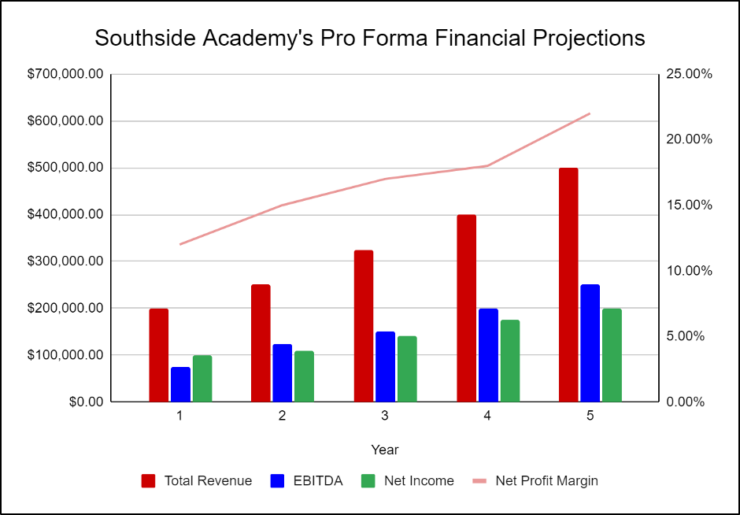
Company Overview
Who is southside academy, southside academy’s history.
Southside Academy started as an idea from a group of school teachers, including Mike Brown. The teachers were university pals who are passionate about teaching and children. They have seen the gaps in education in St. Paul, Minnesota, and wanted to create a school that elevates the academic environment for the children of this area.
Their plans to build a school started in 2015, but it was only until April 2016 that they finally completed all the paperwork and met the legal requirements. Since then, Southside Academy has achieved the following milestones:
- Found a location and built the school
- Developed the school’s name, logo, and website
- Determined curriculum
- Hired teachers and other key employees
Southside Academy’s Services
Industry analysis.
Education is an essential foundation for a thriving society. It’s more important than ever before that every child has access to affordable, high-quality education. While public schools are an essential option for many low-income families, the education provided by private schools often results in higher test scores and more students moving on to top-tier universities.
The private school industry has experienced steady growth in the past five years. The key industry drivers are economic growth, the rise in numbers of K-12 students, an increase in the number of families with both parents working, and government initiatives to support education.
According to Polaris Market Research, this growth is expected to continue with a forecasted compound annual growth rate of 6.6% from now until 2030. This shows that Southside Academy has great potential to keep growing and expanding. We will have ample opportunities to grow our curriculum and offer services to students that help them reach their highest potential.
Customer Analysis
Demographic profile of target market.
Southside Academy serves the families and children of St. Paul, Minnesota. The area is mostly populated by young couples and new families that have disposable income and can pay a premium for their children’s education.
The precise demographics of the town in which our location resides are as follows:
Customer Segmentation
We primarily target the following three customer segments:
- Young children
- Young couples
Competitive Analysis
Direct and indirect competitors.
Southside Academy faces competition from other schools with similar profiles. A description of each competitor company is below.
Waters Independent School
Founded in 1968, Waters Independent School is a non-profit and tax-exempt independent school system. The school is governed by an independent Board of Trustees and offers preschool through eighth-grade programs. WIS is accredited by the state’s Council of Independent Schools (FCIS).
Waters Independent School has small class sizes with low student-to-teacher ratios. Further, WIS’ Programs include a strong academic foundation coupled with programs in the arts, physical education, media/technology, foreign language, and extracurricular areas.
Hill Preparatory School
Founded in 1923, Hill Preparatory School is a private, non-sectarian, coeducational, college preparatory day school. It offers PK-12 programs in a safe, student-centered environment. HPS supports its students through the challenges of the school year with one-on-one attention from dedicated faculty, robust services like The Learning Center and the College Center, and the most advanced educational technology. The campus spans 28 acres and has a new 60,000+ square foot facility.
Future Leaders Preparatory School
Founded in 1968, Future Leaders Prep is a private school for PreK3-8th grade. FLPS offers preschool, elementary school, and middle school programs and offers the International Baccalaureate program of study for all students. Teachers are endorsed in gifted education through a master’s level grant with [local University]’s College of Education Gifted Program. In addition to the school, Future Leaders offers community programs such as music, dance, art, and theater lessons through the Community School of the Arts, youth sports in the Community School for Sports, and the 7-week summer camp.
Competitive Advantage
There are many schools in St. Paul, Minnesota but none of them provides the same quality of education that Southside Academy provides, specifically the following:
Marketing Plan
Brand & value proposition.
The Southside Academy brand will focus on the school’s unique value proposition:
- Providing premium education at an affordable price
- Providing a supportive and challenging place for children to learn
- Giving parents the assurance that their children will reach their full potential
Promotions Strategy
The promotions strategy for Southside Academy is as follows:
Social Media
Southside Academy will invest heavily in a social media advertising campaign. The school will utilize social media accounts and invest in ads on all social media platforms. It will use targeted marketing to appeal to the target demographics.
Publications
The school will place print advertisements in key local publications, including newspapers, area magazines, and business newsletters. Additionally, Southside Academy will print brochures and place them in specific locations frequented by target individuals.
Website/SEO
Southside Academy will invest heavily in developing a professional website that displays all of the features and benefits of Southside Academy. It will also invest heavily in SEO so that the school’s website will appear at the top of search engine results.
Direct Mail
Southside Academy will blanket neighborhoods with direct mail pieces. These pieces will provide general information on Southside Academy and incentives to enroll.
Southside Academy prices its tuition at a moderate price so our students and their families feel they are getting great value when choosing our school.
Operations Plan
The following will be the operations plan for Southside Academy.
Operation Functions:
- Mike Brown is the school Principal. He manages the teachers, directs the direction of education, and serves as the head of the school.
- Mike is joined by Amanda Johnson who acts as the Administrative Assistant for the school. She helps Mike with the operations of the school as well as the marketing and administrative functions.
- Mike has hired an extensive team of highly qualified educators. Together, they teach dozens of subjects, including biology, chemistry, social studies, and mathematics. Every teacher that works for Southside Academy is passionate about education and pushing their students to reach their highest potential.
Milestones:
Southside Academy expects to achieve the following milestones in the following six months:
- 3/202X Kickoff of promotional campaign to attract new students
- 4/202X Start donation campaign
- 5/202X Hire new teachers for the upcoming year
- 6/202X Achieve donation/funding goal
- 7/202X Finalize list of incoming students for next year
- 8/202X Start next school year
Financial Plan
Key revenue & costs.
Southside Academy’s revenues come from student tuition fees and donations from both individuals and corporations.
The major costs for the company will be staffing, marketing expenses, location maintenance, equipment, and materials.
Funding Requirements and Use of Funds
Southside Academy is currently seeking additional fundraising and capital of $600,000 in order to fulfill our mission. The breakdown of the funding may be seen below:
Key Assumptions
The following outlines the key assumptions required in order to achieve the revenue and cost numbers in the financials and to pay off the startup business loan.
- Year 1: 200
- Year 2: 300
- Year 3: 400
- Year 4: 500
- Year 5: 600
- Tuition rate per year: $10,000
Financial Statements
Income statement, balance sheet, cash flow statement, school business plan faqs, what is a school business plan.
A school business plan is a plan to start and/or grow your school business. Among other things, it outlines your business concept, identifies your target customers, presents your marketing plan and details your financial projections.
You can easily complete your School business plan using our School Business Plan Template here .
What are the Main Types of School Businesses?
There are a number of different kinds of school businesses, some examples include: private K-12 school, charter school, virtual schools, independent schools, primary school, secondary education, or preschool.
How Do You Get Funding for Your School Business Plan?
School businesses are often funded through small business loans. Personal savings, credit card financing and angel investors are also popular forms of funding.
What are the Steps To Start a School Business?
Starting a school business can be an exciting endeavor. Having a clear roadmap of the steps to start a business will help you stay focused on your goals and get started faster.
1. Develop A School Business Plan - The first step in starting a business is to create a detailed school business plan that outlines all aspects of the venture. This should include potential market size and target customers, the services or products you will offer, pricing strategies and a detailed financial forecast.
2. Choose Your Legal Structure - It's important to select an appropriate legal entity for your school business. This could be a limited liability company (LLC), corporation, partnership, or sole proprietorship. Each type has its own benefits and drawbacks so it’s important to do research and choose wisely so that your school business is in compliance with local laws.
3, Register Your School Business - Once you have chosen a legal structure, the next step is to register your school business with the government or state where you’re operating from. This includes obtaining licenses and permits as required by federal, state, and local laws.
4. Identify Financing Options - It’s likely that you’ll need some capital to start your school business, so take some time to identify what financing options are available such as bank loans, investor funding, grants, or crowdfunding platforms.
5. Choose a Location - Whether you plan on operating out of a physical location or not, you should always have an idea of where you’ll be based should it become necessary in the future as well as what kind of space would be suitable for your operations.
6. Hire Employees - There are several ways to find qualified employees including job boards like LinkedIn or Indeed as well as hiring agencies if needed – depending on what type of employees you need it might also be more effective to reach out directly through networking events.
7. Acquire Necessary School Equipment & Supplies - In order to start your school business, you'll need to purchase all of the necessary equipment and supplies to run a successful operation.
8. Market & Promote Your Business - Once you have all the necessary pieces in place, it’s time to start promoting and marketing your school business. This includes creating a website, utilizing social media platforms like Facebook or Twitter, and having an effective Search Engine Optimization (SEO) strategy. You should also consider traditional marketing techniques such as radio or print advertising.
Learn more about how to start a successful school business:
- How to Start a School
Other Helpful Business Plan Templates
Nonprofit Business Plan Template

School Business Plan Template [Updated 2024]
School Business Plan
If you want to start a school or expand your current school, you need a business plan.
The following school business plan template gives you the key elements to include in a winning business plan. In addition to this template, a well-crafted plan will include market research to help you better understand the school industry, market trends, your competitive advantage and your target market. It will also help you craft a smart marketing strategy and a strong financial plan.
You can download our business plan template (including a full, customizable financial model) to your computer here.
Below are links to each of the key components of an education business plan to help you launch a successful school. This can be used for a variety of school business plans, including a private school business plan, a charter school, public schools, independent schools, virtual schools, primary or secondary education.
- Executive Summary – The executive summary provides an overview of your business opportunity and summarizes the business plan.
- Company Overview – The company overview includes information about your business concept, academic and extracurricular activities offered, and legal structure.
- Industry Analysis – The industry analysis includes market research that supports your business and provides insights into market trends and the education industry.
- Customer Analysis – The customer analysis provides an overview of your target customers.
- Competitive Analysis – The competitive analysis should identify your direct and indirect competitors and highlight your competitive advantage.
- Marketing Plan – The marketing plan includes your marketing strategy, pricing strategy, examples of marketing materials, and search engine optimization plan.
- Operations Plan – The operations plan includes information on your school’s day-to-day operations and processes.
- Management Team – The management team section includes a profile of the organizational structure, school leaders, their experience and responsibilities.
- Financial Plan – The financial plan includes financial projections, a cash flow statement, profit and loss statement and balance sheet.
Download our business plan template (including a full financial projections model and financial statements).
Comments are closed.
School Business Plan Home I. Executive Summary II. Company Overview III. Industry Analysis IV. Customer Analysis V. Competitive Analysis VI. Marketing Plan VII. Operations Plan VIII. Management Team IX. Financial Plan

Upmetrics AI Assistant: Simplifying Business Planning through AI-Powered Insights. Learn How
Entrepreneurs & Small Business
Accelerators & Incubators
Business Consultants & Advisors
Educators & Business Schools
Students & Scholars
AI Business Plan Generator
Financial Forecasting
AI Assistance
Ai pitch deck generator
Strategic Planning
See How Upmetrics Works →
- Sample Plans
- WHY UPMETRICS?
Customers Success Stories
Business Plan Course
Small Business Tools
Strategic Canvas Templates
E-books, Guides & More
- Sample Business Plans
- Education & Training
School Business Plan

Free Business Plan Template
Download our free business plan template now and pave the way to success. Let’s turn your vision into an actionable strategy!
- Fill in the blanks – Outline
- Financial Tables
How to Write A School Business Plan?
Writing a school business plan is a crucial step toward the success of your business. Here are the key steps to consider when writing a business plan:
1. Executive Summary
An executive summary is the first section planned to offer an overview of the entire business plan. However, it is written after the entire business plan is ready and summarizes each section of your plan.
Here are a few key components to include in your executive summary:
Introduce your Business:
Start your executive summary by briefly introducing your business to your readers.
Market Opportunity:
Educational programs & services:.
Highlight the school services you offer your clients. The USPs and differentiators you offer are always a plus.
Marketing & Sales Strategies:
Financial highlights:, call to action:.
Ensure your executive summary is clear, concise, easy to understand, and jargon-free.
Say goodbye to boring templates
Build your business plan faster and easier with AI
Plans starting from $7/month

2. Business Overview
The business overview section of your business plan offers detailed information about your business. The details you add will depend on how important they are to your business. Yet, business name, location, business history, and future goals are some of the foundational elements you must consider adding to this section:
Business Description:
Describe your business in this section by providing all the basic information:
Describe what kind of school business you run and the name of it. You may specialize in one of the following school businesses:
- Public schools
- Private schools
- Charter schools
- Magnet schools
- Virtual or online schools
- Boarding schools
- International schools
- Religious schools
- Describe the legal structure of your school, whether it is a sole proprietorship, LLC, partnership, or others.
- Explain where your business is located and why you selected the place.
Mission Statement:
Business history:.
If you’re an established school, briefly describe your business history, like—when it was founded, how it evolved over time, etc.
Additionally, If you have received any awards or recognition for excellent work, describe them.
Future Goals
This section should provide a thorough understanding of your business, its history, and its future plans. Keep this section engaging, precise, and to the point.
3. Market Analysis
The market analysis section of your business plan should offer a thorough understanding of the industry with the target market, competitors, and growth opportunities. You should include the following components in this section.
Target market:
Start this section by describing your target market. Define your ideal customer and explain what types of services they prefer. Creating a buyer persona will help you easily define your target market to your readers.
Market size and growth potential:
Describe your market size and growth potential and whether you will target a niche or a much broader market.
Competitive Analysis:
Market trends:.
Analyze emerging trends in the industry, such as technology disruptions, changes in customer behavior or preferences, etc. Explain how your business will cope with all the trends.
Regulatory Environment:
Here are a few tips for writing the market analysis section of your school business plan::
- Conduct market research, industry reports, and surveys to gather data.
- Provide specific and detailed information whenever possible.
- Illustrate your points with charts and graphs.
- Write your business plan keeping your target audience in mind.
4. Products And Services
The product and services section should describe the specific services and products that will be offered to students. To write this section should include the following:
Describe your school services:
Mention the school services your business will offer. This list may include services like,
- Education programs
- Extracurricular activities
- Counseling & Guidance
- Special education services
- Transportation services
- Food services
- Testing and assessments
Describe specialized programs:
Student leadership programs, additional services:.
In short, this section of your school plan must be informative, precise, and client-focused. By providing a clear and compelling description of your offerings, you can help potential investors and readers understand the value of your business.
5. Sales And Marketing Strategies
Writing the sales and marketing strategies section means a list of strategies you will use to attract and retain your clients. Here are some key elements to include in your sales & marketing plan:
Unique Selling Proposition (USP):
Define your business’s USPs depending on the market you serve, the equipment you use, and the unique services you provide. Identifying USPs will help you plan your marketing strategies.
Pricing Strategy:
Marketing strategies:, sales strategies:, customer retention:.
Overall, this section of your school business plan should focus on customer acquisition and retention.
Have a specific, realistic, and data-driven approach while planning sales and marketing strategies for your school business, and be prepared to adapt or make strategic changes in your strategies based on feedback and results.
6. Operations Plan
The operations plan section of your business plan should outline the processes and procedures involved in your business operations, such as staffing requirements and operational processes. Here are a few components to add to your operations plan:
Staffing & Training:
Operational process:, equipment & software:.
Include the list of equipment and software required for school, such as whiteboards & projectors, student information systems, learning management systems, communication & collaboration tools, etc.
Adding these components to your operations plan will help you lay out your business operations, which will eventually help you manage your business effectively.
7. Management Team
The management team section provides an overview of your school business’s management team. This section should provide a detailed description of each manager’s experience and qualifications, as well as their responsibilities and roles.
Founders/CEO:
Key managers:.
Introduce your management and key members of your team, and explain their roles and responsibilities.
Organizational structure:
Compensation plan:, advisors/consultants:.
Mentioning advisors or consultants in your business plans adds credibility to your business idea.
This section should describe the key personnel for your school, highlighting how you have the perfect team to succeed.
8. Financial Plan
Your financial plan section should provide a summary of your business’s financial projections for the first few years. Here are some key elements to include in your financial plan:
Profit & loss statement:
Cash flow statement:, balance sheet:, break-even point:.
Determine and mention your business’s break-even point—the point at which your business costs and revenue will be equal.
Financing Needs:
Be realistic with your financial projections, and make sure you offer relevant information and evidence to support your estimates.
9. Appendix
The appendix section of your plan should include any additional information supporting your business plan’s main content, such as market research, legal documentation, financial statements, and other relevant information.
- Add a table of contents for the appendix section to help readers easily find specific information or sections.
- In addition to your financial statements, provide additional financial documents like tax returns, a list of assets within the business, credit history, and more. These statements must be the latest and offer financial projections for at least the first three or five years of business operations.
- Provide data derived from market research, including stats about the industry, user demographics, and industry trends.
- Include any legal documents such as permits, licenses, and contracts.
- Include any additional documentation related to your business plan, such as product brochures, marketing materials, operational procedures, etc.
Use clear headings and labels for each section of the appendix so that readers can easily find the necessary information.
Remember, the appendix section of your school business plan should only include relevant and important information supporting your plan’s main content.
The Quickest Way to turn a Business Idea into a Business Plan
Fill-in-the-blanks and automatic financials make it easy.

This sample school business plan will provide an idea for writing a successful school plan, including all the essential components of your business.
After this, if you still need clarification about writing an investment-ready business plan to impress your audience, download our school business plan pdf .
Related Posts
After-School Program Business Plan
Preschool Business Plan
400+ Business Plan Template Example
Business Plan Writing Guide
Business Plan Cover Page Design Idea
How to Create Business Plan Outline
Frequently asked questions, why do you need a school business plan.
A business plan is an essential tool for anyone looking to start or run a successful school business. It helps to get clarity in your business, secures funding, and identifies potential challenges while starting and growing your business.
Overall, a well-written plan can help you make informed decisions, which can contribute to the long-term success of your school.
How to get funding for your school business?
There are several ways to get funding for your school business, but self-funding is one of the most efficient and speedy funding options. Other options for funding are:
- Bank loan – You may apply for a loan in government or private banks.
- Small Business Administration (SBA) loan – SBA loans and schemes are available at affordable interest rates, so check the eligibility criteria before applying for it.
- Crowdfunding – The process of supporting a project or business by getting a lot of people to invest in your business, usually online.
- Angel investors – Getting funds from angel investors is one of the most sought startup options.
Apart from all these options, there are small business grants available, check for the same in your location and you can apply for it.
Where to find business plan writers for your school business?
There are many business plan writers available, but no one knows your business and ideas better than you, so we recommend you write your school business plan and outline your vision as you have in your mind.
What is the easiest way to write your school business plan?
A lot of research is necessary for writing a business plan, but you can write your plan most efficiently with the help of any school business plan example and edit it as per your need. You can also quickly finish your plan in just a few hours or less with the help of our business plan software .
About the Author
Upmetrics Team
Upmetrics is the #1 business planning software that helps entrepreneurs and business owners create investment-ready business plans using AI. We regularly share business planning insights on our blog. Check out the Upmetrics blog for such interesting reads. Read more
Plan your business in the shortest time possible
No Risk – Cancel at Any Time – 15 Day Money Back Guarantee
Popular Templates

Create a great Business Plan with great price.
- 400+ Business plan templates & examples
- AI Assistance & step by step guidance
- 4.8 Star rating on Trustpilot
Streamline your business planning process with Upmetrics .


Everything You Need To Know About Starting a New School
by Gordana S | Oct 7, 2020 | Starting a School | 0 comments

Table of Contents
The Ins and Outs of Starting a New School

Image source: WeAreTeachers
Are you an educational expert who believes that the schooling system is in desperate need of change?
Are you willing to dedicate your time and energy to creating an educational establishment that will be remembered by generations to come?
If you are both of these things, you have come to the right place.
Starting a new school can be a daunting undertaking, but with the right vision, careful planning, and a healthy support system, success is virtually guaranteed.
To help your vision come to fruition, we have decided to provide you with an in-depth guide on how to start a new school . You will learn how to build your school’s identity, craft business plans, and budgets, increase your school’s online presence , and find the right staff for your new school.
Building a School Identity
Identity is what brings a group of people together, increases group cohesion, and maintains a school community .
Building a school identity requires:
- Coming up with a school’s name
- Creating a school’s brand
Coming Up With a School’s Name
If you are opening a high school that is affiliated with a well-known chain of schools, you will have to adhere to the chain’s established naming convention. Coming up with a name for an independent school is a bit more tricky because you will have to consider whether the following conditions are met :
- A valid domain name is available
- Another high school with the same name doesn’t already exist
- There are no copyright issues regarding a word or phrase included in your school’s name
Purchasing a Domain Name
Purchasing a logical domain name (easily relatable to your brand) is crucial for building your school’s online presence . Both your website and email addresses will contain the domain name, so you should make sure that it is easily remembered and, preferably, easy to type. This includes avoiding underscores and hyphens in your school’s domain name.
Given that domains no longer have to end with .com, .org, or .net, you should not have any issues using the domain name you have come up with by going for a different domain ending such as .school, .academy, etc.
To reserve a domain name, you will need to use one of many available domain registrars such as:
Make Sure That The Name Is Authentic
Before you settle for a particular name for your high school, make sure that no other school in your state is using it .
Although having your school share the same name as another one in a different state does not have to be a cause for concern (from the copyright standpoint), it can be confusing, and you do not want that.
To make sure that no other school in your area uses the same name, you can check out one of the following websites:
- EducationBug
- National Center for Education Statistics (NCES)
- Private School Review
Potential Copyright Challenges
Before finalizing your school’s name, it would be smart to consult an attorney that specializes in intellectual property—to make sure that your school’s name does not get confused for the names of other brands and companies on the marketplace.
Last names often create copyright issues as many companies have their founder’s last name in the title.
Crafting a Brand

Image source: HEM
One thing that almost all successful brands have in common is that they stand out from the competition.
To craft a successful school brand, you need to cover the branding basics that include :
- Visual branding
- Mission statement and core values
The Importance of Visual Branding
When crafting your school’s brand, working on visual materials that will represent your establishment is more than necessary.
Logos and wordmarks are a great place to start your visual branding process . Your school’s logo will influence the rest of the visual branding decisions you will have to make—be it color choices, playful or serious designs, etc.
Instead of creating these visual items yourself, we suggest giving design websites like 99Designs and LogoTournament a shot.
Mission Statement and Core Values
When conceptualizing your school’s mission statement, ask yourself the following questions:
- What are my school’s core values
- What is my school’s mission
- How will the community perceive my school
- What will make my school stand out
Exploring the answers to these questions will help set the tone for your school culture , which will subsequently affect the recruitment process.
If you are struggling to define your school’s mission statement and core values, you can find guidance in:
- Our school mission statement guide
- CultureIQ ’s guide to defining company values
Creating a Business Plan and Budget When Starting a New School
Your planning process can easily go sideways if you do not construct a viable business plan carefully.
Business plans are essential for gaining confidence in your school’s vision , as well as building confidence in others to help them understand how you plan to turn your dream into reality.
To start working on a business plan, you first need to be clear about your mission and core values. After you have established them, you have to ask yourself the following questions:
- What is the perfect number of students in my high school? You should be confident about the size of the school you want to build. Is your goal to have over 500 students, or do you want your student count to remain small?
- Who are the families and students I want to teach? Is your goal to educate the underserved population that your community has neglected? Do you want to bring like-minded families together, based on a shared academic philosophy, opportunity, or religious conviction?
- What role should I take? If you want to be satisfied with what you have achieved, assessing your passions and aspirations beforehand is a must. Do you enjoy spending time in the classroom? If so, you should make sure to split your time between doing administrative tasks and teaching. The beauty of starting a new school is that you get to design the job of your dreams for yourself.
A Budget and a Business Plan Are Not the Same
People often mix up budgets and business plans and cannot easily tell them apart.
- A budget is nothing more than an internal document that helps you keep track of your income and expenses. Many of the decisions that a school leader needs to make are based on the budget’s capacity.
- A business plan is a complex document that serves as a guidebook and tells you how and what you will accomplish with your school. Financial institutions will want to examine your business plan before deciding whether your school is worth investing in.
Creating Your School Budget
Above all things, you should make sure that your budget is easy to read and understand .
To achieve this, you are going to want to use spreadsheets or other organizational methods that make keeping track of your budget hassle-free.
Fortunately, there are many business budget templates available online that can be tweaked to meet your school’s needs.
When creating a budget, you should consult the following resources to familiarize yourself with the fundamental principles of budget creation:
- A beginner’s guide to planning and managing school budgets by The Guardian
- Practical Guidance for Independent School Business Operations by The National Business Officers Association
- School Budgets 101 by The American Association of School Administrators
Creating a Business Plan
Creating a business plan is a time-consuming effort .
However, the fact that business plans tend to follow a standardized format facilitates the process greatly.
You can approach your business plan in two ways:
- A traditional business plan — Traditional business plans or “full” business plans are all-inclusive and detailed. When creating a traditional business plan, you get to identify certain areas of planning that you might have overlooked previously, such as financing requests and market analysis.
- A start-up business plan — Start-up or “lean” business plans are much faster to write and focus only on a few crucial elements, like revenue streams and key partnerships. Start-up plans are a great starting point, especially when you are in the process of acquiring funds.
Most business plan templates share common characteristics, so you should not think long and hard about which one to settle on. The following resources will give you an idea on how to approach your business plan:
- US Small Business Administration
- InvoiceBerry
If you do not want to deal with creating a business plan on your own, you can always hire a professional online agency to do it for you. Here are some of the agencies that you might want to check out:
- Go Business Plans
- Cayenne Consulting
Developing Your Marketing Strategy
No matter the industry you are in, having a solid marketing strategy impacts your outreach drastically.
When taking on the role of a marketer, your goal is to provide a unique value or benefit that meets the needs and solves the problems of your customers . In terms of high schools, that can be an individual approach to learning, a one-of-a-kind curriculum, etc.
That unique thing that sets your school apart is known as the “brand promise,” and it will play a major role in how successful your marketing strategy turns out to be.
Designing a School Website
When they need to do some research, the first place people visit is the web. That is why you want to have a neatly designed and fully operational website even before you open your school’s doors. Keep in mind that the website has to:
- Have a responsive design — Given that your future prospects will not necessarily have a computer nearby when they find out about your school, ensuring that your website is equally as functional and intuitive to use on all devices is essential
- Communicate your story — People who are visiting your website for the first time want to learn about your school’s story and vision quickly. That is why your website needs to illustrate your school culture through words, photo galleries, and easily accessible videos
- Look and feel professional — In today’s world, people are used to assessing the quality of service via the content presented on a website. To make sure that your website speaks volumes about your competence, it has to be clean, well-organized, and visually appealing.
Traditional Marketing Methods
Online marketing is something that you should focus on the most when starting a new school.
Traditional marketing strategies still have their place in today’s world and should be used simultaneously with various online marketing methods. Some of the best traditional marketing channels are:
Using Social Media To Advertise Your New School
Social media platforms are perfect for getting the message about your new high school across. The best thing about them is that you do not need a substantial marketing budget to make your online marketing strategies effective.
One thing that you should keep in mind is that posting regular updates on your social media channels is necessary to advertise your high school successfully . If you do not have the means to post new content continuously, limit the number of channels that you are using.
Social media platforms that you should take into consideration are:
- Facebook —You can set up a business page for your high school that will contain your school’s name, location, and a link to the school’s website. Since Facebook has millions of users, your high school Facebook page will probably receive a substantial amount of traffic.
- Nextdoor —If you want to keep your local community updated with your school’s activities, Nextdoor is the ideal platform for your purposes.
- Twitter —Given that Twitter limits the number of characters that you can use, it is a great channel for updating your school community about important snippets of information, such as your school’s opening date.
Finding and Hiring the Right Staff When Starting a New School

Image source: Career FAQs
Finding the right staff is the most challenging aspect of starting a new school—yet the most important one .
The right teaching staff will help you start on the right foot and provide a solid foundation on which you can build your school community.
You can advertise open teaching positions on various online platforms, but the best ones are:
- K12 Job Spot
- SchoolSpring
Hiring the Right People
When hiring new people for your high school, it is important to find the right staff that will become an asset to it.
You can adhere to entrepreneur Alan Hall’s 7Cs when interviewing future employees:
- Culture —Does the candidate fit your school’s culture ?
- Capable —Is the applicant willing to grow and learn even further?
- Competent —Does the interviewee have the necessary skills and education for the job?
- Commitment —Will they stick around for a while?
- Compatible —Will the candidate get along with other staff members?
- Compensation —Do you have the means to pay the prospective employee appropriately?
- Character —Does the aspiring candidate share your school’s values?
How To Start a New School the Right Way
As long as you are confident in your vision, have a strong business plan, and hire the right staff, the process of starting a new school will be less stressful and laborious.
Be careful about how you define your school’s brand and make sure to offer something unique that will make your school stand out within the community.
Although the process of starting a new school is laborious, the whole community will get to reap the benefits of the end result. Keep your vision clear and surround yourself with the right people, and in a few years’ time, we will have better functioning educational institutions.
Submit a Comment Cancel reply
Your email address will not be published. Required fields are marked *
Save my name, email, and website in this browser for the next time I comment.
Recent Posts
- How to become a writer after high school
- Effective Stress Management Activities for Teenagers
- Teaching Persuasive Writing in a Fun Way
- The Importance of Financial Literacy for High School Students
- Career Assessment for High School Students
- PRO Courses Guides New Tech Help Pro Expert Videos About wikiHow Pro Upgrade Sign In
- EDIT Edit this Article
- EXPLORE Tech Help Pro About Us Random Article Quizzes Request a New Article Community Dashboard This Or That Game Popular Categories Arts and Entertainment Artwork Books Movies Computers and Electronics Computers Phone Skills Technology Hacks Health Men's Health Mental Health Women's Health Relationships Dating Love Relationship Issues Hobbies and Crafts Crafts Drawing Games Education & Communication Communication Skills Personal Development Studying Personal Care and Style Fashion Hair Care Personal Hygiene Youth Personal Care School Stuff Dating All Categories Arts and Entertainment Finance and Business Home and Garden Relationship Quizzes Cars & Other Vehicles Food and Entertaining Personal Care and Style Sports and Fitness Computers and Electronics Health Pets and Animals Travel Education & Communication Hobbies and Crafts Philosophy and Religion Work World Family Life Holidays and Traditions Relationships Youth
- Browse Articles
- Learn Something New
- Quizzes Hot
- This Or That Game New
- Train Your Brain
- Explore More
- Support wikiHow
- About wikiHow
- Log in / Sign up
- Finance and Business
- Business by Industry
How to Start a School
Last Updated: February 10, 2023 Approved
This article was co-authored by Helena Ronis . Helena Ronis is Co-founder and CEO of AllFactors, a unified web analytics software to drive company's marketing and business growth. She has worked in product and marketing in the tech industry for over 8 years, and studied Digital Marketing & Analytics at the MIT Sloan School of Management Executive Program. wikiHow marks an article as reader-approved once it receives enough positive feedback. This article received 26 testimonials and 92% of readers who voted found it helpful, earning it our reader-approved status. This article has been viewed 469,923 times.
Congratulations! You're joining parents and teachers around the world who want to reinvent education by starting their own schools. Starting a school and sharing your vision for education with the world can be one of the most satisfying career choices you'll make. But where to start? A bit of planning is essential at all steps in the process, but there is also so much support available to you.
Preparing to Start a School

Developing Curriculum

- What are your values?
- Who do you want to serve?
- What kind of education does this community need?
- What will your school provide that other schools cannot?
- What kind of social, intellectual and emotional experience do you want to give your students?
- Where do you want your school to be in 5 years, 25 years and 100 years?
- What type of school do you want to start? For-profit or non-profit? Non-profits are extremely difficult to establish but have long-term benefits. If you want to start on a smaller scale, you could consider beginning with a few afterschool classes, a part-time homeschool coop or a playgroup.

- How long are classes?
- How many classes in a day?
- When will the day start and end?
- How will lunches be organized?
- How will teachers be scheduled?
- What do your students need?
- What is the objective of the students' learning?
- What criteria will be used to assess learning?
- How will students be tested?
- What constitutes graduation from the school?

- For a teaching statement, try to word things in such a way as to attract the best and brightest young teachers and the most enthusiastic to make your school as good as possible. May teacher select their own texts, or select from approved books? Consider ways in which you can make your school an attractive alternative for creative teachers.

Forming a Corporation

- Consider conducting a feasibility study to determine whether or not opening a school will be a viable option. Early in the startup process, it is essential to take a hard look at your vision and determine how best to proceed. You'll need to determine how many students you're likely to enroll, budget costs, operating costs, upkeep of the grounds, and all other facets of the school's operation to determine if it will be likely to succeed. You may also want to interview people in your community about whether there is a need for this type of school

- While an increasing number of micro-schools are run by a single teacher, in general, no school is run by a single "leader." While it's important to establish good leadership as a group, a school is more of a corporation and less of a dictatorship. To find a good board of directors, consider enlisting local members of the education community who may be dissatisfied with their local options and be interested in a more forward-thinking school, like yours.

- Net earnings may not inure to the benefit of any private individual or shareholder.
- No substantial part of its activity may be attempting to influence legislation and may not intervene in political campaigns.
- The organization’s purposes and activities may not be illegal or violate fundamental public policy.

- The tax-exempt status can be somewhat time-consuming, and you may want to consult a lawyer to go over the paperwork with you and ensure that you're interpreting and filling it out correctly. To file for tax-exempt status, fill out IRS form 1023, found here .
Opening Your School

- Apply for grants appropriate to your school and use the money toward implementing your vision.

- Start early. The leasing, renovation and construction processes tend to take longer than anticipated. Also, if possible, design your physical space to facilitate your school’s mission.

Community Q&A
You Might Also Like

- ↑ https://amshq.org/Educators/Montessori-Schools/Starting-a-School
- ↑ https://portal.ct.gov/-/media/SDE/Health-Education/curguide_generic.pdf
- ↑ https://amshq.org/School-Resources/Starting-a-School/Some-Considerations-and-First-Steps.aspx
- ↑ https://www.pbs.org/newshour/education/start-school-one-familys-recipe-startup-success
- ↑ http://www.irs.gov/publications/p557/ch03.html
About This Article

If you want to start your own school, visit your state’s website for their Department of Education and familiarize yourself with any laws and regulations that will apply to you. Write out a curriculum including class length, school hours, assessment criteria, and other organizational details, then present the curriculum to your state’s school board and have it approved. After that, form a corporation and secure funding for your school, lease or construct the school building, and hire your staff before the start of the new school year! Keep reading to learn how to attract students to your school! Did this summary help you? Yes No
- Send fan mail to authors
Reader Success Stories
Manisha Snoyer
Mar 30, 2016
Did this article help you?

Rubab Sohail
Feb 21, 2017
Tom O'Brien
Apr 18, 2016
Apr 23, 2023
Nov 20, 2018


Featured Articles

Trending Articles

Watch Articles

- Terms of Use
- Privacy Policy
- Do Not Sell or Share My Info
- Not Selling Info
Get all the best how-tos!
Sign up for wikiHow's weekly email newsletter

How to Start a Charter School

Starting a charter school can be very profitable. With proper planning, execution and hard work, you can enjoy great success. Below you will learn the keys to launching a successful charter school.
Importantly, a critical step in starting a charter school is to complete your business plan. To help you out, you should download Growthink’s Ultimate Business Plan Template here .
Download our Ultimate Business Plan Template here
14 Steps To Start a Charter School :
- Choose the Name for Your Charter School
- Develop Your Charter School Business Plan
- Choose the Legal Structure for Your Charter School
- Secure Startup Funding for Your Charter School (If Needed)
- Secure a Location for Your Business
- Register Your Charter School with the IRS
- Open a Business Bank Account
- Get a Business Credit Card
- Get the Required Business Licenses and Permits
- Get Business Insurance for Your Charter School
- Buy or Lease the Right Charter School Equipment
- Develop Your Charter School Marketing Materials
- Purchase and Setup the Software Needed to Run Your Charter School
- Open for Business
1. Choose the Name for Your Charter School
The first step to starting a charter school is to choose your business’ name.
This is a very important choice since your company name is your brand and will last for the lifetime of your business. Ideally you choose a name that is meaningful and memorable. Here are some tips for choosing a name for your new charter school:
- Make sure the name is available . Check your desired name against trademark databases and your state’s list of registered business names to see if it’s available. Also check to see if a suitable domain name is available.
- Keep it simple . The best names are usually ones that are easy to remember, pronounce and spell.
- Think about marketing . Come up with a name that reflects the desired brand and/or focus of your charter school.
2. Develop Your Charter School Business Plan
One of the most important steps in starting a charter school is to develop your business plan. The process of creating your plan ensures that you fully understand your market and your business strategy. The plan also provides you with a roadmap to follow and if needed, to present to funding sources to raise capital for your business.
Your business plan should include the following sections:
- Executive Summary – this section should summarize your entire business plan so readers can quickly understand the key details of your own charter school.
- Company Overview – this section tells the reader about the history of your charter school and what type of charter school you operate. For example, are you a virtual charter school, magnet school, single-sex school, or a faith-based school?
- Industry Analysis – here you will document key information about the charter school industry. Conduct market research and document how big the industry is and what trends are affecting it.
- Customer Analysis – in this section, you will document who your ideal or target customers are and their demographics. For example, how old are they? Where do they live? What do they find important when purchasing services like the ones you will offer?
- Competitive Analysis – here you will document the key direct and indirect competitors you will face and how you will build competitive advantage.
- Marketing Plan – your marketing plan should address the 4Ps: Product, Price, Promotions and Place.
- Product : Determine and document what products/services you will offer
- Prices : Document the prices of your products/services
- Place : Where will your business be located and how will that location help you increase sales?
- Promotions : What promotional methods will you use to attract customers to your charter school? For example, you might decide to use pay-per-click advertising, public relations, search engine optimization and/or social media marketing.
- Operations Plan – here you will determine the key processes you will need to run your day-to-day operations. You will also determine your staffing needs. Finally, in this section of your plan, you will create a projected growth timeline showing the milestones you hope to achieve in the coming years.
- Management Team – this section details the background of your company’s management team.
- Financial Plan – finally, the financial plan answers questions including the following:
- What startup costs will you incur?
- How will your charter school make money?
- What are your projected sales and expenses for the next five years?
- Do you need to raise funding to launch your business?
Finish Your Business Plan Today!
3. choose the legal structure for your charter school.
Next you need to choose a legal structure for your charter school and register it and your business name with the Secretary of State in each state where you operate your business.
Below are the five most common legal structures:
1) Sole proprietorship
A sole proprietorship is a business entity in which the owner of the charter school and the business are the same legal person. The owner of a sole proprietorship is responsible for all debts and obligations of the business. There are no formalities required to establish a sole proprietorship, and it is easy to set up and operate. The main advantage of a sole proprietorship is that it is simple and inexpensive to establish. The main disadvantage is that the owner is liable for all debts and obligations of the business.
2) Partnerships
A partnership is a legal structure that is popular among small businesses. It is an agreement between two or more people who want to start a charter school together. The partners share in the profits and losses of the business.
The advantages of a partnership are that it is easy to set up, and the partners share in the profits and losses of the business. The disadvantages of a partnership are that the partners are jointly liable for the debts of the business, and disagreements between partners can be difficult to resolve.
3) Limited Liability Company (LLC)
A limited liability company, or LLC, is a type of business entity that provides limited liability to its owners. This means that the owners of an LLC are not personally responsible for the debts and liabilities of the business. The advantages of an LLC for a charter school include flexibility in management, pass-through taxation (avoids double taxation as explained below), and limited personal liability. The disadvantages of an LLC include lack of availability in some states and self-employment taxes.
4) C Corporation
A C Corporation is a business entity that is separate from its owners. It has its own tax ID and can have shareholders. The main advantage of a C Corporation for a charter school is that it offers limited liability to its owners. This means that the owners are not personally responsible for the debts and liabilities of the business. The disadvantage is that C Corporations are subject to double taxation. This means that the corporation pays taxes on its profits, and the shareholders also pay taxes on their dividends.
5) S Corporation
An S Corporation is a type of corporation that provides its owners with limited liability protection and allows them to pass their business income through to their personal income tax returns, thus avoiding double taxation. There are several limitations on S Corporations including the number of shareholders they can have among others.
Once you register your charter school, your state will send you your official “Articles of Incorporation.” You will need this among other documentation when establishing your banking account (see below). We recommend that you consult an attorney in determining which legal structure is best suited for your company.
4. Secure Startup Funding for Your Charter School (If Needed)
In developing your charter school business plan, you might have determined that you need to raise funding to launch your business.
If so, the main sources of funding for a charter school to consider are personal savings, family and friends, credit card financing, bank loans, crowdfunding and angel investors. Angel investors are individuals who provide capital to early-stage businesses. Angel investors typically will invest in a charter school that they believe has high potential for growth.
5. Secure a Location for Your Business
When looking for a location for your charter school, you’ll want to consider a few factors.
First, you’ll need to find a space that is large enough to accommodate your students and staff. You’ll also need to make sure that the space is accessible and affordable.
Another important factor to consider is the zoning regulations in your area. Make sure the location you choose is allowed to operate as a school. You’ll also need to check with the local school district to see if there are any restrictions on the type of school you plan to open.
6. Register Your Charter School with the IRS
Next, you need to register your business with the Internal Revenue Service (IRS) which will result in the IRS issuing you an Employer Identification Number (EIN).
Most banks will require you to have an EIN in order to open up an account. In addition, in order to hire employees, you will need an EIN since that is how the IRS tracks your payroll tax payments.
Note that if you are a sole proprietor without employees, you generally do not need to get an EIN. Rather, you would use your social security number (instead of your EIN) as your taxpayer identification number.
7. Open a Business Bank Account
It is important to establish a bank account in your charter school’s name. This process is fairly simple and involves the following steps:
- Identify and contact the bank you want to use
- Gather and present the required documents (generally include your company’s Articles of Incorporation, driver’s license or passport, and proof of address)
- Complete the bank’s application form and provide all relevant information
- Meet with a banker to discuss your business needs and establish a relationship with them
8. Get a Business Credit Card
You should get a business credit card for your charter school to help you separate personal and business expenses.
You can either apply for a business credit card through your bank or apply for one through a credit card company.
When you’re applying for a business credit card, you’ll need to provide some information about your business. This includes the name of your business, the address of your business, and the type of business you’re running. You’ll also need to provide some information about yourself, including your name, Social Security number, and date of birth.
Once you’ve been approved for a business credit card, you’ll be able to use it to make purchases for your business. You can also use it to build your credit history which could be very important in securing loans and getting credit lines for your business in the future.
9. Get the Required Business Licenses and Permits
To open a charter school in most states, you will need to obtain a charter from the state authorizing body. You will also need to apply for and receive a license to operate the school from your state Department of Education. In some states, you may also need to obtain a business license and/or environmental permit.
In addition, you will need to comply with the health, safety, and civil rights requirements of your state.
Be sure to check with your state’s education department and local government offices to determine which licenses and permits are required since charter school laws vary from state to state.
10. Get Business Insurance for Your Charter School
There are many types of insurance that are needed to operate a charter school depending on the state in which you are located.
Some business insurance policies you should consider for your charter school include:
- General liability insurance : This covers accidents and injuries that occur on your property. It also covers damages caused by your employees or products.
- Auto insurance : If a vehicle is used in your business, such as a school bus, this type of insurance will cover if a vehicle is damaged or stolen.
- Workers’ compensation insurance : If you have employees, this type of policy works with your general liability policy to protect against workplace injuries and accidents. It also covers medical expenses and lost wages.
- Commercial property insurance : This covers damage to your property caused by fire, theft, or vandalism.
- Business interruption insurance : This covers lost income and expenses if your business is forced to close due to a covered event.
- Professional liability insurance : This protects your business against claims of professional negligence.
Find an insurance agent, tell them about your business and its needs, and they will recommend policies that fit those needs.
11. Buy or Lease the Right Charter School Equipment
It is important to note that there are various pieces of equipment that are necessary in order to run a charter school. Some of the most important equipment includes computers, printers, photocopiers, desks, chairs, and textbooks. In addition, a charter school may require classroom shelving and office shelving for storage of reading books, science equipment, math tools, and other items that are relevant to the school’s curriculum design.
In order to create a safe environment for students in the school facility, there are also other pieces of safety equipment required. First aid kits are necessary as well as fire extinguishers, smoke detectors, and emergency lighting.
12. Develop Your Charter School Marketing Materials
Marketing materials will be required to attract and retain customers to your charter school.
The key marketing materials you will need are as follows:
- Logo : Spend some time developing a good logo for your charter school. Your logo will be printed on company stationery, business cards, marketing materials and so forth. The right logo can increase customer trust and awareness of your brand.
- Website : Likewise, a professional charter school website provides potential customers with information about the services you offer, your company’s history, and contact information. Importantly, remember that the look and feel of your website will affect how customers perceive you.
- Social Media Accounts : establish social media accounts in your company’s name. Accounts on Facebook, Twitter, LinkedIn and/or other social media networks will help customers and others find and interact with your charter school.
13. Purchase and Setup the Software Needed to Run Your Charter School
To start a charter school, you need to have the proper software to run the school. This includes software for managing finances, tracking student progress, and communicating with parents. There are many different software programs available for new charter schools, so be sure to find one that fits your needs.
14. Open for Business
You are now ready to open your charter school. If you followed the steps above, you should be in a great position to build a successful business. Below are answers to frequently asked questions that might further help you.
How to Finish Your Ultimate Business Plan in 1 Day!
Don’t you wish there was a faster, easier way to finish your charter school business plan?
With Growthink’s Ultimate Business Plan Template you can finish your plan in just 8 hours or less!
How to Start a Charter School FAQs
Is it hard to start a charter school.
No, it is not difficult to start a charter school. There are many resources available to help you get started, and the process is relatively straightforward. However, it is important to understand the requirements and regulations involved in starting a charter school before you begin the process.
How can I start a charter school with no experience?
The best way to start a charter school with no experience is to do your research. Learn about the process of opening a charter school and what's involved. You can find a lot of information by contacting your state's Department of Education. Attend educator workshops and networking events, and meet with other successful charter school board members to get ideas.
What type of charter school is most profitable?
The most profitable type of charter school is the for-profit school. This is because successful charter schools are able to generate revenue from their students. They also tend to have higher tuition rates than nonprofit and public schools.
How much does it cost to start a charter school?
Charter school startup s cost around $200,000-$300,000. This includes expenses such as purchasing or leasing a building, hiring staff, and purchasing curriculum and materials.
What are the ongoing expenses for a charter school?
The ongoing expenses for a charter school can include the cost of rent, utilities, teacher salaries, administrative staff salaries, textbooks and other instructional materials, technology needs, transportation, and other operating costs. Some charters also have substantial building renovation costs.
How does a charter school make money?
Established charter schools make money in two ways: through tuition payments and through government funding. Charter schools receive a per-pupil funding amount from the government, and they can also charge tuition. The amount of tuition charged varies depending on the school's location and the type of charter school.
Is owning a charter school profitable?
There is no definitive answer, as the profitability of charter schools can vary greatly depending on a number of factors. However, most charter schools can be lucrative because they are able to charge tuition fees not charged by schools in the public school system . Many states provide financial incentives for charter schools, which can also boost their profitability.
Why do charter schools fail?
Charter schools fail because they are not subject to the same rules and regulations as public schools. This means that sometimes charter schools are not held accountable for their results, which can lead to lower-quality education for students. Once a school develops a reputation for providing lower-quality education, it can fail quickly. Additionally, most charter schools are funded by private donors rather than through state or federal funding, which can also lead to problems if donations slow or stop.
Other Helpful Business Plan Articles & Templates

ZenBusinessPlans
Home » Sample Business Plans » Education » School
How to Write a Private School Business Plan [Sample Template]
Are you about starting a private school (nursery, primary or high school)? If YES, here’s a complete sample private school business plan template & feasibility report you can use for FREE. Okay, so we have considered all the requirements for starting a private school.
We also took it further by analyzing and drafting a sample private school marketing plan template backed up by actionable guerrilla marketing ideas for private schools. So let’s proceed to the business planning section.
Why Start a Private School?
One of the best things that can happen to anyone is to have a private school. This is one very lucrative business that will continue to rake in money for its owners. As an aspiring entrepreneur who is looking towards starting a business, you should ensure that whatever business you intend to start, you make sure that it is located in an appropriate place.
For example; if you want to start a private school, it will be a wrong business judgment if you decide to site the school close to an industrial area or close to a market. Aspiring entrepreneurs therefore are urged as a matter of necessity to ensure that they carry out a thorough market research and feasibility study of the industry they intend to go into before investing their hard earned money and time.
It is known fact that the demand for private schools is driven by the fact that most public cum government owned schools cannot accommodate every students or potential students in a given geographical location. In some cases, students with special needs cannot cope in public schools hence the need for private schools.
If you think starting a private school business sounds like what you want to do. Then you may want to use the business plan below as a guide.
A Sample Private School Business Plan Template
1. industry overview.
Private schools which is also known in the united states as independent schools, non-governmental, or non – state schools are schools that are not administered by either the local, state or the federal governments; hence, they have the right to select their students and are funded in whole or in part by charging their students tuition fees, rather than relying on mandatory taxation through public (government) funding.
Some private schools have structure in place that offer scholarships to some students, which makes the cost cheaper, depending on a talent such as sport scholarship, art scholarship, academic scholarship the student may be brining to the private school, financial need, or tax credit scholarships that might be available.
The Private Schools industry comprises of primary that is kindergarten through sixth grade and secondary that is seventh through 12th grade) educational institutions that are predominantly funded through enrollment and tuition fees from students and of course from other private sources.
Recent reports released by IBISWORLD shows that the revenue for the Private Schools industry is expected to increase, as the economy continues to recover. The indicated that during the five years to 2016, enrollment decreased, which was a trend attributable to rising costs and competition from charter schools.
However, going forward, in the next five years, household income is anticipated to increase, making it easier for families to afford private-school tuition. Additionally, enrollment declines will lesson, resulting in more stable demand for private schools
In the United States of America and of course in most countries of the world, The Private Schools industry is indeed a large and thriving industry. Statistics has it that The Private Schools industry in the United States of America, is worth $52 billion, with an estimated growth rate of 0.1 percent.
There are about 25,742 registered and licensed (accredited) Private schools scattered all around the United States of America and they are responsible for employing about 644,320 people.
Aside from Catholic schools, which is the second largest sector after government schools, with around 21 percent of secondary enrollments, no other private school can boast of dominating the market; every player in the industry can comfortably compete in the industry.
It is important to state that the barriers to entry into the Private Schools industry are high. As a matter of fact, the private school industry is an industry in which it is pretty difficult for new entrants to establish themselves. So also, the reputation of the private school is of utmost importance, as private schools that have a good history of getting students into prestigious colleges often have the best reputations hence good enrollments.
With this, it is obvious that a new entrant in to the private school industry cannot offer this. Reputation indeed is imperative to parents’ decisions when shopping for private school for their wards. This is so because the quality of education cannot be assessed until well after it is complete. As a major marketing tool, schools need to show parents a track record of admission to elite colleges and universities.
Even though this might seem like a saturated industry, the industry is still pretty much open for aspiring school proprietors and proprietress to still come in and compete. As a matter of fact, if you conduct your research and feasibility studies very well before starting your own private school couple with impressive profile of your faculty members, you are likely going to struggle less to make headway in the industry.
2. Executive Summary
Rolland Gyros International Private School is an international private school that will be located in a well – populated residential estate in Ashville – North Carolina, United States of America. We are a standard private school that is composed of primary (kindergarten through sixth grade) and secondary (seventh through 12th grade) educational institution that will be predominantly funded through tuition fees and levies from students and of course from other private sources.
Rolland Gyros International Private School is a client-focused and result driven private school that provides broad-based learning approaches and experience at an affordable fee that won’t in any way put a hole in the pockets of our clients (students and parents alike).
We will offer standard and professional teaching services in a highly secured and conducive learning environment to all our students that is primary (kindergarten through sixth grade) and secondary (seventh through 12th grade). We will ensure that we work hard to meet and surpass all our students’ expectations and educational goals whenever they enroll in our tutorial college.
At Rolland Gyros International Private School, our students’ overall best interest would always come first, and everything we do is guided by our values and professional ethics. We will ensure that we hire professional educationist cum teachers in various subjects who are well experienced and passionate in imparting knowledge to students at various learning ladder.
Rolland Gyros International Private School will at all time demonstrate her commitment to sustainability, both individually and as an educational organization, by actively participating in our communities and integrating sustainable business practices wherever possible.
We will ensure that we hold ourselves accountable to the highest standards by meeting our students’ needs precisely and completely. We will cultivate a working environment that provides a human, sustainable approach to earning a living, and living in our world, for our partners, employees and for our students.
We have plans to offer learning platforms to people with both learning disability and physical disability (especially the blind, the dumb and the deaf). Our overall business goal is to position our private school to become the leading tutorial brand in the educational industry in the whole of Ashville – North Carolina, and also to be amongst the top 30 private schools in the United States of America within the first 12 years of operations.
This might look too tall a dream but we are optimistic that this will surely come to pass because we have done our research and feasibility studies and we are enthusiastic and confident that Ashville is the right place to launch our private school.
Rolland Gyros International Private School is founded by Dr. (Mrs.) Irene Rolland Gyros and family. She is an educationist per excellence and she has won many awards in the education sector in the United States. Dr. (Mrs.) Irene Rolland Gyros has both the academic qualifications and experience to run a private school that can favorably compete with other leading private schools not only in Ashville – North Carolina, but also throughout the United States and Canada.
3. Our Products and Services
Rolland Gyros International Private School is going to offer varieties of educational services within the scope of the education board in the United States of America. Our intention of starting our private school is to soundly educate people in various subjects and of course to make profits from the education cum private schools industry and we will do all that is permitted by the law in the US to achieve our aim and business goal.
Our service offerings are listed below;
- Teaching basic literacy and numeracy
- Establishing foundations in science, mathematics, geography, history and other social sciences
- Constantly working hard to meet regulatory accreditation standards
- Administering private funding efforts
- Providing access to extracurricular activities
- Retailing of Educational Books and Materials
4. Our Mission and Vision Statement
- Our vision is to build a highly competitive private school that will become the number one choice for both parents and students in the whole of Ashville – North Carolina.
- Our vision reflects our values: integrity, service, excellence and teamwork.
- Our mission is to provide professional and conducive learning environment to students at different level of learning.
- Our overall business goal is to position Rolland Gyros International Private School to become the leading private school brand in the educational cum private school industry in the whole of Ashville – North Carolina, and also to be amongst the top 30 private schools in the United States of America within the first 12 years of operations.
Our Business Structure
It is a known fact that, the success of any business is to a larger extent dependent on the business structure of the organization and the people who occupy the available roles in the organization. Rolland Gyros International Private School will build a solid business structure that can support the growth of our private school.
We will ensure that we hire competent hands (teaching and non – teaching staff members) to help us build the private school of our dream. The fact that we want to become one of the leading private school brand in the industry in the whole of the United States of America makes it highly necessary for our organization to deliberately build a well – structured business from the onset.
We will work hard to ensure that we only attract people with the right mindset to help us achieve our business goals and objectives in record time. Below is the business structure that we will build Rolland Gyros International Private School;
- Head of The Private School(School Proprietress)
School Administrator
Tutors for Various Subjects – Secondary (seventh through 12th grade)
Tutors for Various Subjects – Primary (kindergarten through sixth grade)
- Accountant / Bursar
- Client Service Executive / Front Desk Officer
Security Officers
5. Job Roles and Responsibilities
Head of the Tutorial College / School Coordinator:
- Responsible for providing direction for the college
- Creates, communicates, and implements the organization’s vision, mission, and overall direction – i.e. leading the development and implementation of the overall organization’s strategy.
- Responsible for handling high profile clients and deals
- Responsible for fixing fees and signing business deals (partnership)
- Responsible for signing checks and documents on behalf of the tutorial college
- Coordinates all arms of the tutorial school (tutorial center, adult education, home tutors and special education)
- Evaluates the success of the tutorial college
- Reports to the board of the tutorial college
- Responsible for overseeing the smooth running of HR and administrative tasks for the tutorial school
- Designs job descriptions with KPI to drive performance management for tutors (teachers)
- Regularly hold meetings with key stakeholders (parents and member of the school board) to review the effectiveness of the schools’ Policies, Procedures and Processes
- Maintains office supplies by checking stocks; placing and expediting orders; evaluating new products.
- Ensures operation of equipment by completing preventive maintenance requirements; calling for repairs.
- Defines job positions for recruitment and managing interviewing process
- Carries out staff induction for new team members
- Responsible for training, evaluation and assessment of employees
- Responsible for arranging travel, meetings and appointments
- Updates job knowledge by participating in educational opportunities; reading professional publications; maintaining personal networks; participating in professional organizations.
- Oversees the smooth running of the daily activities of the private school.
- Effectively teach subject / subjects as assigned by the school administrator
- Accesses the progress of students under their care
- Ensures that students abide by the rules and regulations of the private school
- Contributes his / her quota towards growing the private school
- Receives complaints from parents and channel it to the appropriate quarters
- Handle any other duty as assigned by the school administrator.
- Ensure that students abide by the rules and regulations of the school administrator
- Handles any other duty as assigned by the school administrator.
Marketing Executive
- Identifies, prioritizes, and reaches out to new students, and business opportunities et al
- Identifies development opportunities; follows up on development leads and contacts; participates in the structuring and financing of projects; assures the completion of development projects.
- Writes winning proposal documents, negotiate fees and rates in line with organizations’ policy
- Responsible for handling business research, market surveys and feasibility studies for clients
- Responsible for supervising implementation, advocate for the customer’s needs, and communicate with clients
- Develops, executes and evaluates new plans for expanding increase sales
- Documents all customer contact and information
- Represents the company in strategic meetings
- Helps to increase sales and growth for the school
School Bursar (Accountant)
- Responsible for preparing financial reports, budgets, and financial statements for the organization
- Provides managements with financial analyses, development budgets, and accounting reports; analyzes financial feasibility for the most complex proposed projects; conducts market research to forecast trends and business conditions.
- Responsible for financial forecasting and risks analysis.
- Performs cash management, general ledger accounting, and financial reporting for one or more properties.
- Responsible for developing and managing financial systems and policies
- Responsible for administering payrolls
- Ensures compliance with taxation legislation
- Handles all financial transactions for Rolland Gyros International Private School
- Serves as internal auditor for Rolland Gyros International Private School
Client Service Executive
- Welcomes / receive parents and students by greeting them in person or on the telephone; answering or directing inquiries.
- Ensures that all contacts with parents and students (e-mail, walk-In center, SMS or phone) provides the parents and students with a personalized customer service experience of the highest level
- Through interaction with parents and students on the phone, uses every opportunity to build parent’s interest in the schools’ products and services
- Manages administrative duties assigned by the HR and Admin Manager in an effective and timely manner
- Consistently stays abreast of any new information on the organizations’ products, promotional campaigns etc. to ensure accurate and helpful information is supplied to parents and students when they make enquiries
- Receives parcels / documents for Rolland Gyros International Private School
- Distribute mails in the organization
- Handles any other duties as assigned by the School Administrator.
- Responsible for cleaning the school facility at all times
- Ensures that toiletries and supplies don’t run out of stock
- Cleans both the interior and exterior of the schools facility
- Handles any other duty as assigned by the school administrator
- Ensures that the school facility is secured at all time
- Controls traffic and organize parking
- Gives security tips to staff members from time to time
- Patrols around the building on a 24 hours basis
- Submits security reports weekly
- Any other duty as assigned by the school administrator
6. SWOT Analysis
Rolland Gyros International Private School engaged the services of a core professional in the area of business consulting and structuring with bias in the education sector to assist us in building a well – structured private school that can favorably compete in the highly competitive education cum private schools industry in the United States.
Part of what the team of business consultant did was to work with the management of our organization in conducting a SWOT analysis for Rolland Gyros International Private School. Here is a summary from the result of the SWOT analysis that was conducted on behalf of Rolland Gyros International Private School;
As a private school, our core strength lies in the power of our team; our workforce. We have a team with excellent qualifications and experience in the educational sector. We are well positioned in a community with the right demography and we know we will attract loads of students from the first day we open our doors and welcome students for enrollment.
As a new private school in Ashville – North Carolina, it might take some time for our organization to break into the market and gain acceptance via reputation in the already saturated education cum private schools industry; that is perhaps our major weakness.
- Opportunities:
The opportunities in the education cum private schools industry is massive considering the number of parents who would want their wards to perform excellently well in their education and go ahead to be admitted in Ivy league colleges. As a standard and international private school, Rolland Gyros International Private School is ready to take advantage of any opportunity that comes her way.
Every business faces a threat or challenge at any part of the life cycle of the business. These threats can be external or internal. This shows the importance of a business plan, because most threats or challenges are to be anticipated and plans put in place to cushion what effect they might bring to the private school.
Some of the threats that we are likely going to face as a private school operating in the United States of America are unfavorable government policies that might affect private schools, the arrival of a competitor within our location of operations and global economic downturn which usually affects spending / purchasing power.
There is hardly anything we can do as regards these threats other than to be optimistic that things will continue to work for our good.
7. MARKET ANALYSIS
- Market Trends
The trend in the private school line of business is that the key to attracting students is the educational performance and the pass rate of their students in national exams. Any private school that has good records will always thrive. The demand for private schools is driven by the fact that most public cum government owned schools cannot accommodate every students or potential students in a given geographical location.
In some cases, students with special needs cannot cope in public schools hence the need for private schools. The economic downturn hasn’t really affected this industry, especially in countries that believe in the efficacy of education.
The areas you would need to spend heavily on is in ensuring that your school is up to standard, your advertisements, and on insurance policy cover. Lastly, it is trendier to find private schools engaging in extra – curricular activities and as a matter of fact, a private school that thrives in sports can leverage on that to attract students who are sports inclined.
8. Our Target Market
As a standard and international private school, Rolland Gyros International Private School is going to offer varieties of educational services within the scope of the education board in the United States of America. Our intention of starting our private school is to soundly educate people in various subjects and of course to make profits from the education cum private schools industry
Our target market as a private school cuts across people (students) of different class and people from different culture background whether African, White, Caucasian, Latinos, Indians, and Asians. We are coming into the education cum private schools industry with a business concept that will enable us work with the students at different learning stages residing in and around Ashville – North Carolina.
Our competitive advantage
Indeed the private schools industry is highly competitive and the entry barriers are high. As a matter of fact, the private school industry is an industry in which it is pretty difficult for new entrants to establish themselves. So also, the reputation of the private school is of utmost importance, as private schools that have a good history of getting students into prestigious colleges often have the best reputations hence good enrollments.
We are quite aware that to be highly competitive in the education cum private schools industry means that you should be able to deliver consistent quality service, your students should be able to experience remarkable difference and improvement and you should be able to meet the expectations of both students and parents alike.
Rolland Gyros International Private School might be a new entrant into the education cum private schools industry in the United States of America, but the management staffs and owners of the private school are considered gurus. They are people who are core professionals, licensed and highly qualified educationist / teachers at various levels of learning in the United States. These are part of what will count as a competitive advantage for us.
Lastly, our employees (teaching and non – teaching staff members) will be well taken care of, and their welfare package will be among the best within our category (startups private school in the United States) in the industry meaning that they will be more than willing to build the business with us and help deliver our set goals and achieve all our business aims and objectives.
9. SALES AND MARKETING STRATEGY
- Sources of Income
Rolland Gyros International Private School is established with the aim of maximizing profits in the education cum private schools industry and we are going to go all the way to ensure that we do all it takes to attract students on a regular basis.
Rolland Gyros International Private School will generate income by offering the following tutorial services;
- Teaching High school students various subjects in our private school
10. Sales Forecast
One thing is certain, there would always be parents and students who would need the services of private schools to be able to achieve their educational goals and as such the services of private schools will always be needed.
We are well positioned to take on the available market in Ashville – North Carolina and we are quite optimistic that we will meet our set target of generating enough income / profits from the first six month of operations and grow the private school and our student base.
We have been able to critically examine the private schools cum education market in the United States of America and we have analyzed our chances in the industry and we have been able to come up with the following sales forecast.
The sales projection is based on information gathered on the field and some assumptions that are peculiar to similar startups in Ashville – North Carolina. Below is the sales projection for Rolland Gyros International Private School, it is based on the location of our tutorial center and of course the wide range of tutorial services that we will be offering;
- First Fiscal Year-: $250,000
- Second Fiscal Year-: $450,000
- Third Fiscal Year-: $750,000
N.B : This projection is done based on what is obtainable in the industry and with the assumption that there won’t be any major economic meltdown and natural disasters within the period stated above. So, there won’t be any major competitor (private school) offering same additional services as we do within same location. Please note that the above projection might be lower and at the same time it might be higher.
- Marketing Strategy and Sales Strategy
We are mindful of the fact that there is stiffer competition amongst private schools in the United States of America; hence we have been able to hire some of the best marketing experts to handle our sales and marketing concerns. Our sales and marketing team will be recruited base on their vast experience in the industry and they will be trained on a regular basis so as to be well equipped to meet their targets and the overall goal of the private school.
We will also ensure that our students’ excellent results from national exams and other exams speaks for us in the market place; we want to build a standard and first – class private school that will leverage on word of mouth advertisement from satisfied clients (both individuals and corporate organizations).
Our goal is to grow our private school to become one of the top 30 private schools in the United States of America which is why we have mapped out strategy that will help us take advantage of the available market and grow to become a major force to reckon with not only in Ashville – North Carolina but also in other cities in the United States of America.
Rolland Gyros International Private School is set to make use of the following marketing and sales strategies to attract clients;
- Introduce our private school by sending introductory letters alongside our brochure to schools, parents / household and key stake holders in Ashville – North Carolina.
- Print out fliers and business cards and strategically drop them in schools, libraries and even student organizations.
- Creating a website, allows parents to be able to look you up, and also allows you to post general study tips, giving you an added advantage.
- Use friends and family to spread word about our private school
- Introduce Rolland Gyros International Private School to learning specialists, school coaches, school administrators, teachers, guidance counselors especially as they are with students everyday
- Post information about Rolland Gyros International Private School on bulletin boards in places like schools, libraries, and local coffee shops.
- Placing a small or classified advertisement in the newspaper, or local publication about Rolland Gyros International Private School
- Using tutorial referral networks such as agencies that will help match students with Rolland Gyros International Private School
- Joining relevant association or body that will enable you network and meet others in same industry.
- Advertising online by using an advertising platform such as Google Adwords, that will allow us place text advertisements alongside on websites with related contents, and along results from search engines.
- Advertise our private school in relevant educational magazines, newspapers, TV stations, and radio station.
- Attend relevant educational expos, seminars, and business fairs et al
- Engage direct marketing approach
- Encourage word of mouth marketing from loyal and satisfied clients
11. Publicity and Advertising Strategy
We are aware of the potency of a good publicity strategy hence we have been able to work with our brand and publicity consultants to help us map out publicity and advertising strategies that will help us walk our way into the heart of our target market.
We are set to become the number one choice for both parents and students in the whole of Ashville – North Carolina which is why we have made provisions for effective publicity and advertisement of our private school. Below are the platforms we intend to leverage on to promote and advertise Rolland Gyros International Private School;
- Place adverts on both print (community based newspapers and magazines) and electronic media platforms
- Sponsor relevant community based events / programs
- Leverage on the internet and social media platforms like; Instagram, Facebook , twitter, YouTube, Google + et al to promote our brand
- Install our Bill Boards on strategic locations all around Ashville – North Carolina.
- Engage in road show from time to time in targeted neighborhoods in and around Ashville – North Carolina
- Distribute our fliers and handbills in target areas in and around Ashville – North Carolina
- Passing general information via our school’s social media handles like twitter, Facebook, Google hangouts etc.
- Ensure that all our teaching and non – teaching staff members wear our branded shirts and all our vehicles are well branded with our schools’ logo et al.
12. Our Pricing Strategy
Private schools in the United States of America and of course in all the parts of the world charge students per tem / per session and students have the options of either paying their tuitions before resumption or during the school session.
Private schools generally charge students based on loads of factors, locations, services offerings and extra – curricular activities et al At Rolland Gyros International Private School we will keep our fees below the average market rate for all of our students by keeping our overhead low and by collecting payment in advance.
In addition, we will also offer special discounted rates to all our students at regular intervals. We are aware that there are some students that would need special assistance, we will offer flat rate for such services that will be tailored to take care of such students’ needs.
- Payment Options
At Rolland Gyros International Private School, our payment policy will be all inclusive because we are quite aware that different people prefer different payment options as it suits them. Here are the payment options that we will make available to our clients;
- Payment by via bank transfer
- Payment via online bank transfer
- Payment via check
- Payment via bank draft
- Payment via mobile money
- Payment with cash
In view of the above, we have chosen banking platforms that will help us achieve our plans with little or no itches.
13. Startup Expenditure (Budget)
In setting up a private school business, the amount or cost will depend on the approach and scale you want to undertake. If you intend to go big by acquiring a large facility, then you would need a higher amount of capital as you would need to ensure that your employees are taken care of, and that your private school’s environment is conducive enough for the students to learn.
This means that the start-up can either be low or high depending on your goals, vision and aspirations for your business. The materials and equipment that will be used are nearly the same cost everywhere, and any difference in prices would be minimal and can be overlooked.
As for the detailed cost analysis for starting a private school business; it might differ in other countries due to the value of their money. However, this is what it would cost us to start Rolland Gyros International Private School in the United of America;
- Business incorporating fees in the United States of America will cost – $750.
- The budget for Liability insurance, permits and license will cost – $3,500
- Acquiring a large facility that will accommodate the number of block of closes, playing field, staff offices and parking lots et al (Re – Construction of the facility inclusive) will cost – $350,000.
- Equipping the classes and office (computers, printers, projectors, markers, pens and pencils, furniture, telephones, filing cabinets, and electronics) will cost – $50,000
- Launching an official Website will cost – $500
- The budget for the payment of salaries for the first three months of operations: $120,000
- Additional Expenditure such as Business cards, Signage, Adverts and Promotions will cost – $15,000
Going by the market survey and feasibility studies conducted, we came to the conclusion that we will need an average of $750,000 to start a small scale but standard private school in the United States of America.
Generating Funding / Startup Capital for Rolland Gyros International Private School
Rolland Gyros International Private School is a family business that will be owned and managed by Dr. (Mrs.) Irene Rolland Gyros and her immediate family. They are the sole financial of the private school which is why they decided to restrict the sourcing of the start – up capital for the private school to just three major sources.
These are the areas we intend generating our start – up capital;
- Generate part of the start – up capital from personal savings and sale of his stocks
- Generate part of the start – up capital from friends and other extended family members
- Generate a larger chunk of the startup capital from the bank (loan facility).
N.B: We have been able to generate about $250,000 (Personal savings $200,000 and soft loan from family members $50,000 ) and we are at the final stages of obtaining a loan facility of $500,000 from our bank. All the papers and document has been duly signed and submitted, the loan has been approved and any moment from now our account will be credited.
14. Sustainability and Expansion Strategy
It is a known fact that the future of any business lies in the numbers of loyal customers that they have, the capacity and competence of the employees, their investment strategy and of course the business structure. If all of these factors are missing from a business (company), then it won’t be too long before the business close shop.
One of our major goals of starting Rolland Gyros International Private School is to build a business that will survive off its own cash flow without the need for injecting finance from external sources once the business is officially running.
We know that one of the ways of gaining approval and winning customers (students and parents alike) over is to ensure that we offer nothing less than the best, to offer quality education to all our students so much so that they can favorably compete with students all over the United States and gain admission to Ivy League colleges.
Rolland Gyros International Private School will make sure that the right foundation, structures and processes are put in place to ensure that our staff welfare are well taken of. Our company’s corporate culture is designed to drive our business to greater heights and training and re – training of our workforce is at the top burner of our business strategy.
As a matter of fact, profit-sharing arrangement will be made available to all our management staff and it will be based on their performance for a period of three years or more as determined by the board of the organization. We know that if that is put in place, we will be able to successfully hire and retain the best hands we can get in the industry; they will be more committed to help us build the business of our dreams.
More on School

Item added to your cart
How to write a business plan for your private school project.

Starting a private school is a great way to provide students with an alternative education option that is tailored to their individual needs and interests.
It also allows for greater autonomy and flexibility in curriculum design and implementation, allowing for more personalized learning experiences.
But, before that, you need a business plan.
Creating a business plan before beginning a project is essential for success. It helps to identify potential risks and opportunities, as well as providing a roadmap for the project.
In short, a good business plan will help ensure the profitability of your private school project .
What should be covered when creating a business plan for a private school? How can it be effectively planned? What are the essential financial measures to include? What steps should I take to ensure an efficient process when writing a business plan?
Good news, you can find all the answers to these questions in the forthcoming article!
One last thing: you can avoid starting your business plan from scratch.
Feel free to download our professional business plan for a private school and tailor it to suit your project.

Designing a business plan for a private school
Is a business plan recommended for your private school project.
Yes, you should create a business plan for your private school project.
Crafting a well-structured business plan will help you to:
- gain knowledge of the private school market
- keep up with the industry's changing trends
- discover what makes a private school competitive
- understand parents' educational preferences and expectations
- come up with a winning value proposition for your independent educational institution
- examine competitor market share
- find solid competitive advantages for your private school project
- find a business model that will lead to a positive bottom line
- implement a winning strategy on the short and the long-term
- assess potential risks involved in starting a private school, such as regulatory compliance, student safety, and educational quality
Our team has created a business plan for a private school that is designed to make it easier for you to achieve all the elements listed.
How to outline a business plan for a private school?
If done well, your business plan will be a full package of content, metrics and financial data. It must be presented in a structured format, to make easy to read and digest.
When we built our business plan for a private school , we made sure to structure it propertly.
You'll come across 5 sections (Opportunity, Project, Market Research, Strategy and Finances).
1. Market Opportunity
The section number one is called "Market Opportunity".
Access relevant data and metrics for the private school project, assisting you in analyzing the opportunities and challenges within the education and schooling sector.
The data here is always fresh; we update it twice a year.
2. Project Presentation
The "Project" section is where you outline your private school project. You can describe the educational philosophy, curriculum offerings, extracurricular activities, facilities, teaching staff qualifications, admission process, and the unique value proposition that sets your school apart in providing quality education.
Remember to introduce yourself at the end of this section.
Discuss your passion for education, your vision for the private school, and how you plan to create an enriching and nurturing learning environment for students. Highlight your qualified faculty, your innovative curriculum, and your dedication to providing personalized attention and holistic development opportunities through your private school project.
We wrote some content in our business plan. Change it to fit your concept.
3. Market Research
The next item on the list is the "Market Research" section.
The purpose of this section is to introduce the market segments for your private school project.
It includes a competition study, outlining other private schools in the area. Your school's unique educational programs and competitive advantages are also highlighted. A customized SWOT analysis is included.
4. Strategy
Within the "Strategy" section, a detailed plan spanning three years is presented, highlighting the initiatives and actions necessary to make your private school project highly profitable.
Additionally, you'll find a marketing strategy, a plan to manage risks, and a completed Business Model Canvas, tailored to a private school, in this section.
5. Finances
In the end, the section labeled "Finances" allows you to showcase the financial details and values of your project.

How to elaborate the Executive Summary for a private school?
The Executive Summary serves as a compact introduction to the business plan of your private school project.
Don't go beyond 2 pages; ensure you include only the critical information.
This document is designed to make the reader excited about your business plan.
In the Executive Summary of your private school project, answer these questions: what is your private school project about? who is your target market? are there other private schools in the area? what sets your school apart from them? how much funding do you require?
How to do the market analysis for a private school?
The market study of your private school project helps you understand external factors such as parent preferences for education, competition within the private school sector, and emerging trends in educational practices.
By conducting an extensive market study, a private school can understand parent and student needs, offer quality education and comprehensive programs, optimize pricing strategies, and execute targeted marketing campaigns, ultimately leading to a larger student base, increased enrollment, and a prominent position in the private education sector.
Here is what what we've put in the "Market Research" section of our business plan for a private school :
- key insights and trends in private schools, including private school enrollment rates, education quality, and the impact of specialized private school programs
- a list of potential market segments for a private school
- the competitive review
- the competitive advantages to target for a private school

The key points of the business plan for a private school
What's the business model of a private school, business model of a private school.
a private school's business model revolves around providing education services to students in a private setting. Revenue is generated through tuition fees, potentially offering additional services such as extracurricular activities or specialized programs.
The business model focuses on offering a high-quality and comprehensive curriculum, hiring qualified educators, providing modern facilities and resources, marketing to target parents and students, and building strong relationships with parents and the local community.
Success depends on establishing a positive reputation for academic excellence, attracting and retaining students, meeting regulatory requirements, effective marketing strategies, and delivering a holistic and enriching educational experience.
Business model ≠ Business plan
Avoid confusing "business plan" with "business model."
A business model is a framework that outlines how a company creates value, delivers products or services, and generates revenue.
In a business plan, you employ the Business Model Canvas as a practical tool to outline the key aspects of your business model.
Rest assured, there is a Business Model Canvas (already completed) in our business plan for a private school .
How do you identify the market segments of a private school?
Segmenting the market for your private school project involves dividing your potential students and families into different groups based on their educational needs, preferences, and demographics.
These categories may include factors such as grade levels, curriculum types, extracurricular programs, or families seeking specific educational approaches (e.g., Montessori, STEM, arts-focused).
By segmenting your market, you can offer a private school experience that caters to each segment's specific requirements. For example, you might provide elementary, middle, and high school programs for students of different grade levels, offer a comprehensive curriculum that encompasses a range of subjects and learning areas, specialize in specific educational approaches or philosophies such as Montessori, STEM (Science, Technology, Engineering, and Mathematics), or an arts-focused curriculum, or focus on offering a variety of extracurricular programs and enrichment activities that align with the interests and talents of students.
Market segmentation allows you to effectively target your marketing efforts, communicate the unique benefits of your private school, and provide a nurturing and stimulating educational environment that meets the unique needs and preferences of each student segment and their families.
In the business plan for a private school , you will find a comprehensive market segmentation that will help you identify your potential customers.
How to conduct a competitor analysis for a private school?
Without surprise, you won't be the only private school project in your area. There are other educational initiatives working towards establishing quality private schools.
Develop a solid business plan by conducting an extensive competitor analysis that evaluates their strengths and weaknesses.
Address their weaknesses (such as inadequate curriculum design, lack of extracurricular activities, or poor student support services).
Why is it crucial to notice these aspects? Because these weaknesses can impact the success of private school projects.
By focusing on these areas, you can offer a comprehensive and well-rounded education curriculum, provide qualified and dedicated teaching staff, and create a nurturing and inclusive school environment, positioning your private school project as a preferred choice for parents and students seeking quality education and holistic development.
It's what we call competitive advantages—building them is essential for a standout business.
Here are some examples of competitive advantages for a high school: experienced and dedicated teaching staff, diverse educational programs, supportive learning environment.
How to draft a SWOT analysis for a high school?
A SWOT analysis can help identify potential opportunities and threats that can affect the success of the private school project.
As you can guess, there is indeed a completed and editable SWOT matrix in our business plan for a private school
The strengths for a private school
S stands for Strengths in SWOT, representing the project's valuable strengths or advantages.
For a private school, possible strengths could include a highly qualified teaching staff, a rigorous academic curriculum, a diverse student body, and a strong emphasis on extracurricular activities.
The weaknesses for a private school
The "W" symbolizes Weaknesses, indicating the specific areas or aspects of the project that require attention.
For a private school, potential weaknesses could include inadequate funding, lack of qualified teachers, insufficient resources, and limited parental involvement.
The opportunities for a private school
The "O" in SWOT stands for Opportunities, which are positive external factors that can help the project succeed.
In the case of a private school, potential opportunities include creating an innovative curriculum, increasing student engagement, expanding the school's reach through technology, and developing community partnerships.
The threats for a private school
When we refer to the "T" in SWOT, we're referring to Threats, which are the external risks or detrimental factors that can impact the project's performance.
How to develop a marketing plan for a high school?
A marketing strategy is a necessary component of a business plan as it describes how a business will engage customers and generate sales.
A well-crafted marketing strategy will attract parents seeking quality education for their children to your private school project.
Parents won't enroll their children in your private school project without effective marketing; showcasing the quality of education, extracurricular activities, and nurturing environment is crucial.
Are you implementing effective marketing strategies for your private school project? Consider hosting open houses or informational sessions for parents, showcasing your school's unique educational programs, and utilizing targeted advertising campaigns in local communities.
Don't worry if you have no clue about marketing and communication.
How to build a solid financial plan for a high school?
A successful business plan must include detailed financial information, such as income and expense projections, cash flow statements, and a break-even analysis.
In the process of developing your business plan, you'll need to determine the expected revenue for your private school project.
The revenue forecast should be based on reliable information and reflect current market conditions.
Our financial plan for a private school is straightforward and equipped with automated checks, enabling you to validate and adjust your assumptions easily. This way, we make sure you're building solid financial projections.
It goes without saying that you'll have to develop a provisional budget for your private school project. Don't overlook any expense. By the way, we've listed them all in our financial plan!
The break-even analysis is central in the financial plan as it will tell you whether your private school project will be profitable or not.
- Choosing a selection results in a full page refresh.
- Opens in a new window.
How to write a business plan for a private secondary school?
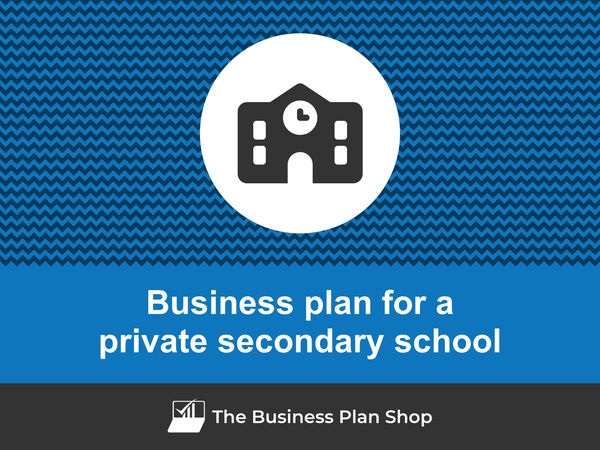
Putting together a business plan for a private secondary school can be daunting - especially if you're creating a business for the first time - but with this comprehensive guide, you'll have the necessary tools to do it confidently.
We will explore why writing one is so important in both starting up and growing an existing private secondary school, as well as what should go into making an effective plan - from its structure to content - and what tools can be used to streamline the process and avoid errors.
Without further ado, let us begin!
In this guide:
Why write a business plan for a private secondary school?
- What information is needed to create a business plan for a private secondary school?
- How do I build a financial forecast for a private secondary school?
The written part of a private secondary school business plan
- What tool should I use to write my private secondary school business plan?
Being clear on the scope and goals of the document will make it easier to understand its structure and content. So before diving into the actual content of the plan, let's have a quick look at the main reasons why you would want to write a private secondary school business plan in the first place.
To have a clear roadmap to grow the business
It's rarely business as usual for small businesses. The economy follows cycles where years of growth are followed by recessions, and the business environment is always changing with new technologies, new regulations, new competitors, and new consumer behaviours appearing all the time...
In this context, running a business without a clear roadmap is like driving blindfolded: it's dangerous at best. That's why writing a business plan for a private secondary school is essential to create successful and sustainable businesses.
To write an effective business plan, you will need to take stock of where you are (if you are already in business) and where you want the business to go in the next three to five years.
Once you know where you want your private secondary school to be, you'll have to identify:
- what resources (human, equipment, and capital) are needed to get there,
- at what pace the business needs to progress to get there in time,
- and what risks you'll face along the way.
Going through this process regularly is beneficial, both for startups and existing companies, as it helps make informed decisions about how best to allocate resources to ensure the long-term success of the business.
To get visibility on future cash flows
If your small private secondary school runs out of cash: it's game over. That's why we often say "cash is king", and it's crucial to have a clear view of your private secondary school's future cash flows.
So, how can you achieve this? It's simple - you need to have an up-to-date financial forecast.
The good news is that your private secondary school business plan already includes a financial forecast (which we'll discuss further in this guide). Your task is to ensure it stays current.
To accomplish this, it's essential to regularly compare your actual financial performance with what was planned in your financial forecast. Based on your business's current trajectory, you can make adjustments to the forecast.
By diligently monitoring your private secondary school's financial health, you'll be able to spot potential financial issues, like unexpected cash shortfalls, early on and take corrective actions. Moreover, this practice will enable you to recognize and capitalize on growth opportunities, such as excess cash flow enabling you to expand to new locations.
To secure financing
Crafting a comprehensive business plan for your private secondary school, whether you're starting up or already established, is paramount when you're seeking financing from banks or investors.
Given how fragile small businesses are, financiers will want to ensure that you have a clear roadmap in place as well as command and control of your future cash flows before entertaining the idea of funding you.
For banks, the information in your business plan will be used to assess your borrowing capacity - which is defined as the maximum amount of debt your business can afford alongside your ability to repay the loan. This evaluation helps them decide whether to extend credit to your business and under what terms (interest rate, duration, repayment options, collateral, etc.).
Similarly, investors will thoroughly review your plan to determine if their investment can yield an attractive return. They'll be looking for evidence that your private secondary school has the potential for healthy growth, profitability, and consistent cash flow generation over time.
Now that you understand the importance of creating a business plan for your private secondary school, let's delve into the necessary information needed to craft an effective plan.
Information needed to create a business plan for a private secondary school
Drafting a private secondary school business plan requires research so that you can project sales, investments and cost accurately in your financial forecast, and convince the reader that there is a viable commercial opportunity to be seized.
Below, we'll focus on three critical pieces of information you should gather before starting to write your plan.
Carrying out market research for a private secondary school
Before you begin writing your business plan for a private secondary school, conducting market research is a critical step in ensuring precise and realistic financial projections.
Market research grants you valuable insights into your target customer base, competitors, pricing strategies, and other crucial factors that can impact the success of your business.
In the course of this research, you may stumble upon trends that could impact your private secondary school.
You may find that potential students are increasingly interested in extracurricular activities. Market research could reveal that students may be looking for a school that provides a variety of activities, such as sports teams, clubs, or other experiential learning opportunities. Additionally, market research could indicate that parents may be looking for a school that provides a high-quality education, with a focus on technology and innovation. This could mean that students are interested in being equipped with the skills necessary to succeed in a rapidly changing world.
Such market trends play a pivotal role in revenue forecasting, as they provide essential data regarding potential customers' spending habits and preferences.
By integrating these findings into your financial projections, you can provide investors with more accurate information, enabling them to make well-informed decisions about investing in your private secondary school.
Developing the marketing plan for a private secondary school
Before delving into your private secondary school business plan, it's imperative to budget for sales and marketing expenses.
To achieve this, a comprehensive sales and marketing plan is essential. This plan should provide an accurate projection of the necessary actions to acquire and retain customers.
Additionally, it will outline the required workforce to carry out these initiatives and the corresponding budget for promotions, advertising, and other marketing endeavours.
By budgeting accordingly, you can ensure that the right resources are allocated to these vital activities, aligning them with the sales and growth objectives outlined in your business plan.
The staffing and capital expenditure requirements of a private secondary school
Whether you are starting or expanding a private secondary school, it is important to have a clear plan for recruitment and capital expenditures (investment in equipment and real estate) in order to ensure the success of the business.
Both the recruitment and investment plans need to be coherent with the timing and level of growth planned in your forecast, and require appropriate funding.
Staffing costs for a private secondary school might include the salaries of the headmaster, teachers, administrative staff, custodial staff, and cafeteria workers. Equipment costs might include the purchase of textbooks, scientific equipment, computers, furniture, and other supplies.
In order to create a realistic financial forecast, you will also need to consider the other operating expenses associated with running the business on a day-to-day basis (insurance, bookkeeping, etc.).
Once you have all the necessary information to create a business plan for your private secondary school, it is time to start creating your financial forecast.
What goes into your private secondary school's financial forecast?
The financial forecast of your private secondary school will enable you to assess the profitability potential of your business in the coming years and how much capital is required to fund the actions planned in the business plan.
The four key outputs of a financial forecast for a private secondary school are:
- The profit and loss (P&L) statement ,
- The projected balance sheet ,
- The cash flow forecast ,
- And the sources and uses table .
Let's take a closer look at each of these.
The projected P&L statement
Your private secondary school forecasted P&L statement enables the reader of your business plan to get an idea of how much revenue and profits your business is expected to make in the near future.
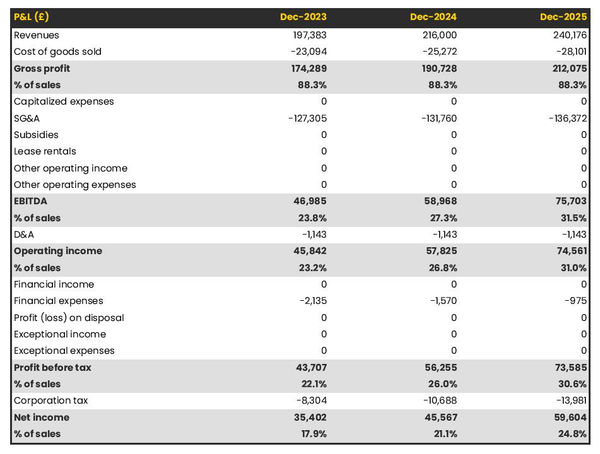
Ideally, your reader will want to see:
- Growth above the inflation level
- Expanding profit margins
- Positive net profit throughout the plan
Expectations for an established private secondary school will of course be different than for a startup. Existing businesses which have reached their cruising altitude might have slower growth and higher margins than ventures just being started.
The projected balance sheet of your private secondary school
Your private secondary school's forecasted balance sheet enables the reader of your plan to assess your financial structure, working capital, and investment policy.
It is composed of three types of elements: assets, liabilities and equity:
- Assets: represent what the business owns and uses to produce cash flows. It includes resources such as cash, equipment, and accounts receivable (money owed by clients).
- Liabilities: represent funds advanced to the business by lenders and other creditors. It includes items such as accounts payable (money owed to suppliers), taxes due and loans.
- Equity: is the combination of what has been invested by the business owners and the cumulative profits and losses generated by the business to date (which are called retained earnings). Equity is a proxy for the value of the owner's stake in the business.
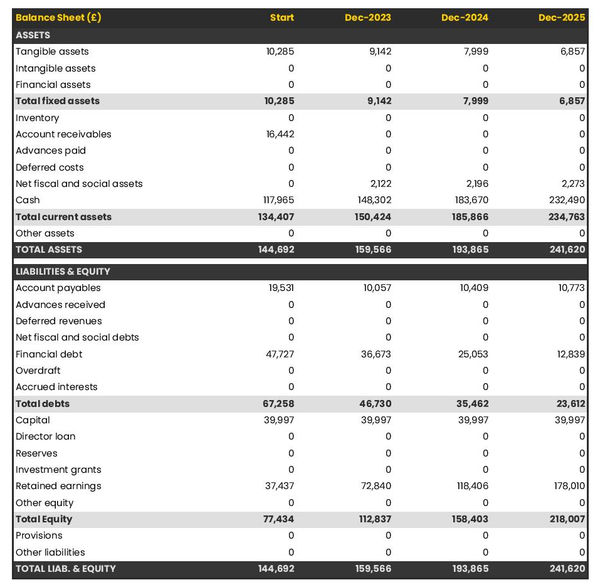
Your private secondary school's balance sheet will usually be analyzed in conjunction with the other financial statements included in your forecast.
Two key points of focus will be:
- Your private secondary school's liquidity: does your business have sufficient cash and short-term assets to pay what it owes over the next 12 months?
- And its solvency: does your business have the capacity to repay its debt over the medium-term?
The cash flow forecast
As we've seen earlier in this guide, monitoring future cash flows is the key to success and the only way of ensuring that your private secondary school has enough cash to operate.
As you can expect showing future cash flows is the main role of the cash flow forecast in your private secondary school business plan.

It is best practice to organise the cash flow statement by nature in order to show the cash impact of the following areas:
- Cash flow generated from operations: the operating cash flow shows how much cash is generated or consumed by the business's commercial activities
- Cash flow from investing activities: the investing cash flow shows how much cash is being invested in capital expenditure (equipment, real estate, etc.) either to maintain the business's equipment or to expand its capabilities
- Cash flow from financing activities: the financing cash flow shows how much cash is raised or distributed to financiers
Looking at the cash flow forecast helps you to make sure that your business has enough cash to keep running, and can help you anticipate potential cash shortfalls.
Your private secondary school business plan will normally include both yearly and monthly cash flow forecasts so that the readers can view the impact of seasonality on your business cash position and generation.
The initial financing plan
The sources and uses table or initial financing plan is a key component of your business plan when starting a private secondary school.
It shows where the capital needed to set up the business will come from (sources) and how it will be spent (uses).

This table helps size the investment required to set up the private secondary school, and understand how risks will be distributed between the business owners, and the financiers.
The sources and uses table also highlights what the starting cash position will be. This is key for startups as the business needs to have sufficient funding to sustain operations until the break-even point is reached.
Now that you have a clear understanding of what will go into the financial forecast of your private secondary school business plan, let's have a look at the written part of the plan.
The written part of a private secondary school business plan is composed of 7 main sections:
- The executive summary
- The presentation of the company
- The products and services
- The market analysis
- The strategy
- The operations
- The financial plan
Throughout these sections, you will seek to provide the reader with the details and context needed for them to form a view on whether or not your business plan is achievable and your forecast a realistic possibility.
Let's go through the content of each section in more detail!
1. The executive summary
The first section of your private secondary school's business plan is the executive summary which provides, as its name suggests, an enticing summary of your plan which should hook the reader and make them want to know more about your business.
When writing the executive summary, it is important to provide an overview of the business, the market, the key financials, and what you are asking from the reader.
Start with a brief introduction of the business, its name, concept, location, how long it has been in operation, and what makes it unique. Mention any services or products you plan to offer and who you sell to.
Then you should follow with an overview of the addressable market for your private secondary school, current trends, and potential growth opportunities.
You should then include a summary of your key financial figures such as projected revenues, profits, and cash flows.
Finally, you should detail any funding requirements in the ask section.
2. The presentation of the company
The second section in your private secondary school's business plan should focus on the structure and ownership, location, and management team of the company.
The structure and ownership part provides an overview of the legal structure of the business, who the owners are and how much each has invested and owns. If you are seeking financing it is important that the reader gets a clear picture of which legal entity is receiving the funds, and who controls the business.
The location part should give an overview of the premises from which the company is operating, and why that location is of particular interest (catchment area, accessibility, amenities nearby, etc.).
When describing the location of your private secondary school to a third party financier, you could emphasize the potential of the local market. You may point out the benefits of a major city nearby, such as potential access to a highly-educated workforce, businesses, and other resources. You could also mention the potential for a robust transportation network, which could help your school attract students from a wider region. Additionally, you might mention the potential of the area to attract students from outside of the area, as the local geography and climate could be attractive to prospective students.
Finally, you should introduce the management team. Explain each member's role, background, and experience.
It is also important to emphasize any past successes that the members of the management team have achieved, and how long they've been working together, as this will help potential lenders or investors understand why they should trust in their leadership.
3. The products and services section
The products and services section of your business plan should include a detailed description of what your company offers, who are the target customers, and what distribution channels are part of your go-to-market.
For example, your private secondary school might offer its customers a range of classes such as Advanced Placement (AP) courses, foreign language classes, and a variety of extracurricular activities. Additionally, the school might provide services such as guidance counseling, college admissions assistance, and mentoring programs. All of these offerings would help to ensure that students are well prepared for life after graduation.
4. The market analysis
When presenting your market analysis in your private secondary school business plan, you should detail the customers' demographics and segmentation, target market, competition, barriers to entry, and any regulations that may apply.
The goal of this section is to help the reader understand how big and attractive your market is, and demonstrate that you have a solid understanding of the industry.
You should start with the demographics and segmentation subsection, which gives an overview of the addressable market for your private secondary school, the main trends in the marketplace, and introduces the different customer segments and their preferences in terms of purchasing habits and budgets.
The target market section should follow and zoom on the customer segments your private secondary school is targeting, and explain how your products and services meet the specific needs of these customers.
For example, your target market might include affluent families who are willing to invest in their children's education and want them to attend a private school. These parents might value the quality of education, the smaller class sizes, and the extracurricular activities that a private school can offer. They would be likely to be willing to pay a premium for these features.
Then comes the competition subsection, where you should introduce your main competitors and explain what differentiates you from them.
Finally, you should finish your market analysis by giving an overview of the main regulations applicable to your private secondary school.
5. The strategy section
When you write the strategy section of your private secondary school business plan, remember to cover key elements such as your competitive edge, pricing strategy, sales & marketing plan, milestones, and risks and mitigants.
In the competitive edge subsection, elaborate on what makes your company stand out from competitors. This becomes especially important if you're a startup, aiming to carve a place for yourself amidst established players in the marketplace.
The pricing strategy subsection should demonstrate how you plan to maintain profitability while offering competitive prices to attract customers.
Outline your sales & marketing plan, detailing how you'll reach out to new customers and retain existing ones through loyalty programs or special offers.
For the milestones subsection, outline your company's achievements to date and your main objectives for the future, complete with specific dates to set clear expectations for progress.
Lastly, the risks and mitigants subsection should address the main risks that could affect your plan's execution. Explain the measures you've put in place to minimize these risks, assuring potential investors or lenders.
Your private secondary school may face a variety of risks. For example, it could be at risk of financial losses if there is a decrease in enrollment numbers. Additionally, it might be vulnerable to cyber-attacks if its online systems are not properly secured. Adequate security measures and contingency plans should be in place to protect the school from these potential risks.
6. The operations section
The operations of your private secondary school must be presented in detail in your business plan.
Begin by addressing your staff, specifying the main roles and your recruitment plan to support the anticipated growth. Outline the qualifications and experience needed for each role and discuss your recruitment strategies, which may involve using job boards, referrals, or headhunters.
Next, clearly state your private secondary school's operating hours, allowing the reader to gauge the adequacy of your staffing levels. Additionally, mention any considerations for varying opening times during peak seasons and your approach to handling customer queries outside regular operating hours.
The key assets and intellectual property (IP) required to run your business should also be highlighted. If you rely on licenses, trademarks, physical structures like equipment or property, or lease agreements, ensure they are well-documented in this section.
Your private secondary school might have two key assets and forms of intellectual property: its proprietary curriculum and its brand. The curriculum could be a unique blend of traditional and innovative teaching methods that are tailored to the specific needs and goals of the school. It may also include a variety of resources to support students in their learning. Additionally, the school may have cultivated its own brand and image that differentiate it from other educational institutions. This might include a recognizable logo, mascot, mission statement, and other distinguishing characteristics.
Finally, provide a comprehensive list of suppliers you intend to collaborate with, along with a breakdown of their services and main commercial terms, such as price, payment terms, break clauses and contract duration. Investors often seek insight into the reasons behind your supplier choices, which may include a preference for higher-quality products or established relationships from past ventures.
7. The presentation of the financial plan
The financial plan section is where we will include the financial forecast we talked about earlier in this guide.
Now that you have a clear idea of the content of a private secondary school business plan, let's look at some of the tools you can use to create yours.
What tool should I use to write my private secondary school's business plan?
In this section, we will be reviewing the two main solutions for creating a private secondary school business plan:
- Using specialized online business plan software,
- Outsourcing the plan to the business plan writer.
Using an online business plan software for your private secondary school's business plan
Using online business planning software is the most efficient and modern way to create a private secondary school business plan.
There are several advantages to using specialized software:
- You can easily create your financial forecast by letting the software take care of the financial calculations for you without errors
- You are guided through the writing process by detailed instructions and examples for each part of the plan
- You can access a library of dozens of complete business plan samples and templates for inspiration
- You get a professional business plan, formatted and ready to be sent to your bank or investors
- You can easily track your actual financial performance against your financial forecast
- You can create scenarios to stress test your forecast's main assumptions
- You can easily update your forecast as time goes by to maintain visibility on future cash flows
- You have a friendly support team on standby to assist you when you are stuck
If you're interested in using this type of solution, you can try The Business Plan Shop for free by signing up here .
Hiring a business plan writer to write your private secondary school's business plan
Outsourcing your private secondary school business plan to a business plan writer can also be a viable option.
Business plan writers are experienced in writing business plans and adept at creating financial forecasts without errors. Furthermore, hiring a consultant can save you time and allow you to focus on the day-to-day operations of your business.
However, hiring business plan writers is expensive as you are paying for the software used by the consultant, plus their time, and their profit margin of course.
From experience, you need to budget at least £1.5k ($2.0k) excluding tax for a complete business plan, more if you need to make changes after the initial version (which happens frequently after the initial meetings with lenders or investors).
You also need to be careful when seeking investment. Investors want their money to be used to grow the business, not spent on consulting fees. Therefore, the amount you spend on business plan writing services (and other consulting services such as legal services) needs to be negligible relative to the amount raised.
The other drawback is that you usually don't own the business plan itself: you just get the output, while the actual document is saved in the consultant's business plan software - which makes it difficult to maintain the document up to date without hiring the consultant on a retainer.
For these reasons, outsourcing the private secondary school business plan to a business plan writer should be considered carefully, weighing both the advantages and disadvantages of hiring outside help.
Ultimately, it may be the right decision for some businesses, while others may find it beneficial to write their business plan using online software.
Why not create your private secondary school's business plan using Word or Excel?
Using Microsoft Excel and Word (or their Google, Apple, or open-source equivalents) to write a private secondary school business plan is not advisable. Allow me to explain the reasons.
Firstly, creating an accurate and error-free financial forecast on Excel or any spreadsheet demands technical expertise in accounting principles and financial modelling. Without a degree in finance and accounting and significant financial modelling experience, it's unlikely that the reader will fully trust your numbers.
Secondly, relying on spreadsheets is inefficient. While it may have been the go-to option in the past, technology has evolved, and software now performs such tasks much faster and more accurately.
The second reason is that it is inefficient. Building forecasts on spreadsheets was the only option in the early 2000s, nowadays technology has advanced and software can do it much faster and much more accurately.
And with the rise of AI, software is also becoming smarter at helping us detect mistakes in our forecasts and helping us analyse the numbers to make better decisions.
Moreover, software offers ease in comparing actuals versus forecasts and maintaining up-to-date forecasts for clear visibility on future cash flows, as we discussed earlier in this guide. Such tasks are cumbersome when using spreadsheets.
Now, let's address the written part of your private secondary school business plan. While it may be less prone to errors, using software can significantly boost productivity. Word processors lack instructions and examples for each section of your business plan. They also won't automatically update your numbers when changes occur in your forecast, and they lack automated formatting capabilities.
In summary, while some entrepreneurs may consider Word or Excel for their business plan, it's far from the best or most efficient solution when compared to specialized software.
- A business plan has 2 complementary parts: a financial forecast showcasing the expected growth, profits and cash flows of the business; and a written part which provides the context needed to judge if the forecast is realistic and relevant.
- Having an up-to-date business plan is the only way to keep visibility on your private secondary school's future cash flows.
- Using business plan software is the modern way of writing and maintaining business plans.
We hope that this practical guide gave you insights on how to write the business plan for your private secondary school. Do not hesitate to get in touch with our team if you still have questions.
Also on The Business Plan Shop
- In-depth business plan structure
- Key steps to write a business plan?
- Free business plan template
Know someone who owns or wants to start a private secondary school? Share this article with them!

Founder & CEO at The Business Plan Shop Ltd
Guillaume Le Brouster is a seasoned entrepreneur and financier.
Guillaume has been an entrepreneur for more than a decade and has first-hand experience of starting, running, and growing a successful business.
Prior to being a business owner, Guillaume worked in investment banking and private equity, where he spent most of his time creating complex financial forecasts, writing business plans, and analysing financial statements to make financing and investment decisions.
Guillaume holds a Master's Degree in Finance from ESCP Business School and a Bachelor of Science in Business & Management from Paris Dauphine University.
Create a convincing business plan
Assess the profitability of your business idea and create a persuasive business plan to pitch to investors

500,000+ entrepreneurs have already tried our solution - why not join them?
Not ready to try our on-line tool ? Learn more about our solution here
Need some inspiration for your business plan?
Subscribe to The Business Plan Shop and gain access to our business plan template library.

Need a professional business plan? Discover our solution
Write your business plan with ease!

It's easy to create a professional business plan with The Business Plan Shop
Want to find out more before you try? Learn more about our solution here
34+ SAMPLE School Business Plan in PDF | MS Word | Google Docs | Apple Pages
School business plan | ms word | google docs | apple pages, 34+ sample school business plan, what is a school business plan, benefits of a school business plan, how to write a school business plan, why are the mission statement and vision statement important, what is the use of school business plan.
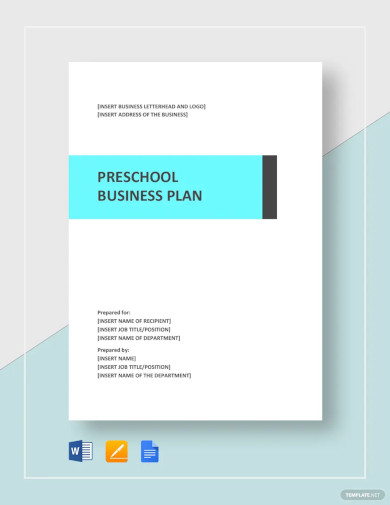
Preschool Business Plan Template
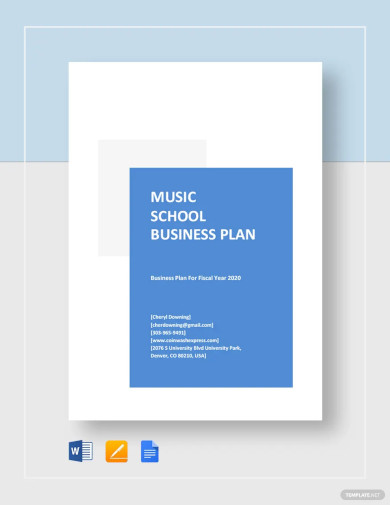
Music School Business Plan Template
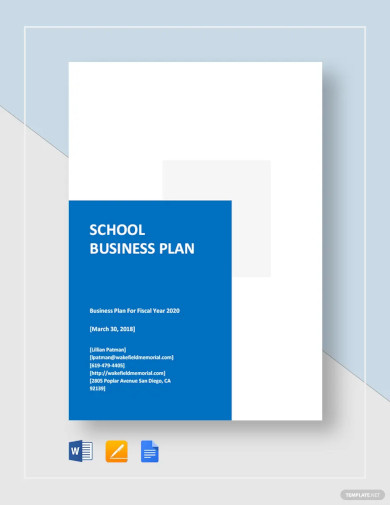
School Business Plan Template
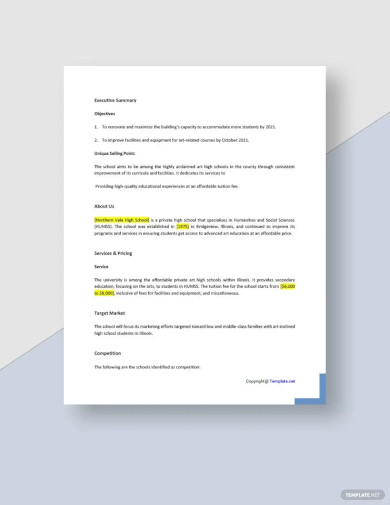
Free Basic School Business Plan Template
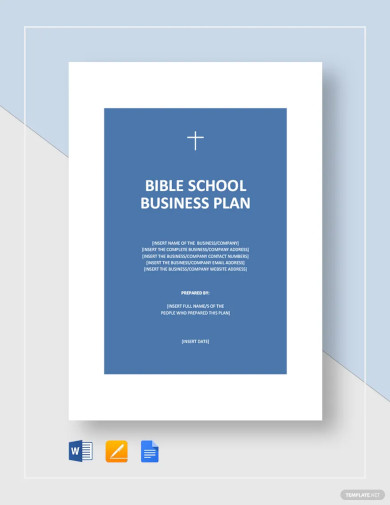
Bible School Business Plan Template
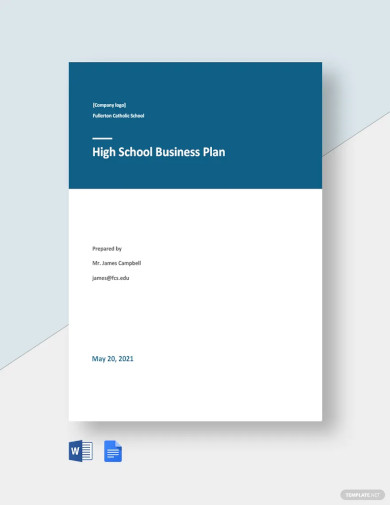
High School Business Plan Template
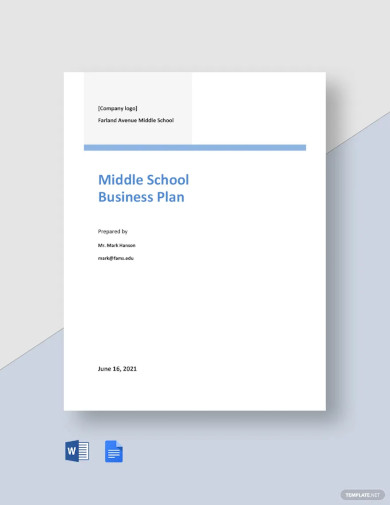
Middle School Business Plan Template
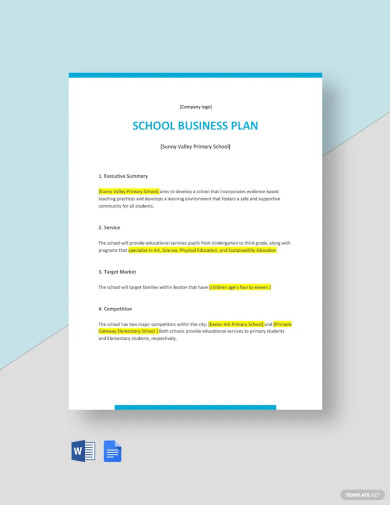
One Page School Business Plan Template
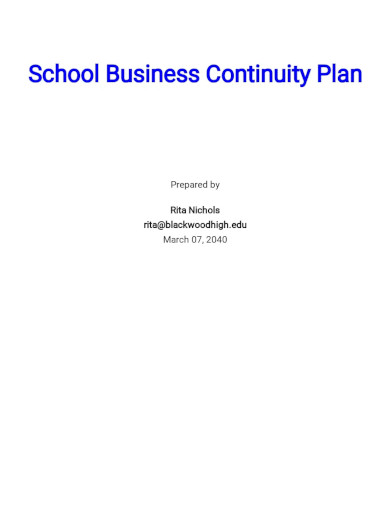
School Business Continuity Plan Template
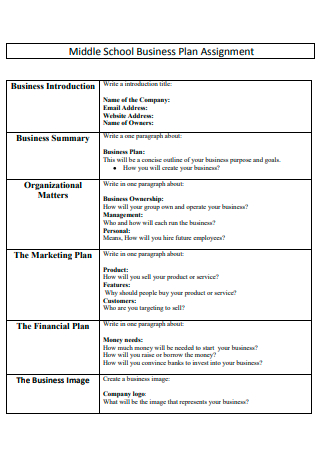
Middle School Business Plan Assignment

Sample Primary School Business Plan

School Business Plan in PDF
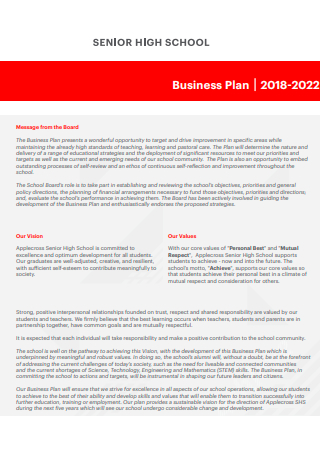
Senior High School Business Plan
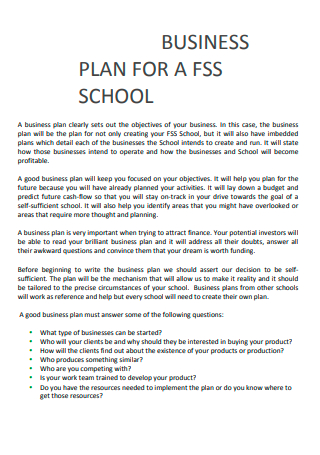
Non-Profit School Business Plan
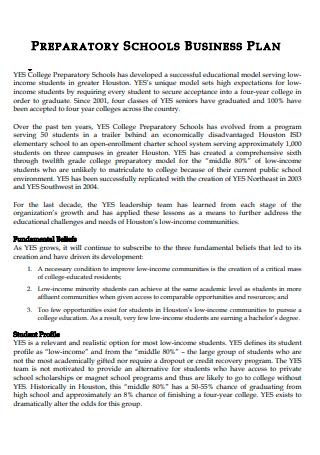
Sample Kindergarten School Business Plan
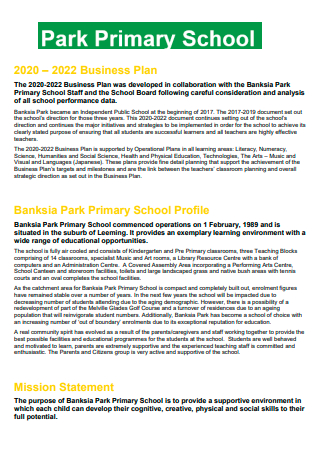
Park Primary School Business Plan

School Business Plan Executive Summary
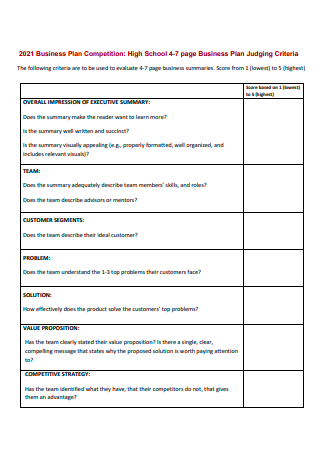
School Business Plan for Students
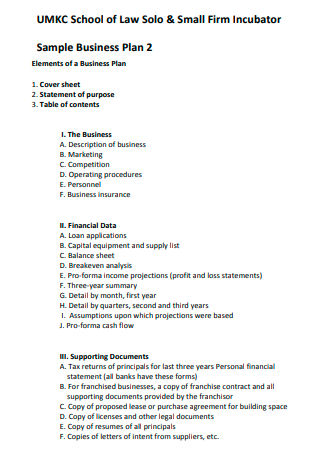
School Budget Business Plan
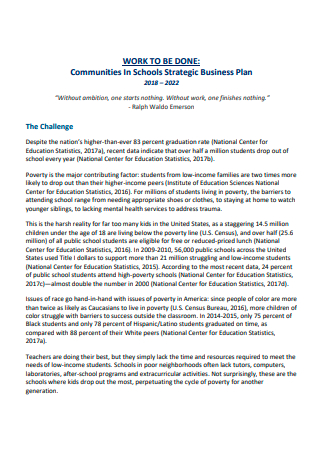
Sample School Funding Business Plan
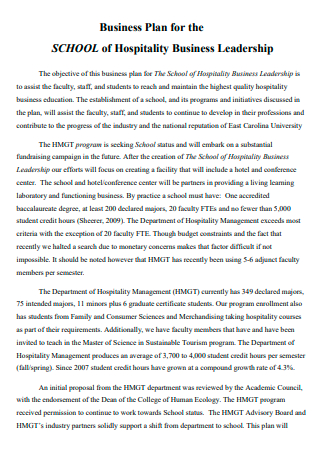
School Project Business Plan
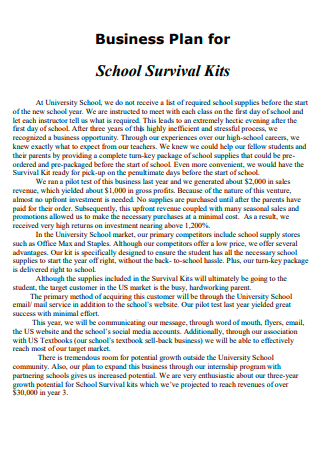
School Vocational Business Plan

School of Creative Music Education Business Plan
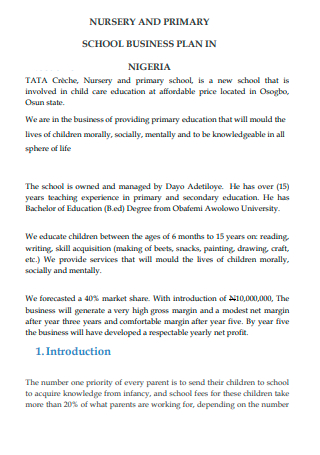
Nursery and Primary School Business Plan

Temple Community After School Program Business Plan
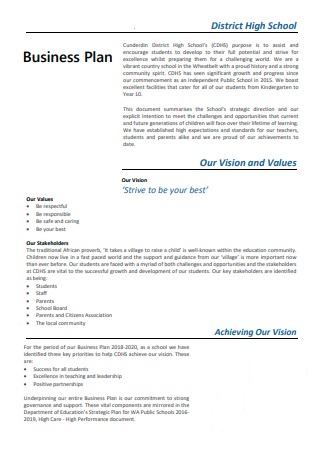
Sample Preschool Business Plan
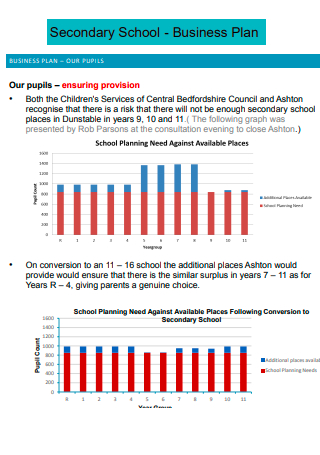
Secondary School Business Plan
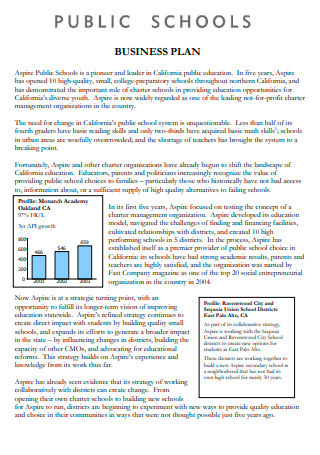
Public School Business Plan
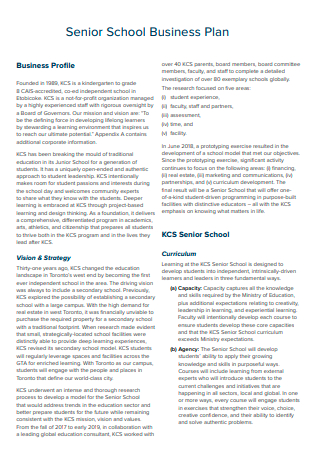
Sample Senior School Business Plan

School Education Business Plan
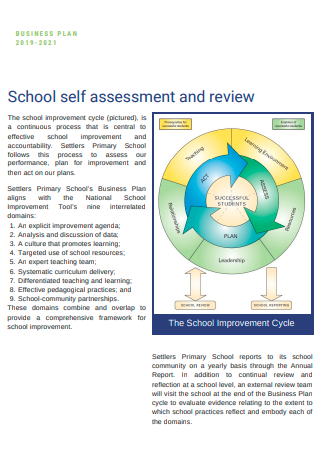
School Self Assessment and Review Business Plan
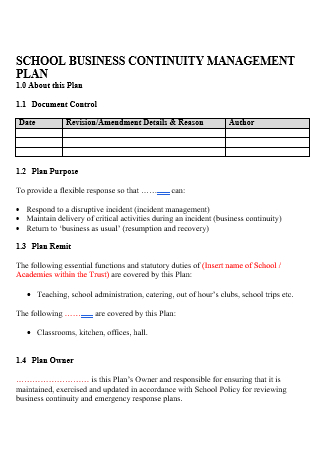
School Business Continuity Management Plan
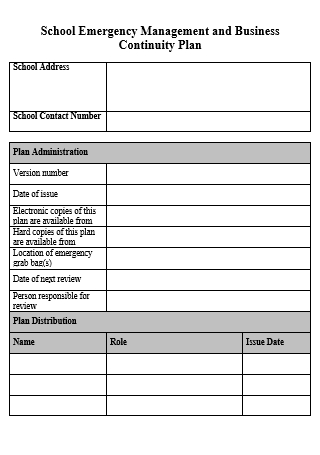
School Emergency Management and Business Continuity Plan
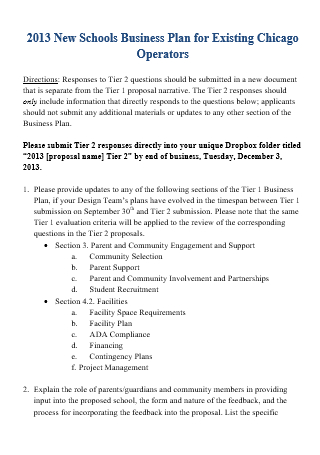
New School Business Plan
Step 1: school overview, step 2: executive summary, step 3: school services.
- Literacy services
- Numeracy services
- Meeting accreditation standards
- Foundations in science and mathematics
- Foundations in geography and history
- Giving extracurricular activities
- Giving books and school materials
Step 4: Mission Statement and Vision Statement
Step 5: job description, step 6: swot analysis.
- Strengths – What is the ace of your school against your competitors?
- Weaknesses – On what aspects are your school lacking?
- Opportunities – Where does your school excel in teaching?
- Threats – What can make a student leave your school?
Step 7: Market Research
Step 8: sales plan, step 9: publicity plan, step 10: school budget, share this post on your network, file formats, word templates, google docs templates, excel templates, powerpoint templates, google sheets templates, google slides templates, pdf templates, publisher templates, psd templates, indesign templates, illustrator templates, pages templates, keynote templates, numbers templates, outlook templates, you may also like these articles, 5+ sample investment company business plan in pdf.

What do you do when you have tons of spare cash lying around your home or burning a hole in your wallet or expensive jeans pocket? For some people, the…
41+ SAMPLE Unit Plan Templates in PDF | MS Word

As a teacher, you might know about every school policy, the steps to keep classrooms safe for intellectual development, how to set up an organized classroom, and the proposed…
browse by categories
- Questionnaire
- Description
- Reconciliation
- Certificate
- Spreadsheet
Information
- privacy policy
- Terms & Conditions
How to Start a Private School PDF; Private School Business Plan Sample
How to Start a School Business - Private School Business Plan Sample PDF
Are you considering starting a School and are in need of a private school business plan? if yes, you'll find this free book to be extremely helpful.
This is a practical guide that will walk you step by step through all the essentials of starting your business. The book is packed with guides, worksheets and checklists. These strategies are absolutely crucial to your business' success yet are simple and easy to apply.
Don’t Start a New School Business Unless You Watch This Video First!
Checklist for Starting a Business: Essential Ingredients for Success
If you are thinking about going into business, it is imperative that you watch this video first! it will take you by the hand and walk you through each and every phase of starting a business. It features all the essential aspects you must consider BEFORE you start a business. This will allow you to predict problems before they happen and keep you from losing your shirt on dog business ideas. Ignore it at your own peril!
Here’s a Valuable Free Gift for You This is a high quality, full blown business plan template complete with detailed instructions and all related spreadsheets. You can download it to your PC and easily prepare a professional business plan for your business. Click Here! To get your free business plan template
The Single Most Important Ingredient for Business Success
The first and most important thing you need to acquire in order to succeed in a small business is... knowledge.
Sounds exaggerated? Listen to this...
According to research conducted by Dun & Bradstreet, 90% of all small business failures can be traced to poor management resulting from lack of knowledge.
This is backed up by my own personal observations. In my 31 years as a business coach and consultant to small businesses, I've seen practically dozens of small business owners go under and lose their businesses -- not because they weren't talented or smart enough -- but because they were trying to re-invent the wheel rather than rely on proven, tested methods that work.
Conclusion: if you are really serious about succeeding in a business... If you want to avoid the common traps and mistakes... it is absolutely imperative that you acquire the right knowledge.
"Why Invent Mediocrity, When You Can Copy Genius?"
That's an excellent quote I picked up from a fellow business owner a few years back. What this means is that you should see what is working and try to duplicate Printing Business. Why go through all the trouble of inventing something new, that you don't even know will ever work, when you can easily learn from and duplicate something that has been a proven success?
[ Note: One of the BIGGEST mistakes almost all new businesses make is that they WASTE tons of valuable time, energy and money on trying to create something "new", that has never been tested or proven... only to find out later that it was a total loss. Don't make the same mistake! ]
Hi! My name is Meir. I'm the founder and president of BizMove.com, a successful internet based information business. I'm also the author of numerous books, mostly in the area of small business management.
I've been involved in small business for the past 31 years of my life, as a business coach, manager of a consulting firm, a seminar leader and as the owner of five successful businesses.
During my career as a business coach and consultant I've helped dozens of business owners start their businesses, market, expand, get out of troubles, sell their businesses and do practically every other small business activity you can think of. You see, I have been there .... done it ... and bought the Small Business t-shirt! -- This free book contains techniques and strategies I've learned during my 31 year small business career.
Here's what you'll discover in the 'How to Start a Printing Business' book:
Success Tip: Setting Goals
Good management is the key to success and good management starts with setting goals. Set goals for yourself for the accomplishment of the many tasks necessary in starting and managing your business successfully. Be specific. Write down the goals in measurable terms of performance. Break major goals down into sub-goals, showing what you expect to achieve in the next two to three months, the next six months, the next year, and the next five years. Beside each goal and sub-goal place a specific date showing when it is to be achieved.
Plan the action you must take to attain the goals. While the effort required to reach each sub-goal should be great enough to challenge you, it should not be so great or unreasonable as to discourage you. Do not plan to reach too many goals all at one time.
Establish priorities. Plan in advance how to measure results so you can know exactly how well you are doing. This is what is meant by "measurable" goals. If you can’t keep score as you go along you are likely to lose motivation. Re-work your plan of action to allow for obstacles which may stand in your way. Try to foresee obstacles and plan ways to avert or minimize them.
Click here! to download your school business plan PDF book for free
Management Skills Video: How to Become a Great Manager and Leader
Learn how to improve your leadership skills and become a better manager and leader. Here's how to be the boss people want to give 200 percent for. In the following video you'll discover 120 powerful tips and strategies to motivate and inspire your people to bring out the best in them.
For more insightful videos visit our Small Business and Management Skills YouTube Chanel .
Here're other free books in the "how to start a business" series that may interest you:
Here's a Sample 'Executive Summary' for a School Business plan :
COMPANY NAME will provide private school services in quantitative courses, starting the first school in the Atlanta, Georgia area. Focused primarily on students in grades K-6, classes are available in courses including: history, science, geography and mathematics in addition to multiple languages, religions and philosophy COMPANY NAME will focus primarily on Eastern Indian, Asian and European based language and philosophy to start. This method will be focused on to ensure that students can study their native language and learn native customs from where they or their families come from. Teaching sessions focus on helping students grasp the concepts they will need to know to perform well in their class, as well as developing study strategies to effectively prepare for exams in their class. A long-term focus of empowering students is favored over a short-term problem-solving strategy. High tuition, schools claim, is used to pay higher salaries for the best teachers and also used to provide enriched learning environments, including a low student to teacher ratio, small class sizes and services, such as libraries , science laboratories and computers . Service Summary The intention is to create a student who is an international citizen who is academically capable, gain successful admission to Ivy League schools and to the best international universities; however while at the same time developing a confidence gained from knowing their family heritage, roots, history, culture, religion and languages. Each student will be having a sense of pride in being an American and also in being of Indian origin harmoniously. COMPANY NAME projects that 50% of students will be Asian Indian decent and 50% of students will be Americans seeking to get the best education available in the United States. COMPANY NAME is planning to become an International Baccalaureate World School. By receiving this support from a worldwide education organization, the school will be on the roster of offering courses transferable and also recognized around the world. Market Analysis Summary While there are cultural and language classes that children of Indian origin can attend outside of the regular school curriculum, there is no comprehensive school, which offers an excellent education along with meeting their cultural needs anywhere in the USA. Vision COMPANY NAME vision is to provide world-class education for its students at playschool, kindergarten, primary school levels. The aim of this educational institute is the quest for truth; blending the methods of learning of the East and West COMPANY NAME seeks to help bring to the United States the highest education possible to help children be able to compete with the world, as the American education standards and results continue to decline.
- American students rank 25th in math and 21st in science compared to students in 30 industrialized countries.
- America’s top math students rank 25th out of 30 countries when compared with top students elsewhere in the world.
- By the end of 8th grade, U.S. students are two years behind in the math being studied by peers in other countries.
- Sixty eight percent of 8th graders can’t read at their grade level, and most will never catch up.
Resource: http://www.bls.gov It will be a school for a diverse student body with a global faculty and an international curriculum. The Foundation believes its particular location in the USA will give the community of learners an incredible opportunity to examine change, explore the interconnectedness of issues and develop a global perspective. COMPANY NAME will offer an educational experience that is truly international and still Indian at heart. The Foundation will invite the Council of International Schools (CIS) and other prominent educationists to be its' consultants. Together with experienced consultants' input, COMPANY NAME shall attract an inspiring faculty and student body.
1.1 Objectives
- Generate five informal contracts/referrals with school professors from accredited private schools located in India.
- Increase revenue steadily from 2011 to 2012.
- Offer a premiere and unique educational hub where children can learn several languages, receive higher education and expand life's horizons from an early age.
COMPANY NAME's vision is to provide world-class education for students at playschool, kindergarten, primary school levels. The aim of this educational institute is the quest for truth, blending the methods of learning of the East and West. It will be a school for a diverse student body, with a global faculty and an international curriculum COMPANY NAME believe that their particular location in the USA will give the community of learners an incredible opportunity to examine change, explore the interconnectedness of issues and develop a global perspective.
1.2 Mission
COMPANY NAME exists to help students. The Company takes a unique and innovative approach to teaching that helps students connect with the subject matter they need to master in a vast variety of subjects, religions and arts. Through personalized and focused teaching processes, the students develop the tools they need for ongoing success in their fields of study, which include international languages as well. Success depends on direct attention to the needs of the Company's clients and truly helping them achieve- COMPANY NAME won't succeed unless their clients succeed.
COMPANY NAME is a sole proprietorship. The company will be owned and operated by COMPANY NAME which is 100% owned by OWNER’S NAME, a C Corporation. The foundation will be co-owned by CO-OWNER’S NAME and another general partner.
2.2 Start-up Summary
The company founders will hire an education consulting and management firm to handle day-to-day operations of the business and will work collaboratively to ensure that this business venture is a success. COMPANY NAME will be seeking to attain start-up funds from a combination of investment capital and grant funding sources. Surplus revenue from fundraising is detailed in the Sales Forecast table later in this plan. The following table and chart show the start-up costs for COMPANY NAME.
Table: Start-up
3.0 Services
The school will offer a unique and philosophical approach to education to provide for intellectual, emotional and spiritual development of every student. The school aims to provide an environment conducive to students to discover and nurture the best in their own nature. The school will accept and care for students from all the major faiths, as well as for those with no particular religious affiliation. The intention is to create a student who is an international citizen who is academically capable, gain successful admission to Ivy League schools and to the best international universities; however while at the same time developing a confidence gained from knowing their family heritage, roots, history, culture, religion and languages. Each student will be having a sense of pride in being an American and also in being of Indian origin harmoniously. COMPANY NAME will also be providing extensive extra-curricular activities for students such as providing dance, art, culture and language courses so that students can attain and utilize the tools and education all in one place. This will be especially appealing to parents as this will improve not only the child’s education but by having all available in one location, it will also improve quality of life for families. COMPANY NAME has future plans for utilizing the 30 acre plot of land and real estate that The Company is trying to acquire by installing a soccer field, a baseball field and a teacher/student vegetable and herb garden for education purposes. In addition, the auditorium and smaller classroom will be rented out to increase the schools revenue. Becoming A Better Leader At The Workplace Leadership can be difficult to quantify, despite the fact that most people desperately wish to understand what it takes to be a strong leader. To really get a handle on the concept, it pays to spend some time researching and studying. The guidance below is intended to help any burgeoning leader do precisely that. When working to improve in the area of leadership, it is vital that you develop competency. People need to trust that you know what you are doing in order to feel confident in your leadership ability. Instill confidence in those who follow you by finding a mentor to help you become truly proficient in what you do. If you are rolling out a new business process, train your employees effectively. That new business process might look all shiny on paper, but if your subordinates receive insufficient, or worse, no training, it will inevitably cost you money down the road. There are ways to make training relatively painless, so do your research. Don't make the mistake of ordering people around. That is not true leadership. The key to true leadership is to inspire those around you. You need to help them find their own voices, so that they can go on to lead others. The entire journey they take with you is about their ability to know themselves better. If you have an employee that goes above and beyond the call of duty, do not hesitate to give them extra praise and rewards. Even though it may seem like you are playing favorites, you are giving them what they deserve. be open with other employees about it so they are aware of what rewards come with hard work. Know your competition just as well as you know your own company. Business isn't just about what's happening between the walls in your space. You need to make decisions based off competitive movement. If you can't make decisions because you don't know the competition, then expect your employees to see it as a weakness in leadership. Conquer your fear. Fear can be a terrible thing for you to experience, especially if you're a leader. Instead, start paying attention to what the fear is telling you. Learn to process it in a way that is healthy and in a way that urges you to move beyond the fear to something more. Be open to new ideas, perspectives, and ways of doing things. Many companies want to constantly repeat something that has proven successful for them. There is little wrong with that, but inadvertent leaders try putting too much effort into one thing that worked. Thoughtful leadership should acknowledges success, while also recognizing that there are ways to improve. Do not push people on your team too hard since this can result in doing the opposite of what you are trying to accomplish. Instead of giving them motivation to do more work, it may make them feel demoralized. In turn, they will lose a lot of respect for you. Do not be afraid to jump in and help. This is much easier if you work on site with your team, but is possible from afar if you are creative. If any person from your team needs help, jump in and give them a hand. You may learn a lot from the experience. One of the best leadership skills to develop is listening to people who work under you. By listening to your employees, you can learn new ways to reach goals. When you see that they have processed your ideas, keep an open mind for their input to maximize your potential for success. You might feel like starting each day or shift with a motivational speech, but this can get old for your crew quickly. As a matter of fact, such tactics are overrated. The biggest impact you make in terms of personnel is who you hire, who gets fired, and who gets assigned to the big projects. Learn how to laugh. Yes, you've got a serious job with a lot of responsibilities, but leadership isn't born out of tension and stress. Sometimes you need to learn how to lighten the mood. Not just for yourself, but for your employees too. If you've hit some rough patches, it's your responsibility as a leader to help your team get out of it. Don't hesitate to recognize people for their accomplishments. It is easy to forget to thank people for what they do, especially in a work environment where everything is moving quickly. Make sure you look for reasons to thank people for their good work, instead of simply chiding them when they make mistakes. This will encourage loyalty, and you will find you have an easier time leading when those you lead are loyal. Be an honest and ethical role model for your employees. Honesty with your employees is the best way to build trust. Make sure your employees understand the ethical expectations you have for them. More than that, always behave in an ethical way yourself. If your employees observe you behaving dishonestly, they will do so as well. Be a good example for your team. Just like the parents of a family, you are who your team looks up to in your organization. Do not talk negatively about the company you work for or your bosses to your team. It sets a horrible example and may come back to haunt you. A good leader turns a mistake into a learning experience. Talking about what didn't go right and being open with the entire team about this incident can help everyone from making that same mistake later. Most people wish to be effective leaders of others, but very few actually succeed in doing so. One of the most effective methods of acquiring true leadership acumen is to learn as much as possible about those who have gone before and the attributes they had in common. The article above can serve as an ongoing resource for anyone wishing to undertake just that sort of study.
Copyright © by Bizmove Free Business Guides. All rights reserved.

Starting a School in India – Business Plan, Procedure & Cost Estimation

Schools in India come under the Non-Profit Organizations and are registered under the section 8 of the Companies Act 2013. One can also open a school under the Societies Act of 1860. Opening a school in India depends on various laws regulated both by the center and the state. It also depends where you are starting your school and which board of education you are adopting. Here is a brief guide on how to start a school and its cost estimation in India.
Make a Brief Blueprint of Your School
There are various factors involved in the opening of a school in India. The first important point is that there are various levels of categorizations on which a school is opened. Schools can be for lower KG, upper KG, from class 1 to 6 or from 1 to 8, from class 1 to class 10 or from class 1 to class 12 th . If the class exceeds up to 9-12 th then you require your school to be registered from a certain board operating in India. Opening a school also depends on the place where you are starting your school. If you are opening your school in metro cities then there are different rules whereas opening school in towns or rural areas require different categorization.
Based on all such issues here is the list of issues that must be address while opening a school in India.
Requirement of Land for Starting a School
One definitely needs a good space to open up a school. Requirement of land depends on two factors. The first factor is the status of the place where you want to open the school. For example, the minimum requirement for opening a school in metropolitan city is different from that of a town or rural area. The second factor is the board through which your school is affiliated. There are basically 4 boards that majorly operate in India. They are:
- Central Board of Secondary Education (CBSE)
- Council for the Indian School Certificate Examination (ISC/ICSE)
- International Board (IB)
- State Boards of 29 States in India
Requirement of Land Based on Place and Board: CBSE Board
- In a Metropolitan City: If you want to open up a school in cities like Delhi, Kolkata, Mumbai, Chennai or Bangalore then you need to have a minimum requirement of 1 Acre land or 4000 sq. meter of land for operating school from pre-primary to class 12 th . For operating school from pre-primary to class 10 th you need to have at least half an acre of land or 2000 sq. meters of land.
- City with the Population of more than 15 Lakhs: From Pre-primary to class 12 th a minimum requirement of 1 acres of land or 2047 sq. meters of land
- Other Cities: A minimum of 1.5 acres of land is required to run a school in small cities based on CBSE norms.
CBSE also caters a category level for schools like A+, A and B category schools. An A+ category schools should have permanent affiliation with land area not less than 2 acres.
Requirement of Land Based on Place and Board: CISCE
For a school affiliated to CISCE, a minimum requirement of 2000 sq. meter of land is necessary with each classrooms to be not less than 400 sq. feet in size.
State boards have their own requirement which can be read on their respective websites.
Construction of School Building
Based on the board guidelines school building should be constructed. Like a minimum class size should be of 400 sq. feet with a library, arts room, amphitheater, science lab, computer lab, stage, playground, etc.
Starting a School and NOC
After the construction of school building is over it is time to open the school. For this there are various process through which one has to go. The first requirement is to get a Non objection certificate from the state government. Only after getting an NOC you can operate your school. Many schools are operating in India without NOC and one should avoid going by that method as at the time of applying for affiliation you will be asked for NOC.
To apply for NOC you need to visit the state education department where there are different departments from where you need clearance. The method is transparent and it requires some basic documents like land details, land size, budget, etc.
Affiliation to Board
A minimum of one years of operation is required for schools to apply for CISCE and CBSE board while for IB it is three years. Before that you can open your school from pre-primary to class 8 th but only after the school is operational from more than a year it will get affiliation. The respective boards also have their rules and parameters based on which they grant permission like land size, building construction, classroom size, playground, number of teacher, teacher’s qualification, EPF account, and other criteria mentioned in the board’s guideline that you can access on their website.
Setting up of School Structure
From appointment of Principal, head master, Vice Principal, associate teacher, assistant teacher, accounts department, lab assistants, computer experts, peons, supportive staffs, drivers, etc. to organizing each class, arranging infrastructure and furniture, purchasing basic devices, buying books for library, setting up of science lab, apparatus, models, computer labs, etc. requires a lot of time and capital. You have to do all of them. Try to go slow with time as setting up everything at once is neither possible not it is viable.
Appointment of Teacher and Principal
If you are going to apply for affiliation for any board then you must appoint teacher based on their parameters. There is a basic qualification requirement for each board like a teacher must be a post graduate, qualified NET, CTET, NTT, PGT, PTI, TGT, and B.Ed. For the appointment of principal many boards require at least a B.Ed. in addition to Masters. M.Phil. graduates are also the most viable candidates for the post of Principal.
Setting up of Accounts and EPF for Your Staff
An organization with more than 19 staffs should have a must EPF account. Nowadays every school wants their staffs to have a bank account where monthly salary is transferred. CISCE board also requires a mandatory condition of having EPF account of each staff for affiliation process.
Admission of Students and Parameters
Admission of student invites a test which is conducted by the school administration. The board also gives a standard which must be followed to admit students. Not more than 45 students be there in each classroom. Try to start your school slowly from lower KG and increase gradually to standard 8 th and beyond. Parameters like a definite school uniform, school curriculum, syllabus, rules and regulation must be set up.
Fees Structure
You can decide the fees based on your expense and place of school. Based on the per capita income in the region you can determine the school fees. Private schools in metropolitan cities charge whooping sum of money per month. Determine the fees after taking advice from learned management graduates.
Cost of Starting a School in India
If you are planning to start a pre-nursery school then cost will be quite less. For a well structure affiliated school, startup cost estimation is quite huge. Take at least 2 crores a minimum sum to start your school and it can go further based on the place of operation, living standard, etc. Setting up a standard school will have its own implications like money spent in arranging furniture, gadgets, electronics, computer, maintenance, and other requirements.
Time Investment
Running a school requires a good investment of time. It will take at least 2-3 years to build a school and start it. At least 4-5 years will be needed to get NOC and affiliation from the day of foundation ceremony. The capital investment being huge also pushes the return on investment time further. Only after few years of operation one can accept any profit.
Running a school is a challenging job which requires investment of time, resources, capital and human labor. But it has its own advantages. After the gestation period you will be serving the society by imparting education, employing people, nourishing new minds and after all getting decent return. Based on your skills of running a business you can excel your profit.
The steps involved in starting a school in India are: 1. Research the Concept 2. Develop a Business Plan 3. Choose a School Location 4. Develop the School Infrastructure 5. Obtain Government Approval 6. Recruit Staff and Teachers 7. Admit Students 8. Evaluate and Improve the School
There are various Indian laws which set out the requirements for establishing and maintaining a school in India. The main pieces of legislation are: 1. The Right of Children to Free and Compulsory Education Act, 2009. 2. The Employee State Insurance Act, 1948. 3. The Factories Act, 1948. 4. The Building and other Construction Workers (Regulation of Employment and Conditions of Service) Act, 1996. 5.The Nationalacksurydation of Secondary Schools Rules, 1966. The requirements for setting up a school will vary depending on the type of school and the level of education offered. For example, setting up a kindergarten will require different approvals and compliance with different regulations than setting up a higher education institution.
The costs associated with starting a school in India vary depending on the type of school, the location, and the size. However, some of the general costs include the cost of land, construction, furniture, and equipment. Additionally, the school will need to be registered with the local authorities and the cost of textbooks and other teaching materials will need to be considered.
There are a number of challenges involved in starting a school in India. These include: 1. Finding a suitable location for the school 2. Securing the necessary approvals and licenses from the government 3 Procuring the adequate furniture, equipment and resources 4 Hiring experienced and qualified staff 5 Promoting the school and attracting students
There are many ways to make your school stand out in the Indian education market. One way would be to offer a unique curriculum that is not offered at other schools in the area. Another way would be to have a strong reputation for academic excellence.
One of major trends in the Indian education market is to increase parental involvement in their children’s education. Research shows that increases in parental involvement, including parental monitoring of children’s school performance and homework and providing support for their children’s learning, are associated with increased student achievement, better retention in and completion of school, and fewer behavioural problems among students. In addition, parents are increasingly turning to private tutors and schools to supplement their children’s education. The number of families using private tutors has nearly doubled in the past decade, and the number of private schools has also been growing rapidly.
Similar Posts

10 Education and Training Sector Business Ideas in 2023

How Educational Institutions Can Use Feedback Loops to Improve Education Experiences

20 Successful Students Business Ideas For College Towns in 2023

4 Best Plagiarism Checkers For College Students

Tips for Balancing Your Career and College

10 Profitable Business Ideas for Teachers
NYC to open 9 new schools this fall. Here’s what to know.

Sign up for Chalkbeat New York’s free daily newsletter to keep up with NYC’s public schools.
Nine new schools will open this fall in New York City, aiming to provide families with more choices on where they enroll their children, schools Chancellor David Banks said Thursday.
The new schools will offer a mix of elementary, middle, and high school programs across three of the city’s boroughs. They include a Brooklyn outpost of the successful Bard Early College High School, a Queens high school for careers in film and television , a project-based elementary school modeled on the progressive Brooklyn New School, and the city’s first Montessori-inspired public school.
Banks said the new schools are a way to address the “serious hemorrhaging” of students in recent years, with enrollment falling by more than 100,000 students, despite ticking back up slightly last year.
“Parents and families are looking for a wide range of special schools that are appealing to them, and that’s what we’re delivering,” he said. “My goal here … is to provide school experiences that will draw more families to our schools.”
But the announcement comes as officials grapple with myriad complex, interlocking issues — expiring federal relief funds, dwindling enrollment in some of the city’s smallest schools, and a state law mandating smaller class sizes that will demand significant resources to implement.
While celebrating the launch of the new schools, Education Department officials said they were designed to fulfill the needs and desires of local communities.
“These nine schools really push the boundaries of traditional education models,” said Shawn Rux, senior executive director of the Education Department’s Office of New School Development and Design. “They are cutting edge. They are unique. And they are directly responsive to what we know and continue to hear from our students and communities about what they need.”
Five of the schools will be housed in new buildings that will open this fall, with another joining a school on a site that opened last September, said Nina Kubota, president of the NYC School Construction Authority. It’s part of a total 24 new buildings opening for the city’s schools this year, adding 11,000 seats citywide, she added.
The city had proposed more than $7 billion to expand school capacity and fund the construction of more than 80 buildings, according to the Education Department’s 2020-24 capital plan . The latest capital plan calls for nearly $5 billion to address capacity issues, including class sizes, overcrowding, and “infusing fresh resources into schools, communities, and neighborhoods.”
Become a Chalkbeat sponsor
The development of the new schools in some ways runs counter to the recommendations of a working group tasked with advising New York City’s public schools on complying with the state law capping class sizes . In December, that group unveiled its 55-page report, which advised the city against opening new schools in shared buildings — instead suggesting that resources be directed to existing, underutilized schools to provide new programs and services.
In recent years, shrinking enrollment at some schools has pushed the city to consolidate , merging communities to shield them from the effects of their dwindling size .
On Thursday, First Deputy Chancellor Dan Weisberg said the department was working to revamp existing schools and introduce new programming, in addition to its development of new schools.
Keep learning.
Families, educators, and policymakers rely on Chalkbeat New York's reporting to better understand what's working in NYC schools and what isn't. Get our free newsletter every weekday morning to join them.
By signing up, you agree to our Privacy Notice and European users agree to the data transfer policy. You may also receive occasional messages from sponsors .
“It isn’t just about new schools, but they’re an important piece of the puzzle,” he said. “All of this has to happen within the context of the law around class size. We’re going to have to comply, and believe me, we are keenly focused on how we are going to do that.”
Here’s a look at the nine new schools coming to the city this fall:
Motion Picture Technical High School, Queens
Motion Picture Technical High School in Sunnyside will offer ninth-12th grade students a chance to explore potential careers in the film and television industry. The school will provide students with immersive training in video production, post-production, and production-design — aiming to broaden access to the industry and empower diverse filmmakers, according to the city’s Education Department.
Bard High School Early College, Brooklyn
Bard Early College is poised to launch a new campus in East New York, offering families in the borough access to the network of coveted public high schools that allow students to earn an associate degree by the time they graduate.
The Bard model allows students to take courses with college instructors, and engage in small, writing- and discussion-based seminars. It has highly sought-after sites in Manhattan and Queens with a new site in the Bronx that opened in September.
M.S. 644, the Bronx
M.S. 644 will offer a middle school education focused on debate, multilingualism, and experiential learning in the south Bronx. The school will push students to question and challenge what they learn.
M.S. 428, Brooklyn
M.S. 428 in Sunset Park will offer middle school students a dual language program in both Chinese and Spanish, according to the city’s Education Department.
M.S. 407, Brooklyn
M.S. 407 will offer a medical and STEAM focused middle school experience in District 20, allowing students to immerse themselves in curriculum across disciplines.
P.S. 413, Brooklyn
P.S. 413 will offer an inclusive learning community for elementary students in Bay Ridge, with students “on track to enrich their local and global communities in different careers, including law and medicine,” according to the city’s Education Department.
P.S. 331, Brooklyn
P.S. 331 will offer elementary students in Bay Ridge an education with an emphasis on “empowering graduates with a profound understanding of entrepreneurial pathways, sensible financial knowledge, and proficiency in strong communication and technology skills with a dedicated focus on a world language,” according to promotional materials.
P.S. 456, Brooklyn
P.S. 456 in Downtown Brooklyn will follow the model of the Brooklyn New School, offering “inquiry-based curriculum centering on exploration, problem-solving, and becoming change agents,” according to the city’s Education Department.
P.S. 482 Albee Square Montessori Public School,Brooklyn
P.S. 482 Albee Square Montessori Public School in Downtown Brooklyn is the first Montessori-inspired public school in the city, according to the city’s Education Department. It is designed to provide an equitable learning experience, allowing children to explore subjects in multi-age classrooms.
Julian Shen-Berro is a reporter covering New York City. Contact him at [email protected] .

The Colorado State Board of Education will hear the recommendations at a hearing in May.

Colorado’s budget bill finally puts an end to the budget stabilization factor. It also includes more for K-12 and higher education.

Completing the FAFSA is supposed to open doors to higher education. But error messages and delays could close off opportunities, counselors fear.

Funcionarios estatales esperan que las familias de más de 300,000 se beneficien con el programa de EBT de verano.

Nearly a third of Michigan students were chronically absent during the 2022-23 school year, one of the highest rates in the country.

Desde el pasado julio, las Escuelas Públicas de Denver han inscrito a más de 3,000 estudiantes recién llegados. Nuestro Distrito está decidido a asumir el compromiso de responder a las nuevas necesidades.

IMAGES
VIDEO
COMMENTS
Marketing Plan. Traditionally, a marketing plan includes the four P's: Product, Price, Place, and Promotion. For a school business plan, your marketing strategy should include the following: Product: In the product section, you should reiterate the type of school that you documented in your company overview.
Planning for Your New School. Your business plan and budget are important tools for two reasons: First, before you invest your time, energy and money in opening a school, it is important that you have a plan for yourself that you can believe in. Opening any business is hard work and carries risk - schools are no exception! Having a plan can ...
Evaluate the need for a new school in your target area, analyze the demographics and potential student enrollment, and assess the local competition. This data will help you make informed decisions about location, curriculum, and other aspects of your school. Develop a Business Plan. Create a comprehensive business plan that outlines your ...
By following these six steps, your school business plan will receive a positive assessment from its readers. Subsequently, the potential investors will add to your funding, educational agencies will approve your plan, and other stakeholders will give their full support. So, start taking your baby steps to become a school owner by writing your ...
Step 4 Wrap-up Checklist of How To Start A Private School. Study the curriculum requirements of starting a school for your state. Create a one-pager of your curriculum. Start the process of creating a course catalog, especially if you are doing high school. Research learning and management systems.
School Materials (books, toys, desks, chairs, etc): $180,000. Administrative Expenses: $120,000 to pay for lease costs, ongoing operational expenses, and marketing. Working capital: $100,000. The following graph below outlines the pro forma financial projections for Southside Academy.
management of any strong, new school that are contained within the requirements of this docu-ment. Any submitted School Business Plan will be considered incomplete unless it satisfactorily address-es each of the components below: School Description The School Description should include the following elements: A. Proposed name of the school;
work plan for the founding board, the start-up coordinator (if one is hired). The New School Start-up Checklist is updated on at least a bi-monthly basis throughout the pre-operational period. Critical Target Dates* Leadership: • A principal/director shall be hired by March 15 Staffing: • 75% of the teaching staff shall be hired by April 30
Download our Ultimate Business Plan Template here . 14 Steps to Starting a School. Choose the Name for Your School. The first step to starting a new school is to choose your school's business name. This is a very important choice since your business name is your brand and will last for the lifetime of your business.
The following school business plan template gives you the key elements to include in a winning business plan. In addition to this template, a well-crafted plan will include market research to help you better understand the school industry, market trends, your competitive advantage and your target market. It will also help you craft a smart ...
Here are a few tips for writing the market analysis section of your school business plan:: Conduct market research, industry reports, and surveys to gather data. Provide specific and detailed information whenever possible. Illustrate your points with charts and graphs. Write your business plan keeping your target audience in mind. 4.
Creating a Business Plan and Budget When Starting a New School Your planning process can easily go sideways if you do not construct a viable business plan carefully. Business plans are essential for gaining confidence in your school's vision , as well as building confidence in others to help them understand how you plan to turn your dream ...
Here is a free business plan sample for a private school. January 29, 2024. If the idea of shaping young minds and establishing a thriving educational community excites you, then launching a private school might be your calling. In the following paragraphs, we will guide you through a comprehensive business plan tailored for a private school.
3. Hire excellent administration. If your school leaders are not among the founding group of the board of directions, conduct a search to find a strong leader with experience in the field and a vision that matches your own. First-rate leadership is essential for all schools and critical for new schools. 4.
The recommendations are: 1. The principal who opens a new secondary school needs to develop a time line as a part of the overall plan for opening the school. 2. The principal who opens a new secondary school needs to be named to the position a minimum of nine months prior to the rst day of classes in the new school.
Open for Business. 1. Choose the Name for Your Charter School. The first step to starting a charter school is to choose your business' name. This is a very important choice since your company name is your brand and will last for the lifetime of your business. Ideally you choose a name that is meaningful and memorable.
Additional Expenditure such as Business cards, Signage, Adverts and Promotions will cost - $15,000. Going by the market survey and feasibility studies conducted, we came to the conclusion that we will need an average of $750,000 to start a small scale but standard private school in the United States of America.
It must be presented in a structured format, to make easy to read and digest. When we built our business plan for a private school, we made sure to structure it propertly. You'll come across 5 sections (Opportunity, Project, Market Research, Strategy and Finances). 1. Market Opportunity.
1. The executive summary. The first section of your private secondary school's business plan is the executive summary which provides, as its name suggests, an enticing summary of your plan which should hook the reader and make them want to know more about your business.
Handle Changes: A business plan is a plan for the future of your business. It is an adjustable plan that can make you do things according to whatever will happen. Through this, you may be able to manage changes that can happen in your school business. You can handle everything that may happen.
Describe Your Services or Products. The business plan should have a section that explains the services or products that you're offering. This is the part where you can also describe how they fit ...
A complete private school business plan template. This fill-in-the-blanks template includes every section of your business plan, including Executive Summary, Objectives, SWOT Analysis, Marketing Analysis and Strategy, Operations Plan, Financial Projections and more (a similar template is sold elsewhere for $69.95). All this and much much more.
1. Regular reviews and updates. Markets shift, consumer behavior changes, and your business will grow. Your plan must evolve with these factors, which makes regular reviews and updates a must-do ...
1. What are the steps involved in starting a school in India? The steps involved in starting a school in India are: 1. Research the Concept 2. Develop a Business Plan 3. Choose a School Location 4. Develop the School Infrastructure 5. Obtain Government Approval 6. Recruit Staff and Teachers 7. Admit Students 8. Evaluate and Improve the School
M.S. 407, Brooklyn. M.S. 407 will offer a medical and STEAM focused middle school experience in District 20, allowing students to immerse themselves in curriculum across disciplines.